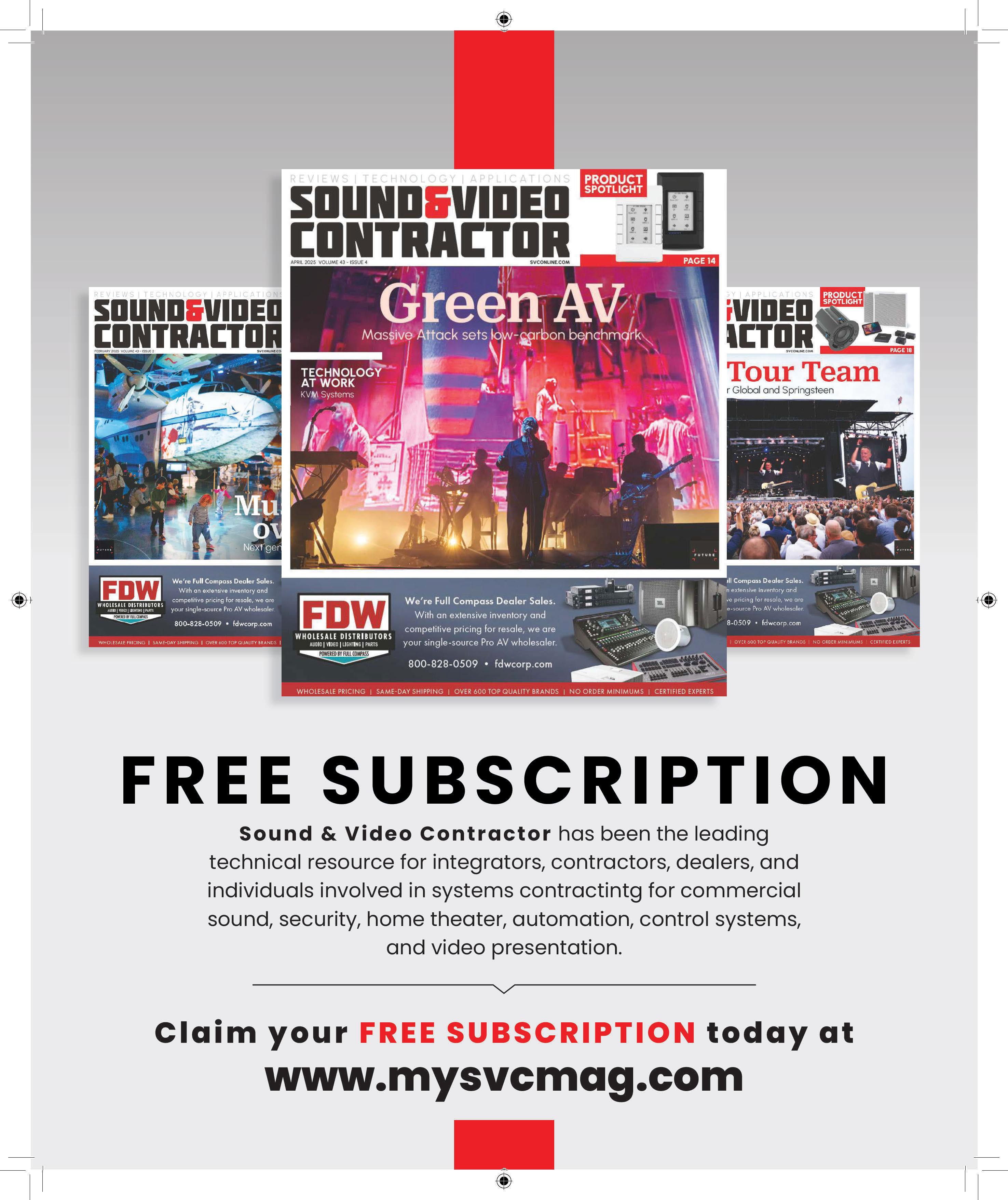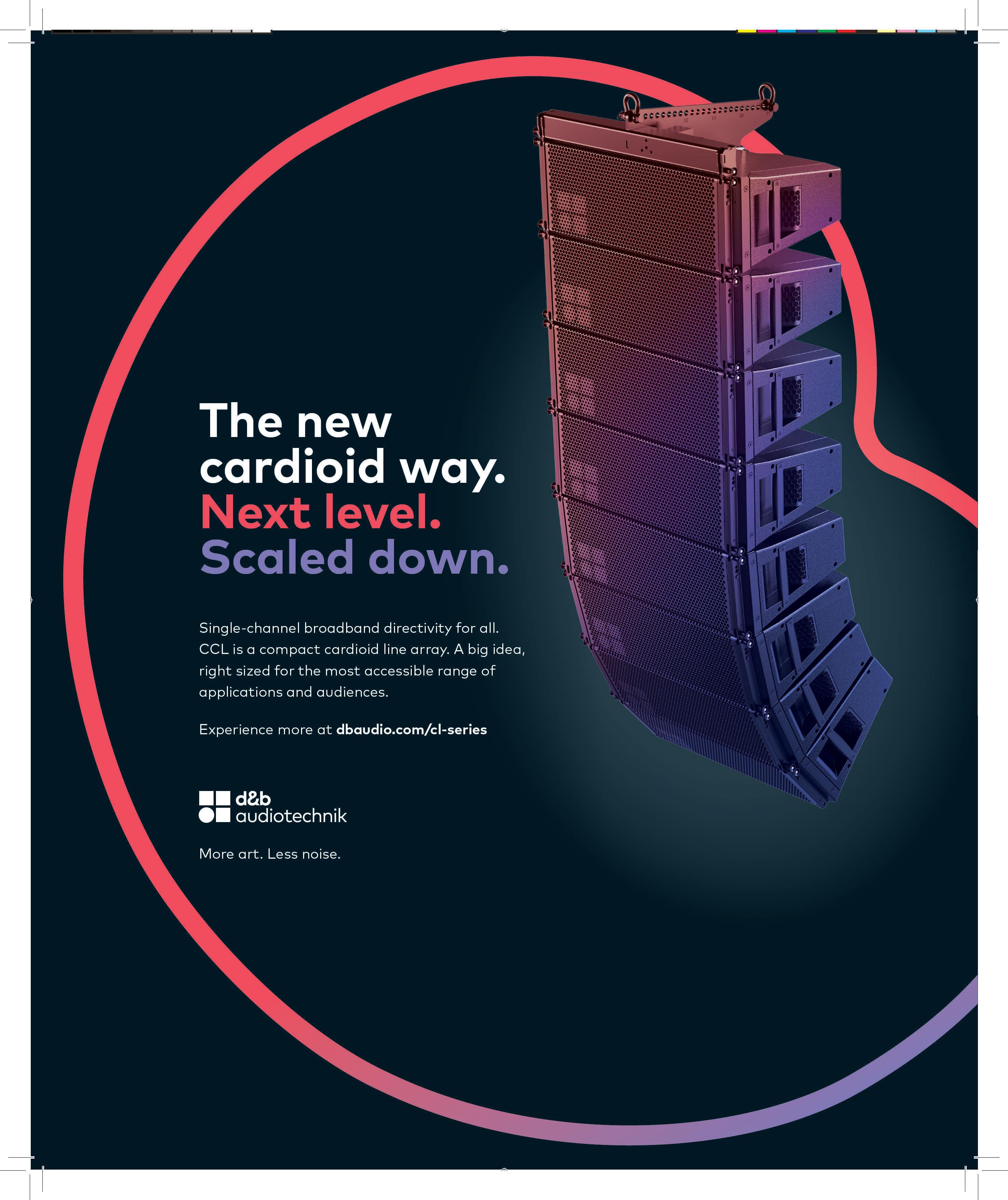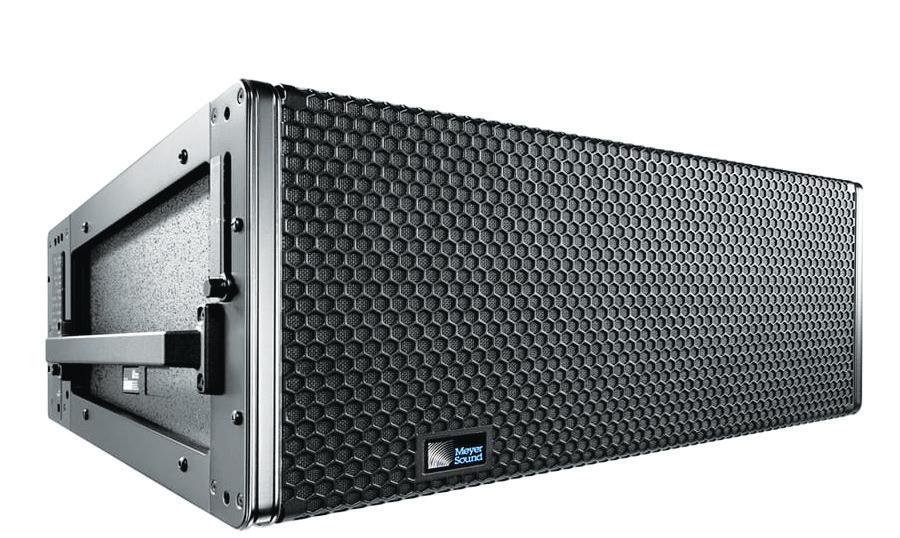




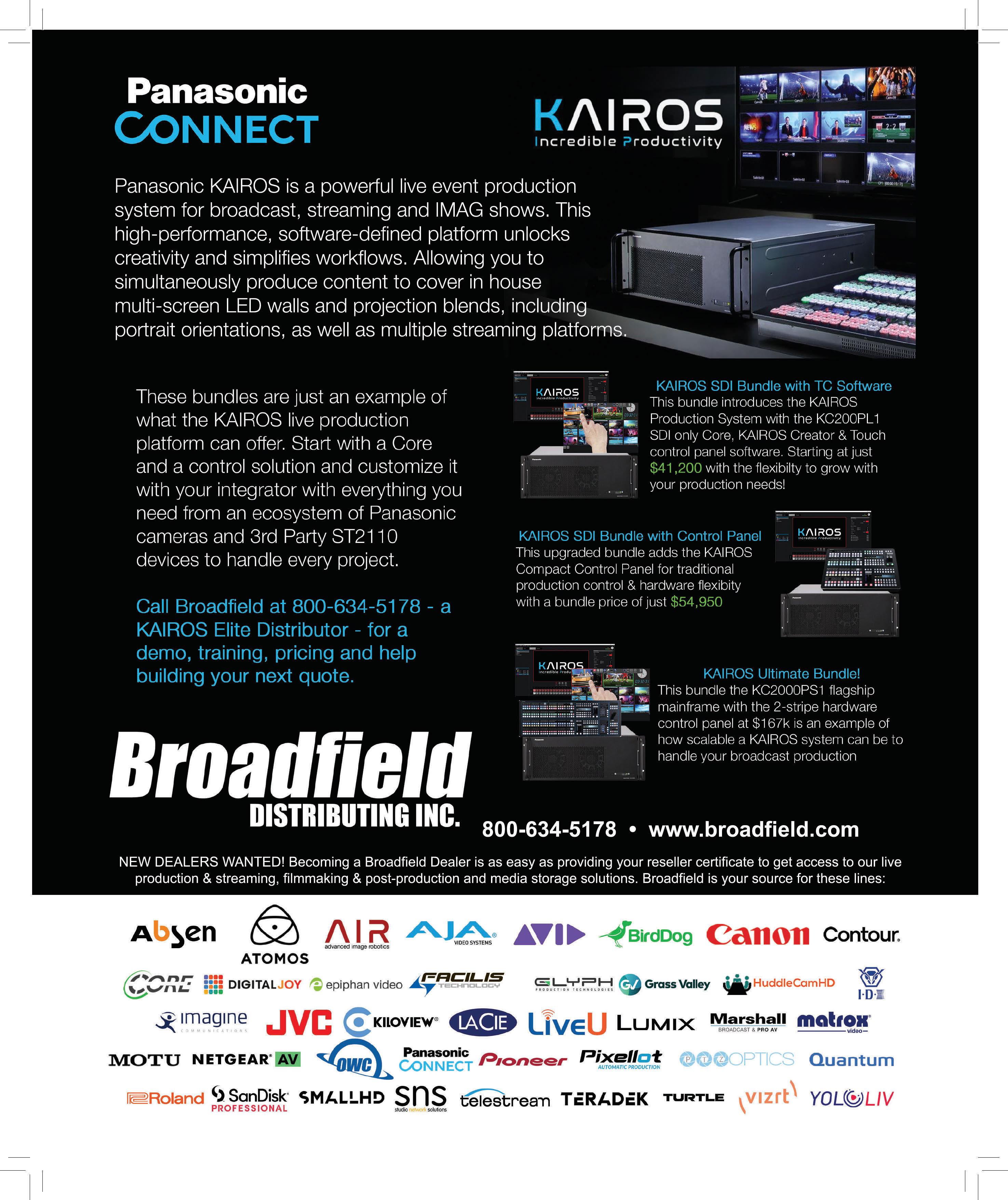
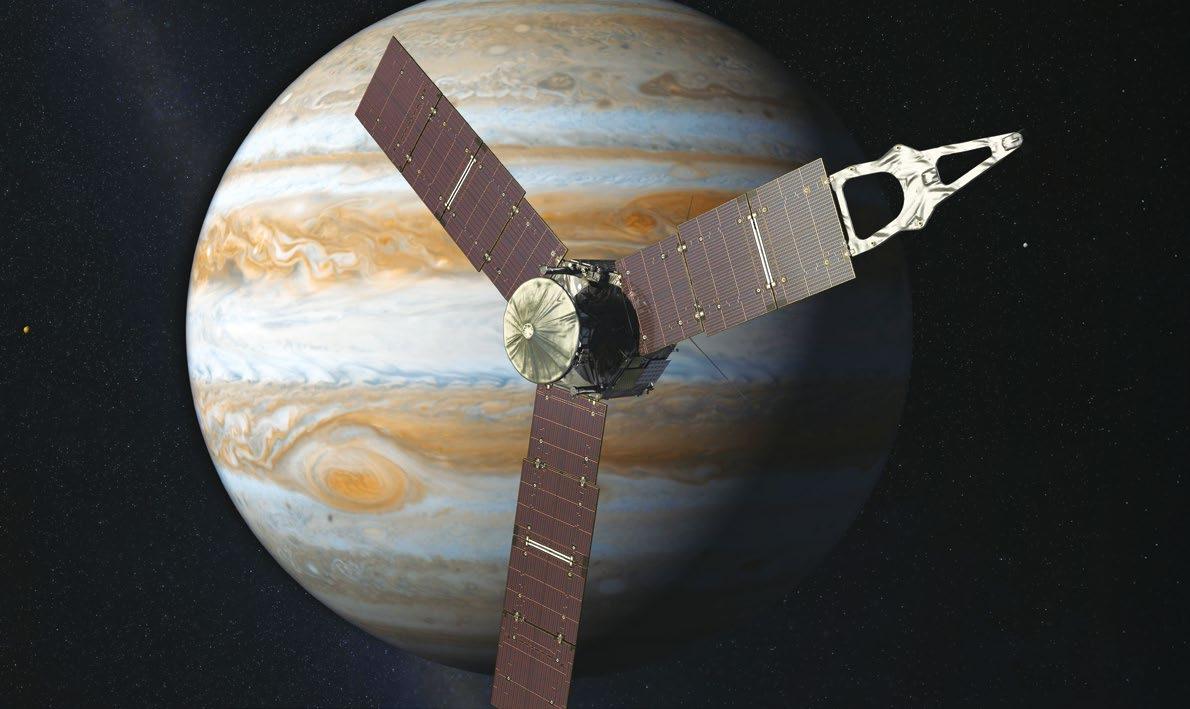
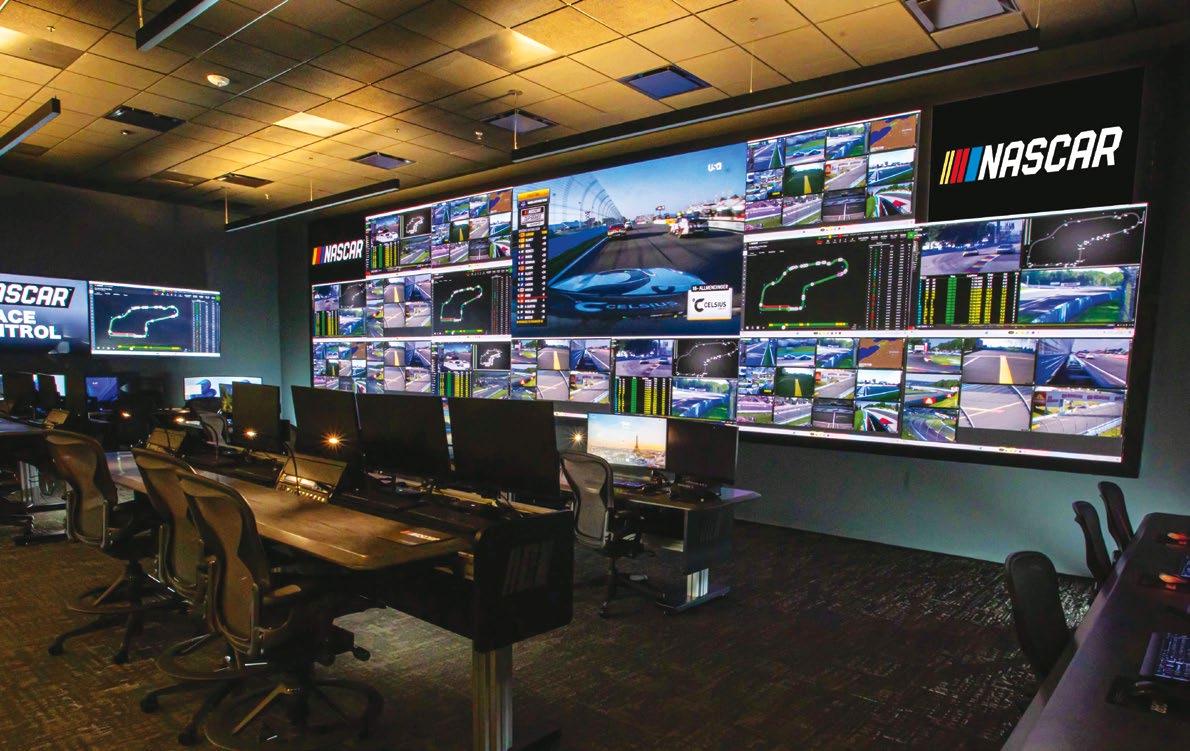

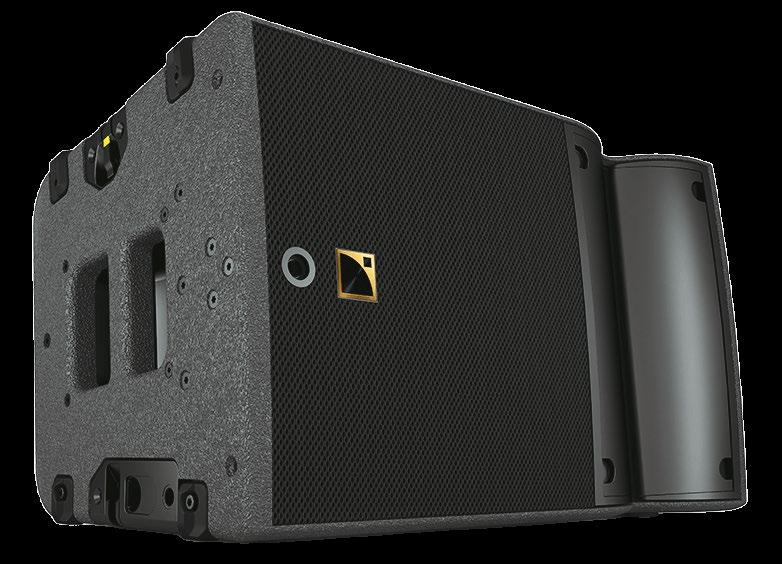
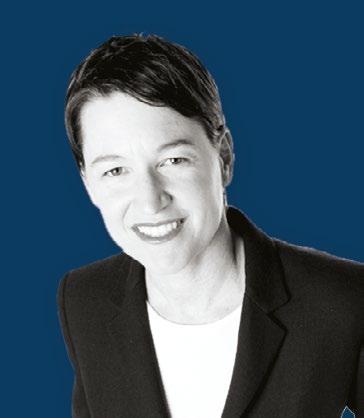
Editor SVC
If I think back over many years in AV, I notice something. My most memorable experiences have something in common: spatial audio. Even an anechoic chamber is in its way spatial. In 2011, standing on the Yamaha booth in headphones when the Dan Dugan automixer card debuted felt “spatial” in the way it shaped the audio space in my head and vanished the distractions.
I remember one Meyer demo that was set up to be like a nightclub (I think it might have been for LEO?) where I had that experience of hearing the music at full resolution but still being able to hear the person standing next to me. That’s not spatial in the electronically manipulated sense, but to me, it was a powerful reminder that all audio is spatial, it’s just whether it’s shaped by intention or accident. That shape has an impact on the audio experience, and it also affects the relationships among the people sharing the room.
One my top three most significant AV adventures was of spatial audio. In 2011, I sat with Meyer’s Steve Ellison as the Cirque du Soleil team mixed the Kodak theater for Iris. A Meyer Constellation system had been installed to help bring life to the dry broadcast soundstage, which wasn’t just neutralizing reflections; it was also neutralizing the performer/audience interaction.
In that long evening, I understood a part of spatial audio that is about more than the thrill of having audio move about a room or shape a space. Those things are amazing and I love them. But there’s something else too. Active acoustics and spatial audio change how it feels to be in community. For the Cirque du Soleil performers, the Kodak’s bone-dry atmosphere was killing the clowns because it was inhibiting the audience. People couldn’t hear each other laugh, so they didn’t laugh. They felt alone and vulnerable if they reacted. They weren’t getting cues from their fellow participants. They were isolated in a room packed with people.
In the 14 years since that special evening, a lot has happened in spatial technologies—I’ve been able to hear d&b Soundscape and L-Acoustics L-ISA in a wide variety of demos and settings. Holoplot at Sphere. Steve Ellison got to bring Spacemap Go to fruition at Meyer. For me, this development is quite magical both as science and art.
So, when it came time to do our October Worship Issue, I started to wonder about spatial audio in church, where community is everything. I went looking for examples and I found them. Not surprisingly, in each case, the users made the same point: these technologies drew people in and drew people together. Once you experience that you can’t unhear it, and you don’t forget it.

WWW.SVCONLINE.COM

FOLLOW US @SVC_Online
https://www.facebook.com/svconline
CONTENT
Content Director Cynthia Wisehart, cynthia.wisehart@futurenet.com
Associate Content Director Derek Wiley, derek.wiley@futurenet.com
Contributors Bennett Liles
Art Editor Rob Crossland, Sam Richwood Production Managers
Nicole Schilling, Heather Tatrow
ADVERTISING SALES
Managing VP of Sales, B2B Tech
Adam Goldstein, adam.goldstein@futurenet.com, 212-378-0465
Sales
John Casey, john.casey@futurenet.com, 845-678-3839
Janis Crowley, janis.crowley@futurenet.com, 845-414-6791
Debbie Rosenthal, debbie.rosenthal@futurenet.com, 212-378-0465
Zahra Majma, zahra.majma@futurenet.com, 845-678-3752
SUBSCRIBER CUSTOMER SERVICE
To subscribe, change your address, or check on your current account status, go to www. mysvcmag.com and click on About Us, email futureplc@computerfulfillment.com, call 888266-5828, or write P.O. Box 1051, Lowell, MA 01853. LICENSING/REPRINTS/PERMISSIONS Sound & Video Contractor is available for licensing. Contact the Licensing team to discuss partnership opportunities. Head of Print Licensing Rachel Shaw, licensing@futurenet.com
MANAGEMENT
SVP, MD, B2B Amanda Darman-Allen VP, Global Head of Content, B2B Carmel King MD, Content, AV Anthony Savona
Global Head of Sales, Future B2B Tom Sikes Managing VP of Sales, B2B Tech Adam Goldstein
VP, Global Head of Strategy & Ops, B2B Allison Markert, VP, Product & Marketing, B2B Andrew Buchholz
Email cynthia.wisehart@ futurenet.com
Website https://www.svconline. com/circuit
Instagram https://www.instagram. com/svconline/ X (formerly Twitter) @SVC_Online
https://x.com/ SVC_Online
LinkedIn https://www.linkedin. com/groups/2757484/

Ironically, I grew up attending a church that had no audio reinforcement other than the architectural properties of adobe clay and clever colonial architecture. As a kid, I didn’t realize that the Mission Santa Barbara was acoustically great; I just knew how it felt and took it for granted. I attributed the feeling to the gathering of people and the fun of watching my dad’s band play at the folk mass or hearing the choir at the Latin high mass my grandmother preferred. Good acoustics, and now spatial audio, are tools to make that human creativity connect in, to wrap around people, and move them. I think those types of audio experiences have been some of the most powerful forces of human history, and I’m not being hyperbolic. I notice it now because it’s now in such contrast to the toxic elements of our binary online public spaces. Three-dimensional audio in a shared space is a timeless healer when you think about it. When you hear it, you know that in your bones. And
Head of Production US & UK Mark Constance Head of Design, B2B Nicole Cobban FUTURE PLC 130 West 42nd St., 7th Floor, New York, NY 10036


NASA fixes Juno’s camera from 370 million miles away
Launched in 2011, the Juno spacecraft is tasked with orbiting Jupiter, taking pictures of the planet and its many moons. Unfortunately, the gas giant’s intense radiation fields are an obstacle for the continued operation of any cameras, and by Juno’s 56th orbit of the planet, nearly all images being sent back to NASA were corrupted. The team was presented with a challenge: how to fix a camera 370 million miles away. NASA explained how they did just that last month at the Institute of Electrical and Electronics Engineers Nuclear & Space Radiation Effects Conference in Nashville.
With few options for recovery, the team turned to a process called annealing, where a material is heated for a specified period before slowly cooling. Although the process is not well understood, the idea is that the heating can reduce defects in the material.
Test images sent back to Earth during the annealing showed little improvement the first week. Then, with the close approach of Io only days away, the images began to improve dramatically. By the time Juno came within 930 miles of the volcanic moon’s surface on Dec. 30, 2023, the images were almost as good as the day the camera launched, capturing detailed views of Io’s north polar region that revealed mountain blocks covered in sulfur dioxide frosts rising sharply from the plains and previously uncharted volcanos with extensive flow fields of lava.
https://tinyurl.com/yc776v6x

Writer DEREK WILEY Associate Content Director
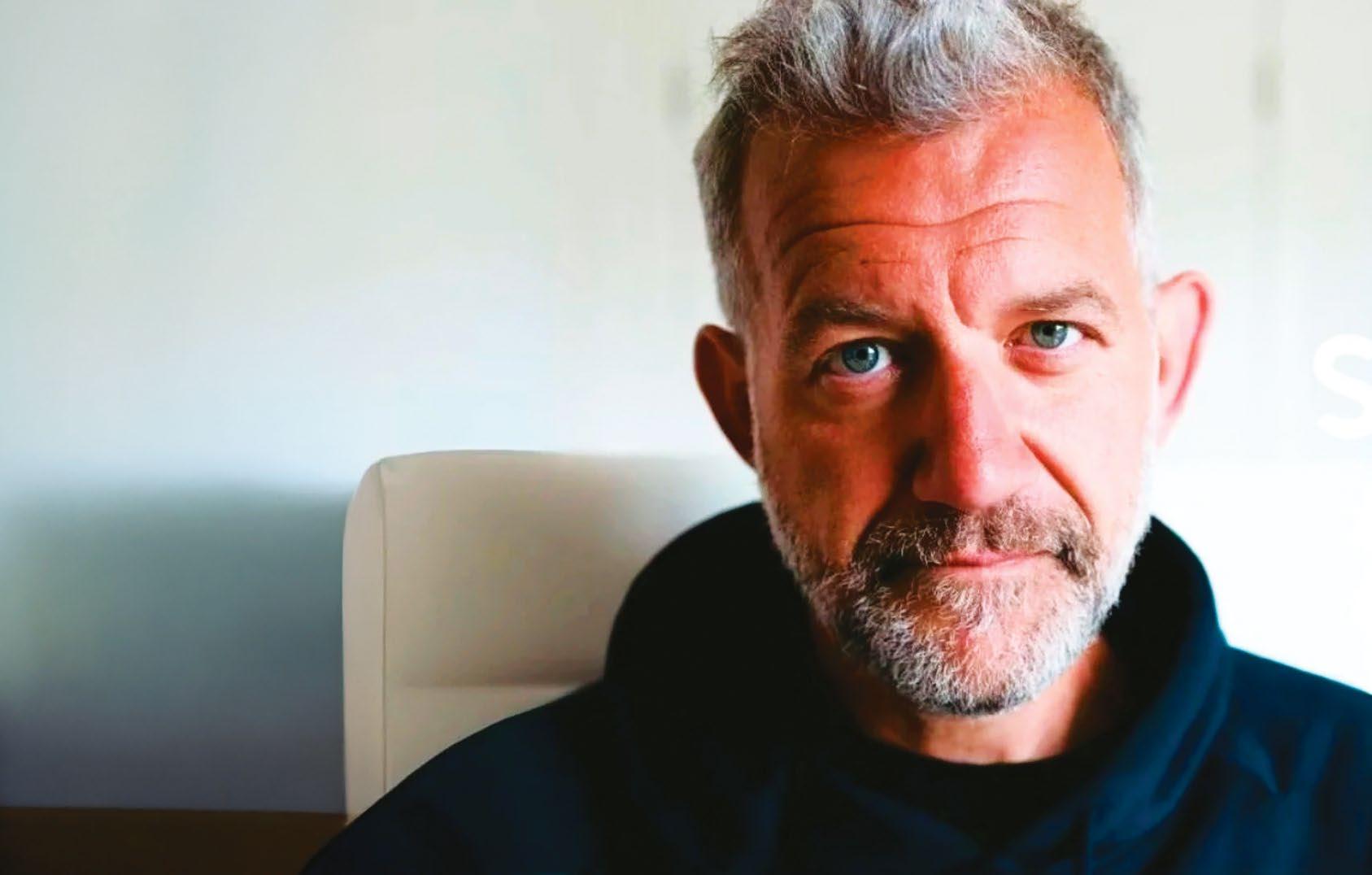
Sonos appoints Tom Conrad as Chief Executive
Officer
Sonos, Inc. has announced that the Sonos Board of Directors has appointed Tom Conrad as Chief Executive Officer effective immediately. Mr. Conrad, who has served as Interim CEO since January of this year, will remain on the Board of Directors.
“Following a comprehensive and competitive search, the Board is confident that Tom is the best person to lead Sonos into its next chapter of delighting customers, spearheading innovation, and driving growth,” said Julius Genachowski, Chair of the Board.
“Over the past six months, Tom has earned the confidence of our employees, customers, partners and shareholders by restoring urgency and a deep commitment to delivering ever-improving experiences. He has a compelling vision for Sonos’ future, with strong plans to harness technology to benefit our customers, as AI and other advances reframe the landscape and unlock new opportunities. We’re energized by what Sonos’ next chapter holds for all our stakeholders.”
https://tinyurl.com/y2v86snx
ATEM Mini Extreme ISO G2 makes it easy to create professional multi camera productions for live streaming! Simply connect ATEM Mini Extreme and you can live switch up to 8 high quality video camera inputs for dramatically better quality images. You can even sync your recording to Blackmagic Cloud, so you can edit your live production with DaVinci Resolve anywhere in the world!
ATEM Mini Extreme ISO G2 is not just a switcher, it’s also a shared network disk using the 10G Ethernet port to the internal CFexpress memory card or external USB disk! CFexpress cards are extremely fast so they can keep up with recording multiple ISO video files while external network users all work on separate computers for editing, color correction, VFX and audio post production.

The ATEM Mini Extreme ISO G2 is ideal for building a high-end broadcast studio as it offers all the ATEM Mini features plus extra features! It has a professional style control panel with amazing input buttons. It has 3 independent video outputs that can be routed. The built-in Thunderbolt offers live video capture and playback, enabling real-time effects software or live action replay.
Blackmagic Replay uses the ISO files recorded by ATEM Mini Extreme ISO G2 to do replay in DaVinci Resolve. The ISO files are recorded to a CFexpress card which DaVinci can access via Ethernet. You can use multi-view in the cut page to view all cameras in DaVinci Resolve at the same time. The files will even continuously upload as you’re recording so you can edit live!
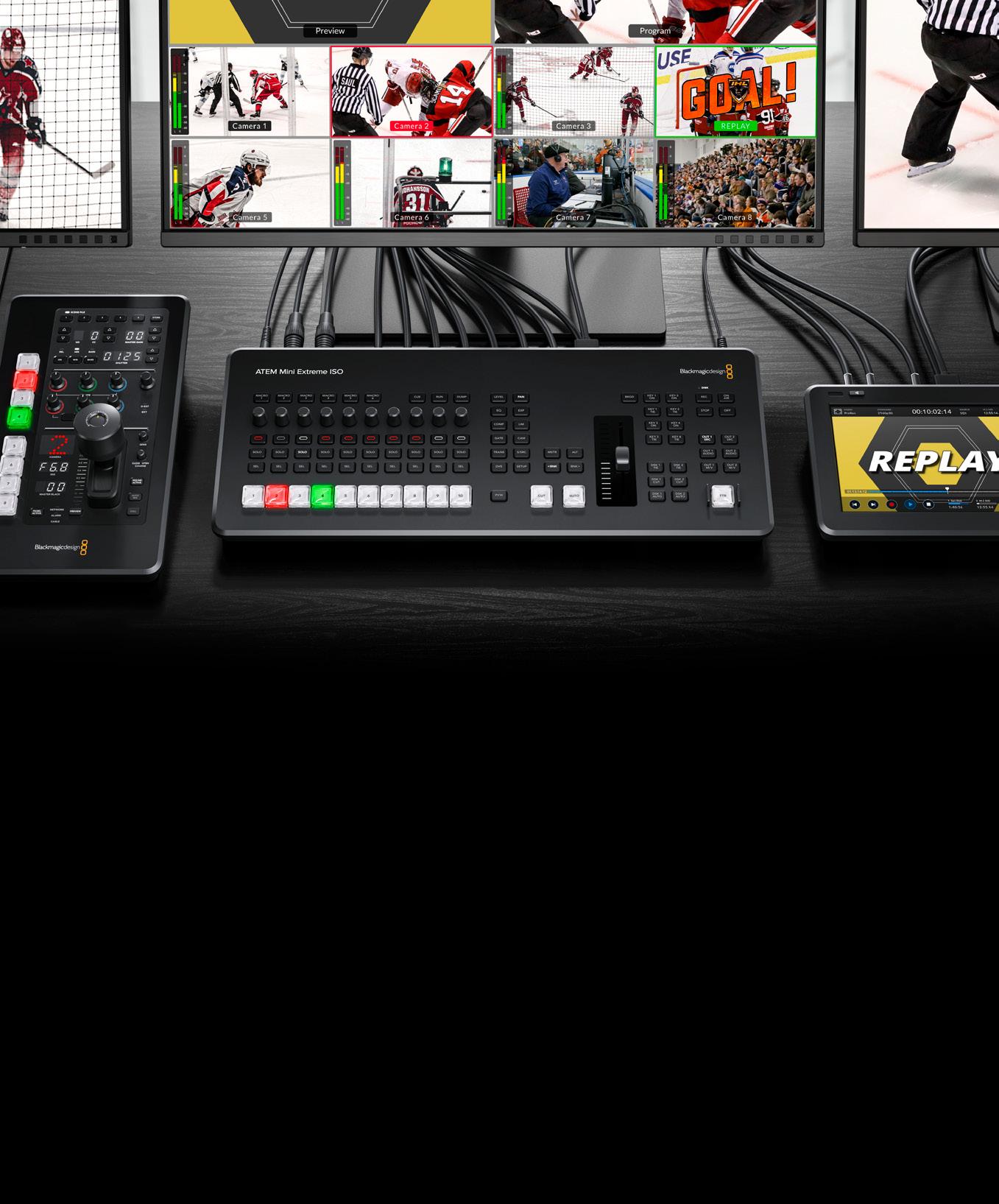
The front panel has buttons for selecting sources, triggering transitions, and setting video effects. It also features an innovative audio mixer control area with live metering on a Fairlight style HDMI status output. You get buttons for recording, streaming, and dedicated output buttons for changing outputs between the 8 cameras, program, preview, multi-view, or Fairlight status.
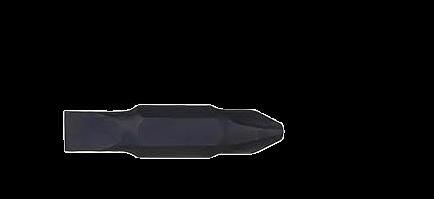

4Samsung Display filed a complaint with the U.S. International Trade Commission (ITC) in 2023, alleging that BOE had infringed on several of the company’s patents relating to proprietary OLED technology. In July of this year, the ITC issued a preliminary ruling in favor of Samsung, stating that BOE had misappropriated trade secrets, “the importation of which has injured and threatens to substantially injure a domestic industry in the United States.”
During a conference call with investors in January, Executive Vice President of Samsung Display Choi Kwon-young said, “We have accumulated numerous patents and know-how through decades of investment, research and development, and mass production. In
The NexTool W4 brings a new idea to the standard split-handle multitool format by, at its core, being an adjustable ratchet wrench. It packs in ten other tools, including the pliers that a wrench multitool typically sacrifices, while still being pocket-friendly – the W4 measures slightly over 6-inches while closed.
The wrench’s push-button ratchet design allows users to select between standard and ratchet turning to eliminate the need for resetting one’s grip each turn, while other conveniences include a bit holder, driver, steel knife, and 2-in-1 needlenose pliers. While the W4’s entire package might not be quite as versatile as some other multitools on the market, building its design around an adjustable ratcheting wrench puts it in a category of its own.
The NexTool W4 multitool is available now for $59.99.
https://tinyurl.com/4zpm7npa
order to protect our differentiated technologies and increase their value, we are actively promoting our hard-to-mimic OLED technology to the market. At the same time, we are taking various in-depth measures to recognize the legitimacy of the intellectual property rights accumulated through the efforts of our employees.”
Per the initial ruling, the ITC is issuing a ban on the import of BOE’s OLED panels for 14 years and eight months, in addition to a “cease and desist” to any and all of BOE’s US subsidiaries. While the final ruling is scheduled for November, it is uncommon for the ITC to overturn an initial ruling.
https://tinyurl.com/mr2fcfv5
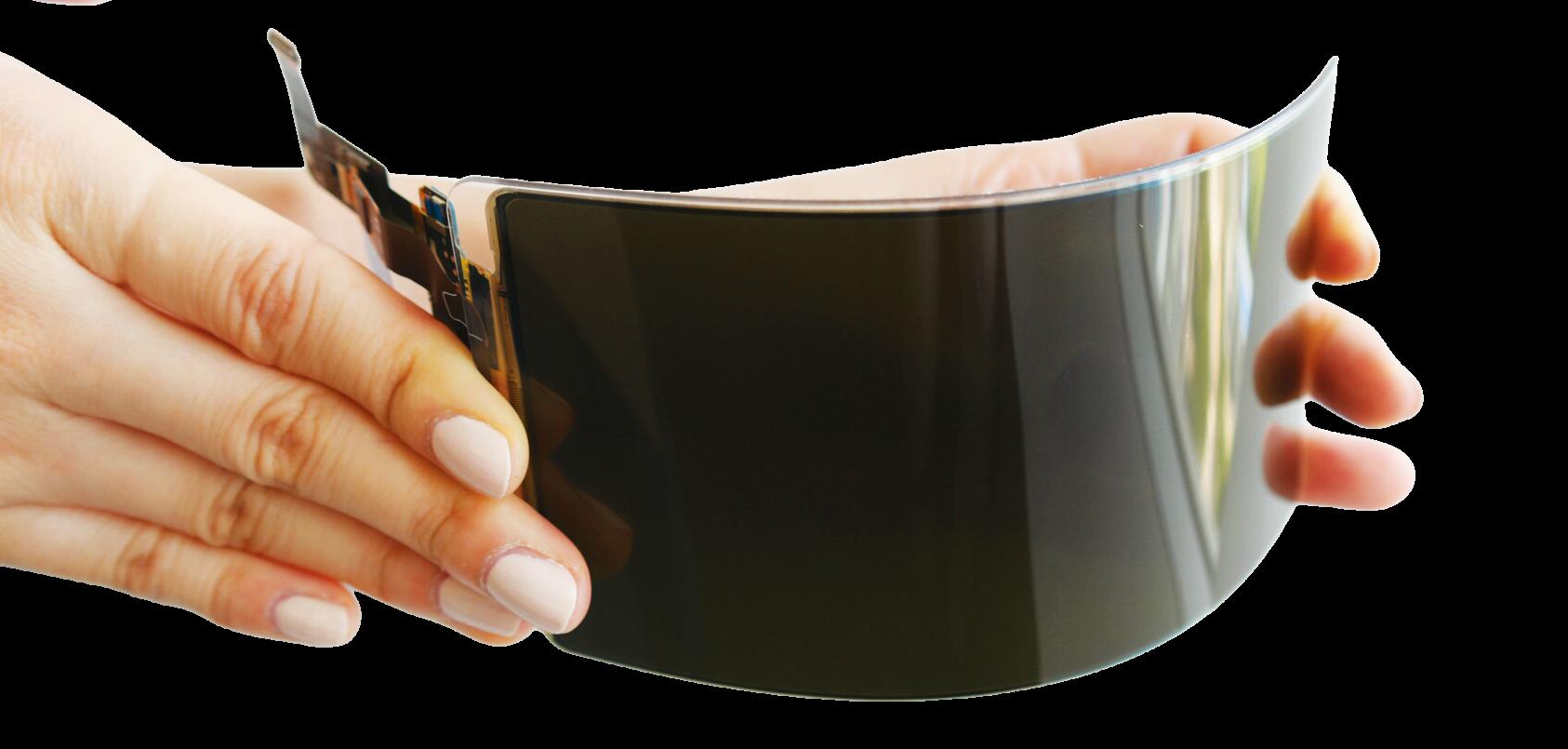
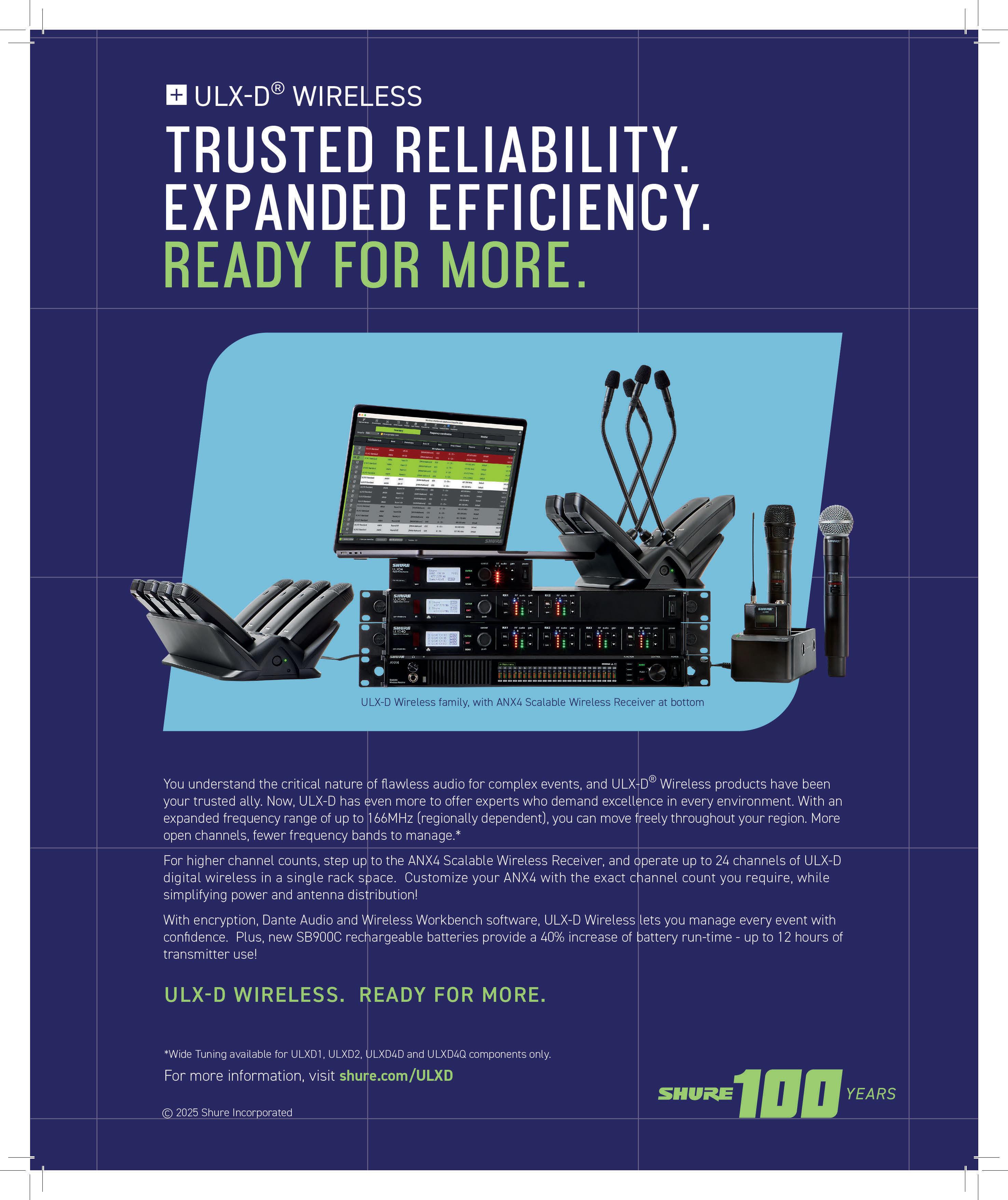
Vertical turntable uses an optical pickup to play vinyl

Netherlands-based Miniot has debuted the third iteration of its Wheel turntable, and the company claims that this version takes the vertical player’s concept and pushes it to its limits. It’s easy to see why, as the Wheel 3’s minimalist design is taken to the extreme, with a tonearm that sits inside the platter for unobscured viewing of the chosen vinyl record.
A new addition to the Wheel 3 is an optical pickup, replacing the traditional magnetic design. A diamond stylus tracks the grooves on the record, while the optical pickup measures the amount of light and shadow to track the position of the stylus.
“Unlike magnetic pickups, which measure acceleration, an optical pickup measures position, allowing it to ‘see’ sound all the way down to 0 Hz,” says Miniot. “Because it also continuously compares stylus and arm position measurements, it is pitch perfect from the first note.”
The company says that the pickup is complimented by a “bespoke, high-end preamplifier,” while the direct-drive motor features 24 neodymium magnets and five optical sensors. The Wheel 3 can be operated on its table stand or wall-mounted via a recessed slot on the back https://tinyurl.com/2td2x3ay
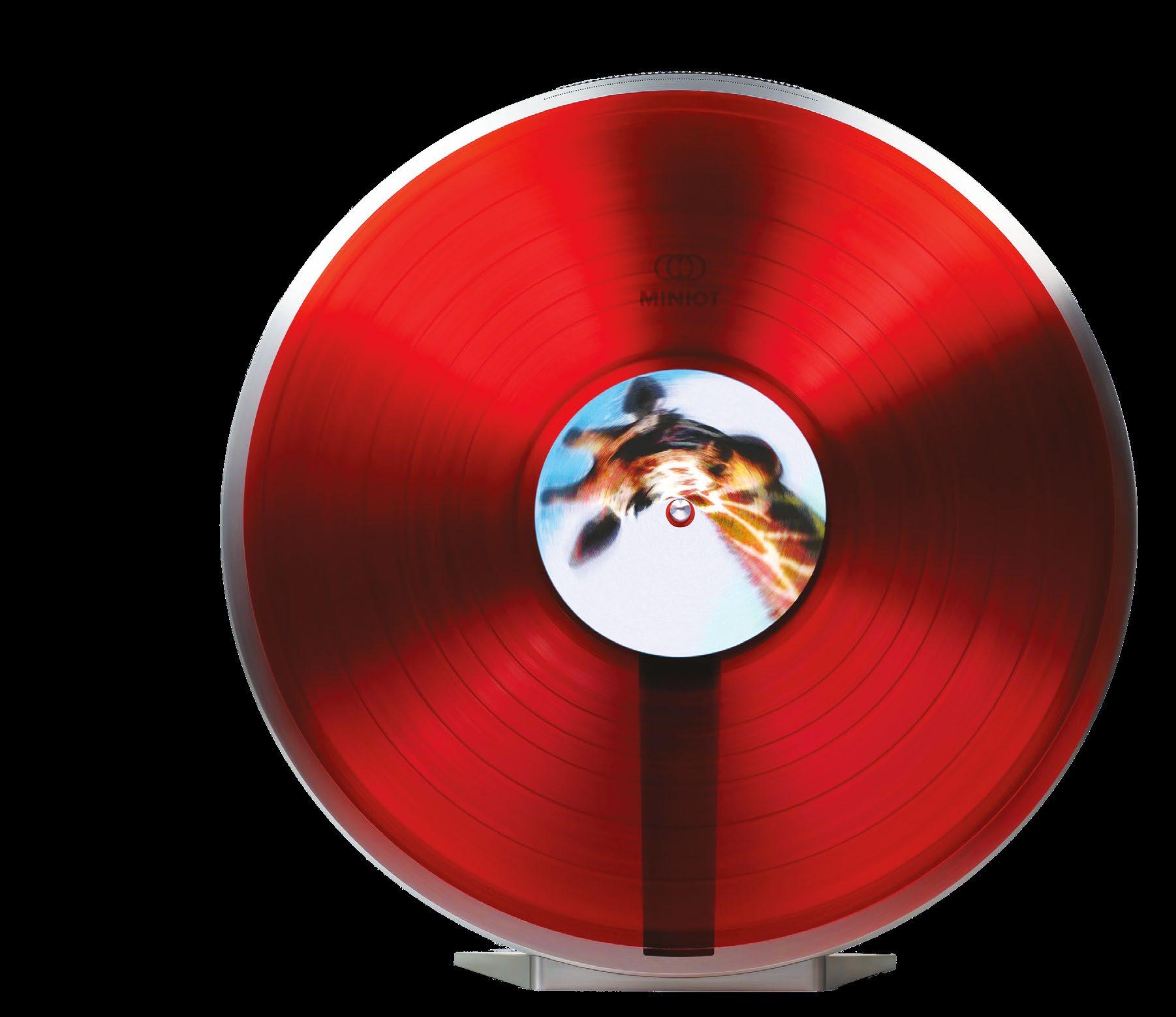
6Assembly Studios, the heart of the newly developed Assembly Atlanta, is a film and television production hub redefining the entertainment landscape in Georgia. Located in Doraville, just inside the Interstate 285 perimeter, this state-of-the-art studio offers world-class sound stages, stunning exterior locations and comprehensive production services, all within a single, versatile campus. Designed to provide Hollywood-level amenities in the heart of Atlanta, Assembly Studios is an expansive development including 22 high-tech studios, realistic city facades and office spaces, along with public attractions such as parks, an amphitheater and picturesque ponds.
Atlanta has partnered with Tucker-based material supplier Cofer Brothers, Norcross-based LED manufacturer Nanolumens and Lilburn-based visual solutions provider Capital Sign, among many other local companies. One of the project’s most striking features is the iconic LED tower, designed and manufactured by Nanolumens. Soaring 140 feet high, it stands as the largest freestanding LED screen in North America. Positioned at the studio’s entrance, it welcomes visitors and captivates commuters along Interstate 285.
To bring this vision to life, Nanolumens partnered with Capital Signs, which managed the LED wall installation and contributed to the surrounding architectural elements. The display is housed within a distinctive, egg-shaped metal shell that wraps around the triangular structure, forming a bold, spine-like design crafted by Capital Signs. https://tinyurl.com/2udfa34u
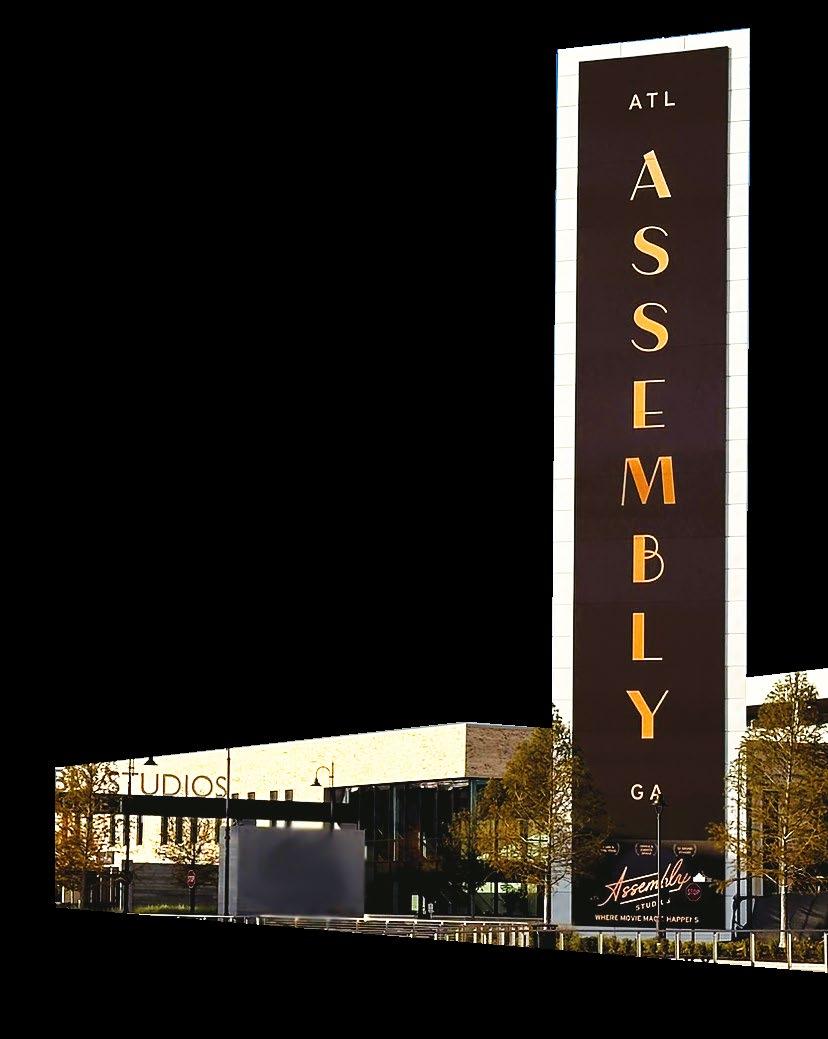
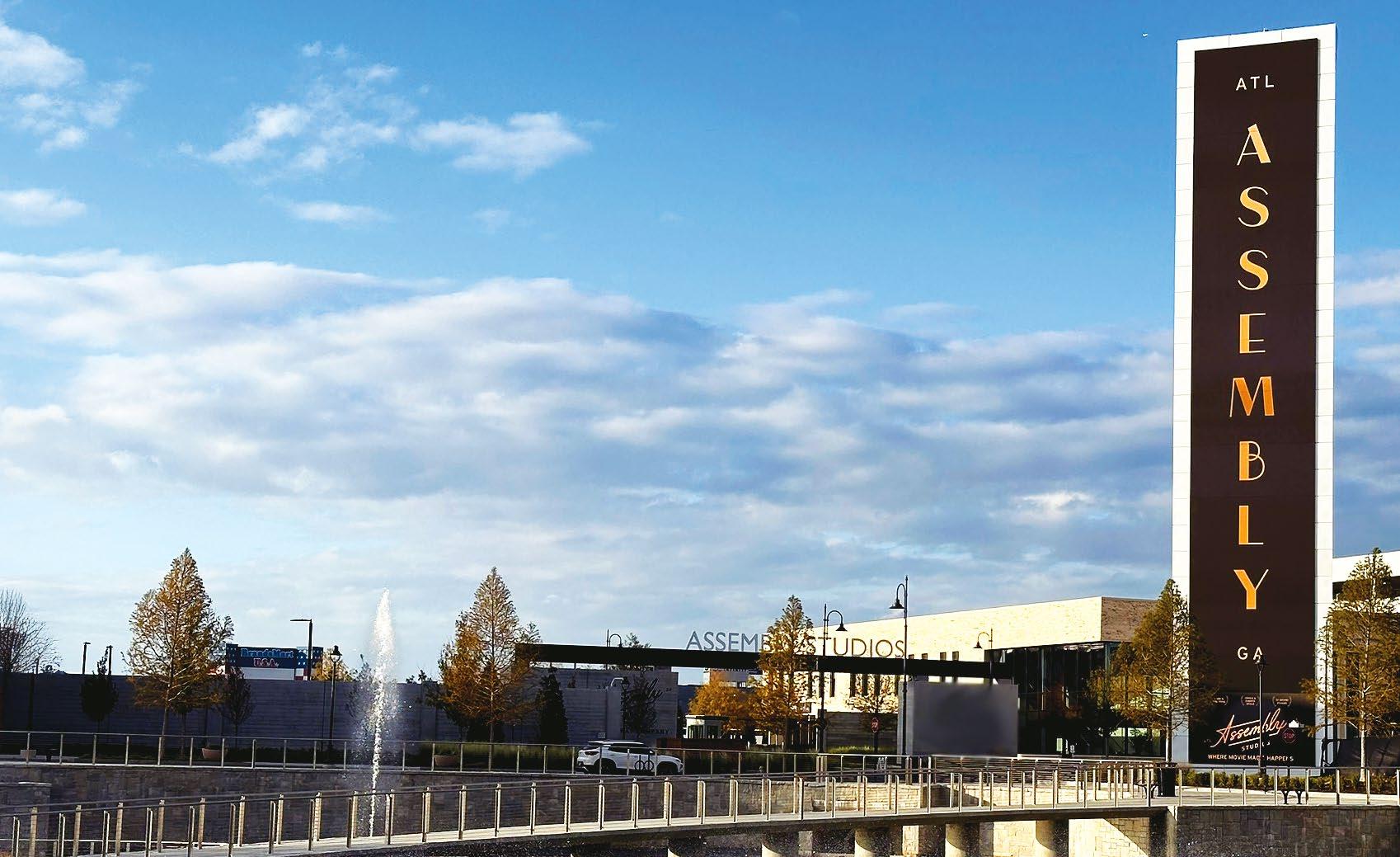
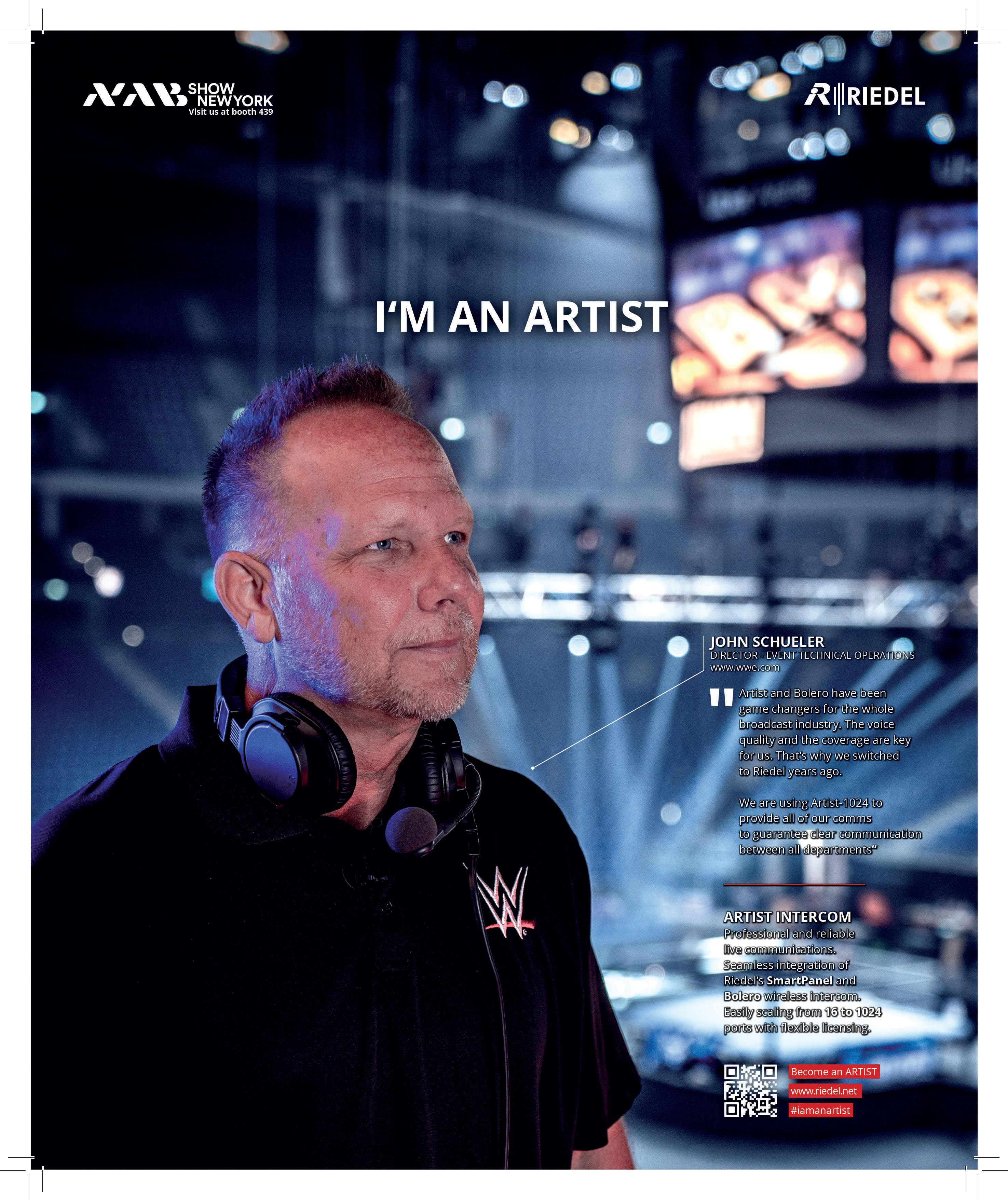
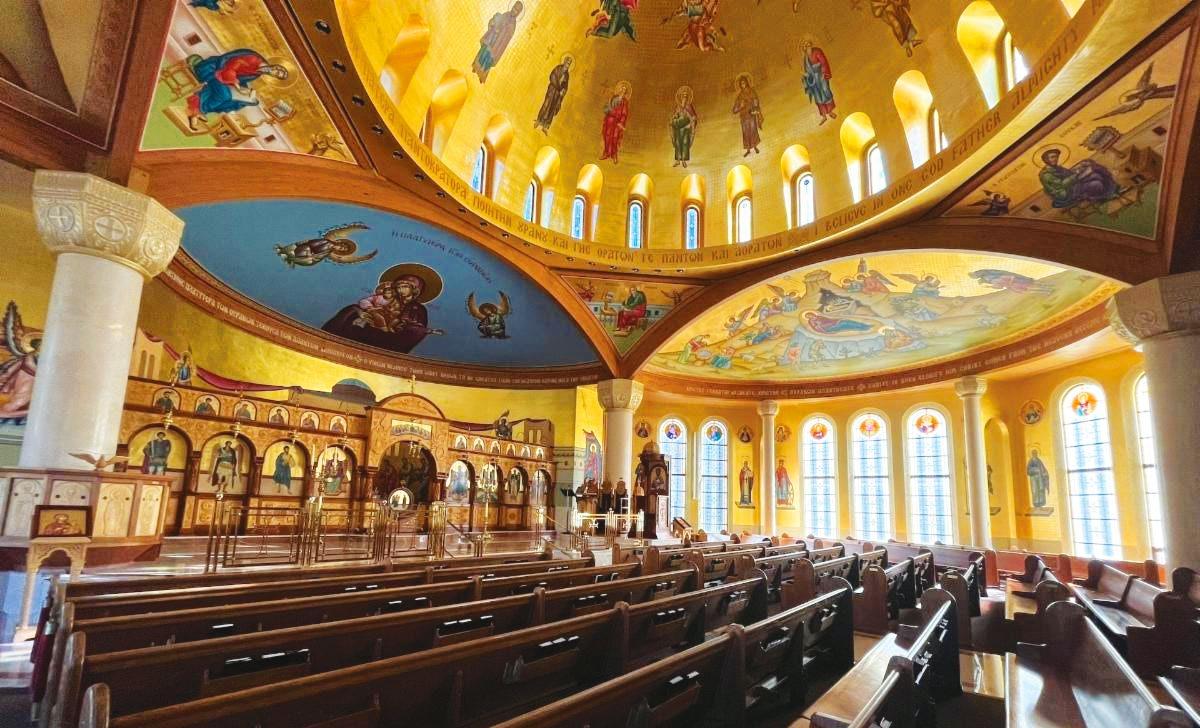
Pennsylvania’s St Luke Greek Orthodox Church is known for its breathtaking Byzantine architecture and elaborate iconography.
The church serves as a spiritual and cultural hub for its congregation, offering a space where the community gathers for worship, celebration, and reflection. With its high-domed ceilings, expansive nave, and traditional Orthodox design, the sanctuary is visually stunning but posed significant acoustical challenges. A sound reinforcement system from Renkus-Heinz solved those challenges.
Poor speech intelligibility had become a growing concern, making it difficult for worshippers to fully engage with Fr. Christ. With a reverberation peak of 3.38 seconds, congregation members struggled to hear the spoken word clearly, leading to increased complaints. Seeking a solution that would preserve the church’s aesthetic and elevate the auditory experience, the team at Spinnaker, the project integrator, led by VP of Project Development Fenicia Redman, selected Renkus-Heinz following extensive EASE modeling.
“The congregation was vocal about the issue,” said Redman. “Many elderly members expressed frustration that they couldn’t clearly hear the liturgy. We knew we had to find a solution that provided pristine intelligibility while maintaining the church’s sacred atmosphere.”
To determine the best possible system, Spinnaker conducted an in-depth acoustic analysis using EASE modeling. “The client preferred the Renkus-Heinz solution,” Redman explained. “The natural warmth of the sound was something that truly stood out.” The final installation featured a single Renkus-Heinz Iconyx
Gen5 IC24 column array, discreetly positioned between the front two windows.
“We needed a solution that would blend seamlessly with the church’s visual aesthetics,” Redman noted. “The IC24-RN provided excellent dispersion while being visually unobtrusive.” With Renkus-Heinz’ OmniBeam beam-steering technology, Spinnaker focused sound exactly where it was needed, avoiding the excessive reflections that had previously muddied the spoken word.
The system is powered by a Yamaha MTX5D processor and TF Rack, with simple, intuitive control via an iPad. This allows church staff to easily adjust settings as needed.
While the installation itself was straightforward, a particular challenge was protecting the church’s ornate interior. “The walls are adorned with 24-karat gold leaf,” Redman said. “We had to be incredibly careful during the installation process to ensure nothing was damaged. Our team took meticulous precautions, and in the end, everything went smoothly.”
Another consideration was ensuring that the new sound system complemented the church’s existing acoustics. “Rather than fighting against the natural acoustics, we worked with them,” Redman explained. “The RenkusHeinz system allowed us to reinforce speech while still allowing the beauty of the choral music to shine through. It was about precision rather than force.
“One of the most touching moments came when a senior member of the congregation turned to her grandson and said, ‘I can finally hear Fr. Christ,’” Redman shared. “That’s why we do what we do. Sound is more than just technology; in houses of worship, it speaks hope.”
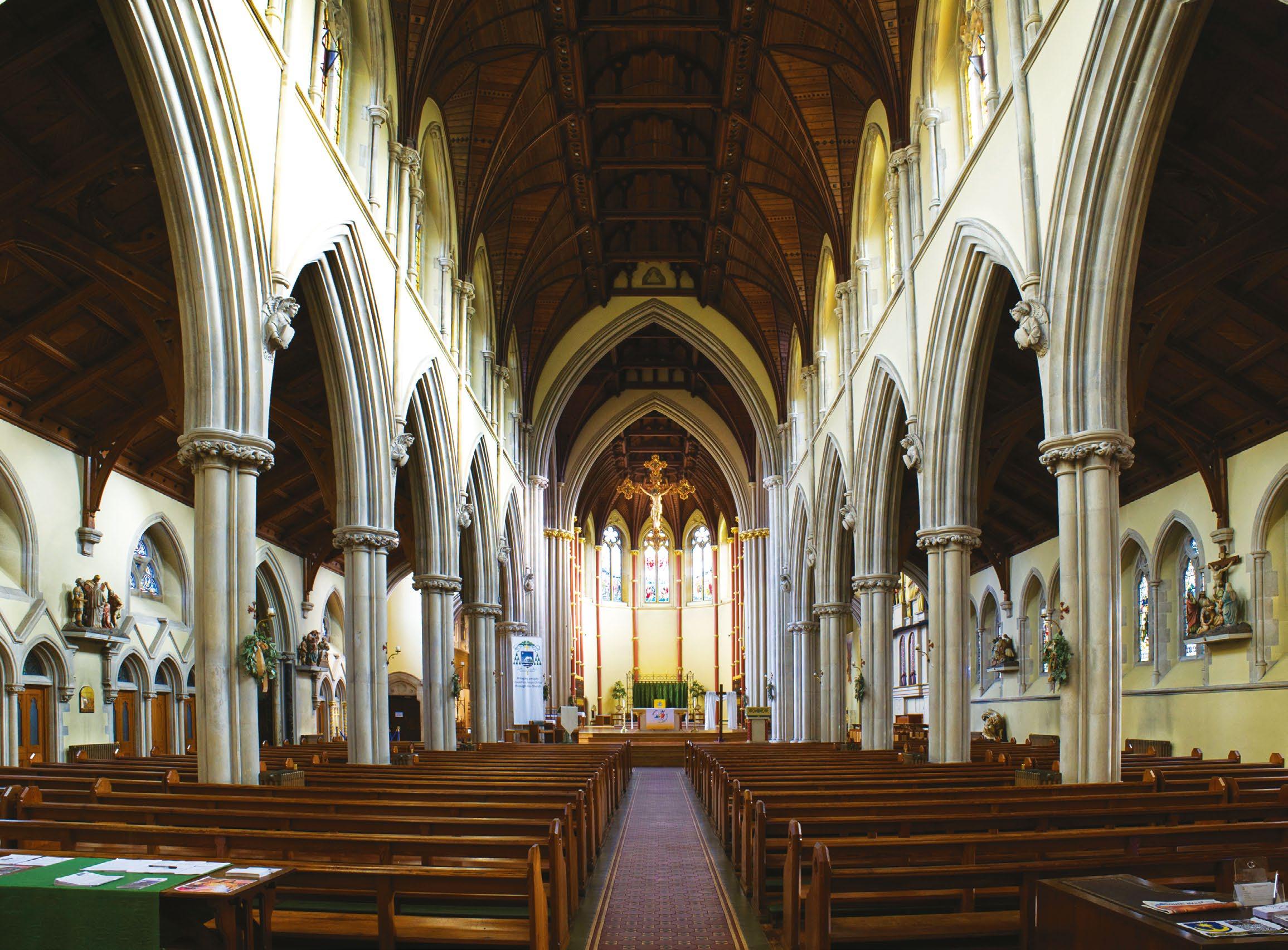
The Cathedral of St John the Evangelist in Portsmouth, UK is the mother church of the Catholic diocese and seat of the Bishop of Portsmouth. An Audio-Technica System 20 PRO digital wireless system was recently installed in the nave, from where services are delivered.
System Design Audio, a church installation specialist, took charge of the process. The installation at St John’s Cathedral involved a 4-channel System 20 PRO ATW-R1440 receiver and two ATW-T1401 bodypack transmitters with lavalier microphones, for use by clergy delivering services from the lectern.
The receiver is mounted unobtrusively on a column some distance from the System 20 PRO half-rack chassis, connected via Ethernet cable to allow for discreet installation without detracting from the church’s aesthetic.
Peter Hearn, audio managing director, System Design, said: “We’ve used Audio-Technica wireless systems in many houses of worship projects over the years, and I was very interested in System 20 PRO as soon as it was launched. We typically need a very robust, reliable, and easy-to-use solution for our
clients, and the license-free nature of 2.4GHz systems is a real benefit too.”
He added: “Despite the size of the cathedral’s nave, a single receiver gives us the best coverage of any wireless system we’ve ever installed at St John’s. When we were testing System 20 PRO, no matter where we roamed with a transmitter, we couldn’t get it to drop out. Installation was incredibly easy. The system is designed to be plug-and-play, and that’s certainly been the case here. Straight from the box, the transmitters and receivers synced with each other, which really inspires confidence in a solution that’s used day-to-day by clergy and other volunteers with no professional audio training.”
He concluded: “There are some other features that really make the System 20 PRO ideal in situations like this. Little touches like the mute switch positioned on top of the body-packs–rather than on the side–make them easy to use by clergy who wear them under vestments, for example. And although we currently have a simple setup at St John’s, the fact that System 20 PRO is scalable up to 20 channels makes it suitable for much bigger installations.”

First Baptist Church of Jonesboro was founded around the same time as its namesake city, now a suburb of Atlanta. You don’t last that long without understanding that things change, and that’s reflected in the recent installation at the church of a pair of DiGiCo Quantum consoles. A Quantum852 has replaced the previous DiGiCo SD10 at front of house, while a Quantum338 is now at monitors. Both were purchased through Atlanta-based integrator Clark.
Like it did for many churches, Covid changed everything. First Baptist Jonesboro Media & IT Director Tom Gobebo points out that the church’s traditional orchestral/organ and choir worship style was expanded in the wake of the pandemic to include electrified instruments, as well as backing and click tracks. Along with more outside concerts and increasingly complex holiday event productions, the channel count and processing needed to follow suit. First Baptist Jonesboro became the world’s first house of worship to install a Quantum852, which came along at the perfect time.
“The 144 channels on our SD10 were no longer enough,” says Gobebo, whose arrival there coincided with the pandemic, a pivot point for the church’s media infrastructure. “We already had a 30- to 40-piece orchestra and an 80- to 100-voice choir, and that was just for regular Sunday services. We added more wireless microphones as well as a sixpiece band with electric guitars and drums,” which currently share worship
music duties with Jonesboro’s 3,000-pipe organ.
Further, the church at that time also changed how it handled its online streaming of services, making them fully live and thus requiring additional channels. That’s where the Quantum852 was the game-changer. “We have literally more than doubled our inputs now, and that leaves us lots of extra channels for special events when needed,” says Gobebo.
The Waves processing that was integrated into the SD10 consoles is still there, but now split between the new desk’s A and B engines, adding a layer of failover protection. And the processing load has shifted to the console, itself. “Before, the SD10 was doing about 40 percent of the processing onboard; today, the Quantum852 is doing about 80 percent of it,” he estimates, pointing to the desk’s Mustard Processing channel strips, Spice Rack plugin-style native FPGA processing options, and Nodal Processing. The church also doubled the number of stage boxes, as well, adding two more SD-Racks, allowing up to 220 inputs at the stage. And they are currently operating the church’s audio at full 96k resolution, up from 48k before.
Gobebo likes having three screens on the console, for operating and training, and all that IO means as many as 21 of the vocalists can now be on stereo IEMs, with wedges for the choir. “With the Quantum338, all the patching can be done internally in the console.”

One Church Home in Fairview, Tennessee, demonstrates the impact an investment in AVL technology can have on a ministry. When they moved to a new home, the church built an enviable arsenal–a d&b audio system, including Yi8 and Yi12 line arrays; KSL subs, 44S fills, and 40D and 10D amplifiers; and a DiGiCo SD10 digital mixing console. QSC handles the distributed audio with Q-SYS control. Lighting is managed through a GrandMA 3 Compact lighting console and Elation Fuze pendant house lights. The video setup features Blackmagic Design URSA Broadcast G2 cameras with Fujinon XA20 lenses, URSA studio viewfinder G2, ATEM 2ME Switcher, ATEM CCU, and a squareV Vi 2.9 LED wall.
To ensure that this investment was protected with reliable power control and management, One Church Home partnered with AV integration company Integrated Production Solutions (IPS), which specified LynTec’s power control solutions.
With the lineup of cutting-edge AVL equipment, power sequencing and management were paramount. The church needed to sequence on and off and control a large amount of power for these systems from multiple locations within the church — the control room, front of house, and electrical room.
The team understood that a power control and distribution system purpose-built for AVL can protect from power surges and prevent systems from being left on, which can generate damaging heat, as well as mitigate start-up inrush currents from electronics, including video walls. A pro system can also reduce the wear and tear that happens when users use their
breaker panel to turn systems off — a practice that organizations aren’t aware can have costly consequences. Likewise, just one circuit turned on out of sequence could spell downtime and expensive repairs for a system.
With these considerations in mind, IPS has standardized on Lyntec. For the One Church Home system, the company installed a flagship 65-breaker LynTec RPC and two XRS-20 for remote power sequencing. The RPC is designed to speed installation and decrease operating costs with simple wiring that eliminates a separate relay panel. Available with 30 to 84 controllable breakers per panel, the comprehensive power control solution provides additional circuit-switching control capabilities in the same enclosure and grants flexible lighting control across multiple zones and control protocols, including HTTP, Telnet, sACN, DMX, RS-232, or contact closure control systems.
With LynTec’s web-enabled control and monitoring, every circuit of the church’s system can have its own delay setting. With one button, the crew can power on every piece of equipment in the necessary order with the correct delay settings.
The web-enabled control and current monitoring within LynTec GUI provides power and energy data on branch circuits and mains, giving the operator an accurate and intelligent view of capacity, energy use, and reliability. RPC panels are compatible with popular control systems, including QSC. The RPC also features brown-out protection, automatically shutting down selected circuits during over- and under-voltage situations and powering up as programmed when voltage stability is restored.
Signals in a wire either work or they don’t, but once they have entered the acoustic world, things get much more subjective. Custom-tailoring a sound system to the space of its venue demands that the signals in wires and waves are matched for mutual support. For line arrays this calls for critical output vectoring and flexibility. While manufacturers have crafted their own distinct solutions, this theme can be seen in all the models in this survey.
Writer BENNETT LILES
Contributing Editor
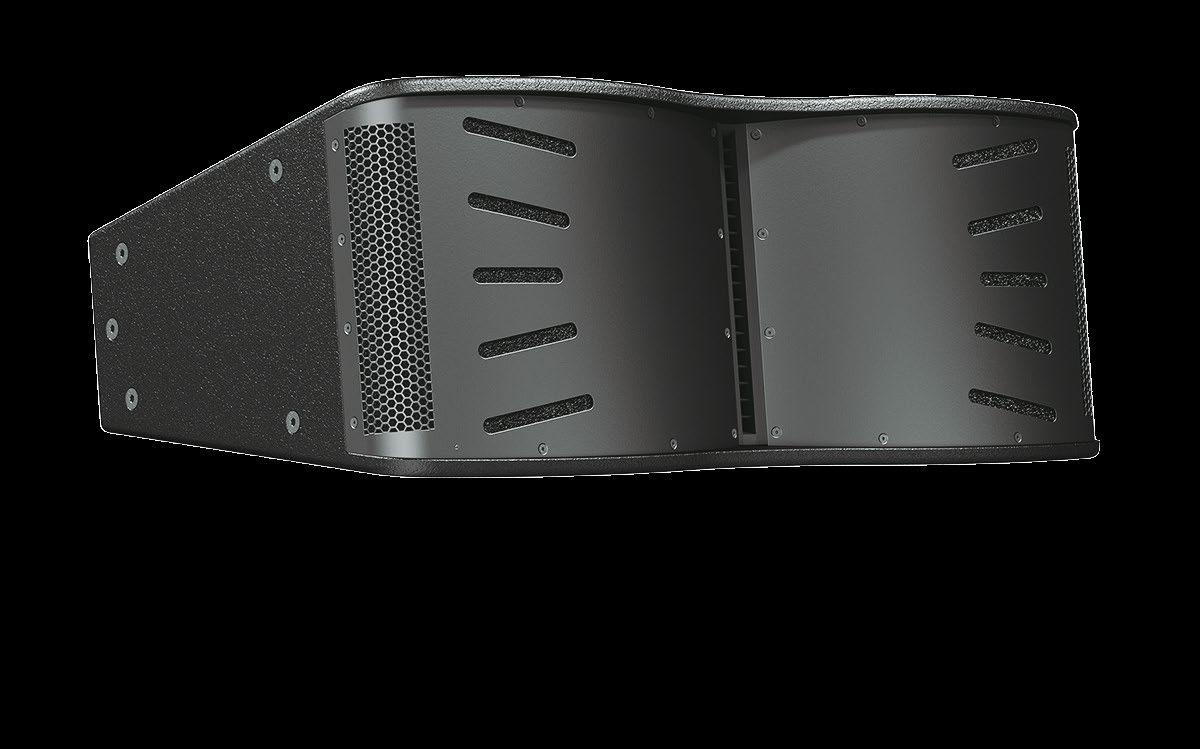

In July, the next generation of the Yorkville Sound Paraline series with four new compact powered enclosures. The full-range PSA26 and PSA28 combine Tom Danley’s patented Paraline Lens and Synergy Horn technologies to minimize comb filtering while maximizing efficiency and directivity. They also feature lightweight neodymium drivers, tone shaping controls, onboard limiting, and integrated rigging hardware. The PSA15S and PSA18S subwoofers are designed to pair with the top boxes, and offer 3000 Watts of peak power in 15” or 18” woofers. All four new models are IP54 rated and built at Yorkville’s factory in Pickering, Ontario.
The Adamson Systems Engineering CS7 has analog input/output, but it also operates through a proprietary network platform to daisy-chain networked audio between multiple sources. Added to this is the feature of onboard DSP and amplification. Behind the scenes, Adamson’s proprietary AI software controls it all. The

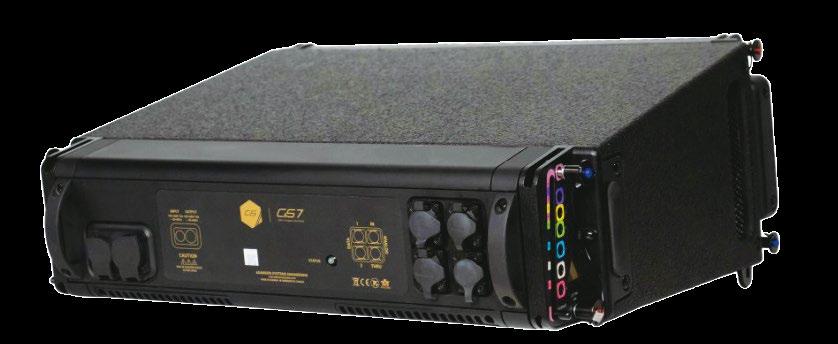

etherCON terminals, and a powerCON TRUE1 connection. The transducers produce a dispersion pattern of 100 degrees horizontal by 12.5 degrees vertical. The +/-3dB frequency range is 80Hz-18kHz. In some sound environments, particularly traditional churches with stone walls and columns, large hanging arrays do not always work acoustically or aesthetically. The AtlasIED ALA20TAW can produce big sound from seemingly nowhere using its twenty 3in. full-range drivers to deliver very clear speech. Its 45-degree vertical and 135-degree horizontal dispersion adds directivity, allowing it to keep reflections under control in very reverberant spaces. The aluminum housing is light enough to hang in a wide selection of places to work with the existing acoustics. Each unit has 1000W power handling and can operate in 70/100V as well as low impedance systems. The compact, arrayable point source Blaze Audio CCA10i can unobtrusively cover a medium-sized venue or be used in larger numbers for granular control on more expansive systems. This model has a coaxial compression driver with a frequency range of 420Hz to 18kHz along with twin 10in. high-excursion, ultra-low distortion drivers that extend bass response down to 52 Hz. The bi-amp capable, polyureacoated Baltic birch plywood housing provides 20-degree vertical and 160-degree horizontal dispersion. The front is protected by a 14-gauge perforated steel grille with a powder-coated black finish.
Complete with the ability to vary directivity in each array module, the Bose Professional ShowMatch SM5 DeltaQ features field-changeable 70-degree and 100-degree waveguides. These can be combined to produce asymmetrical coverage patterns. An optional 55-degree waveguide is also available. Each unit is fitted with four Bose Professional EMB2S compression drivers and two 8in. neodymium high-power woofers. Threepoint “quick pin” rigging facilitates setup for as many as 24 array modules. Splay can be adjusted from 0 to 5 degrees in 1-degree increments, and the side rigging

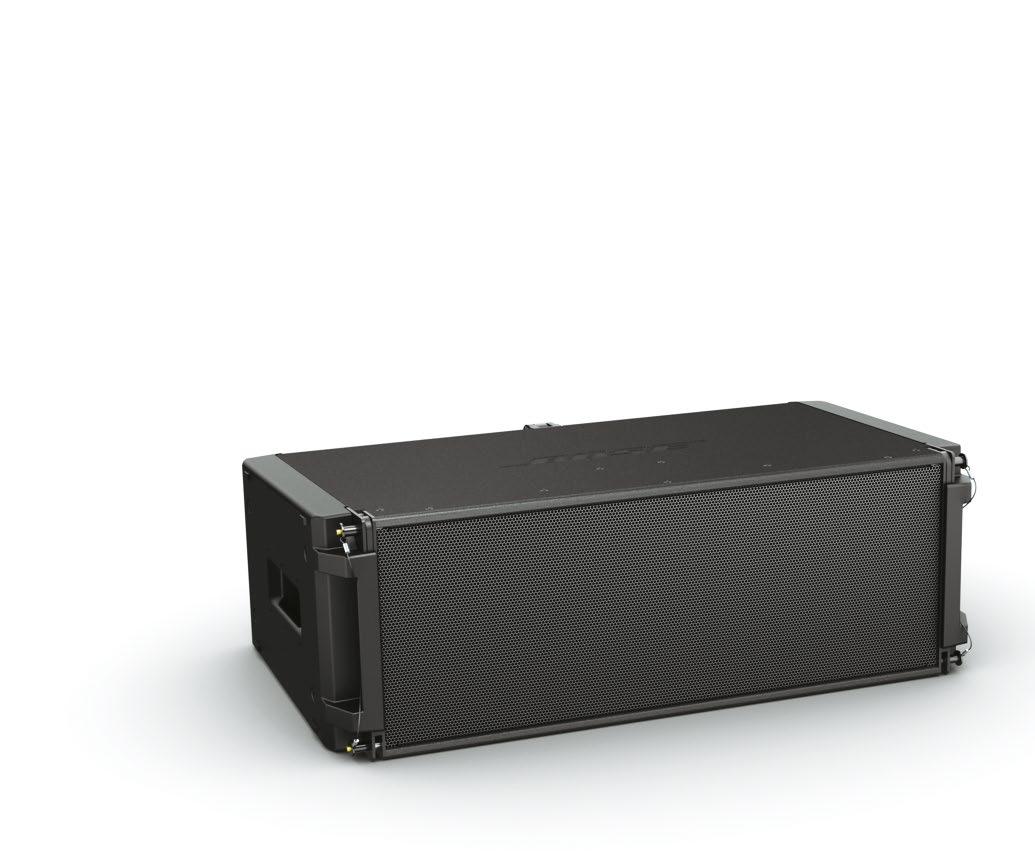

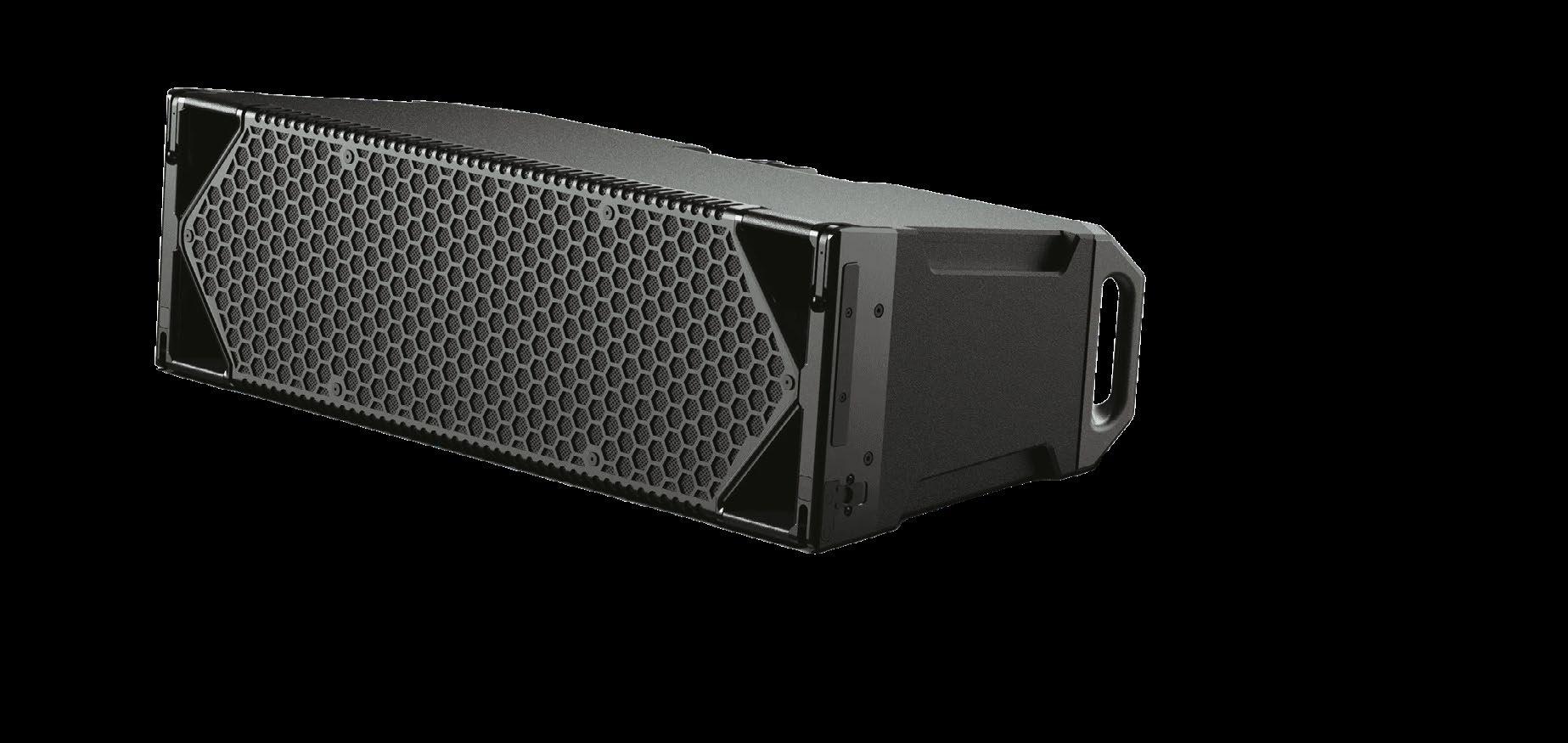
drivers and a pair of 1.75 in. voice coil compression drivers to produce a +/- 3dB frequency response of 42Hz to 16kHz. This low impedance system has a single male EP-8 connector at the input and a maximum output SPL of 150dB. Each module weighs-in at 132lbs. making it perfectly suitable for temporary touring setup or permanent installation. For medium and larger size performance spaces, the DAS Audio MARA-80 self-powered line array system can deliver 144dB SPL over an 80-degree horizontal coverage area. Each unit contributes to this with two 10in. woofers and twin cardioid configured 6in. drivers.
For shows that need to travel light and setup/ strike fast, the Baltic birch, steel, and aluminum cabinets have lightweight durability. The analog input interface simplifies setup, while adjustable horizontal directivity allows creative asymmetrical coverage patterns. Each 32lb. enclosure houses two 6.5in. woofers and a single HF transducer with a 1.75in. voice coil. The active design produces 1500W internal power.
The choice of bi-amp or full-range operation is the basic feature of the Electro-Voice XLE181 compact line array element. The horizontal dispersion is 120 degrees, and the vertical pattern is array-dependent and software-definable. Each element has 200W LF and 80W HF continuous power handling. The housing is 13-ply birch plywood with fiberglass under the Electro-Voice EVCoat, and the grille is stainless steel with powder-coat paint and hydrophobic cloth to resist moisture. Output is driven through an 8in. neodymium


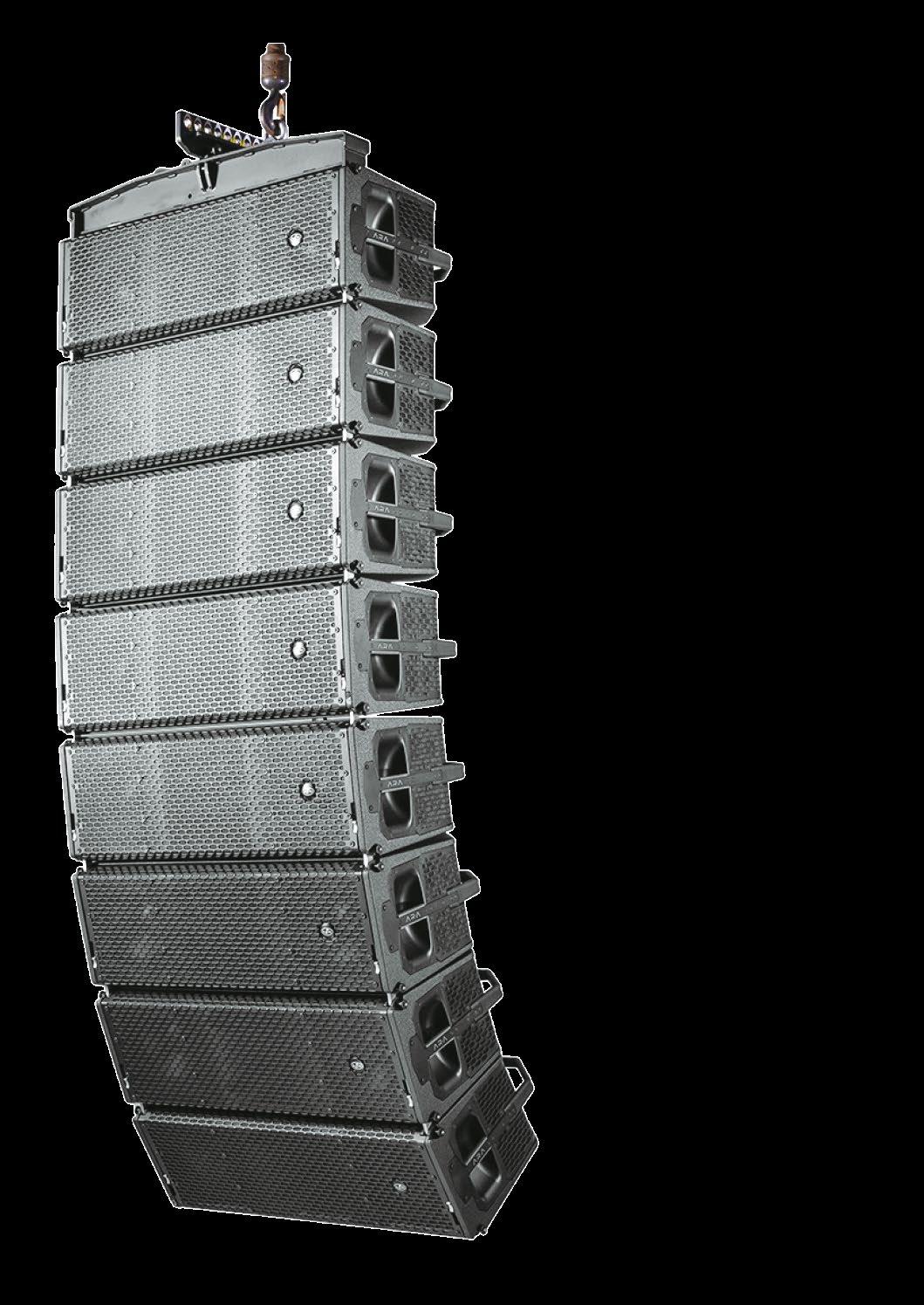
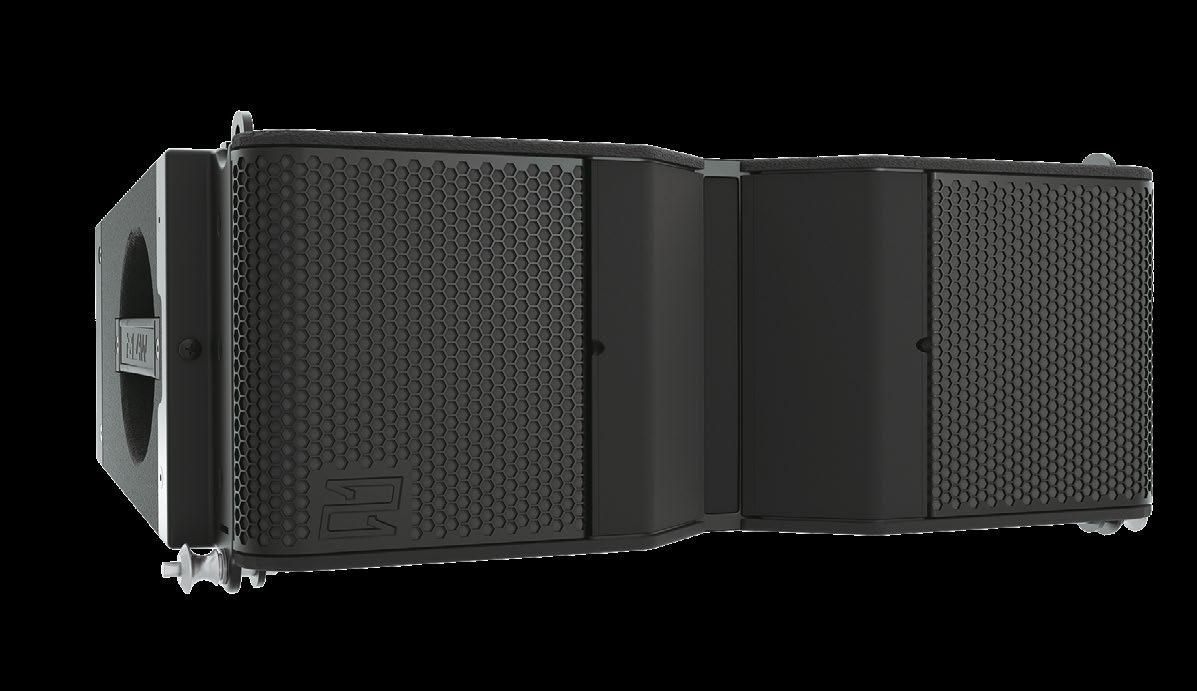

In the nearly four years since its global debut on Ed Sheeran’s + - = ÷ x (“Mathematics”) tour, Meyer Sound PANTHER has been a blockbuster success. It was the company’s most significant introduction in more than a decade, bringing over 150dB with Class D amplification to a remarkably compact cabinet. The first permanent installation went into the Xcel Energy Center (Sound Associates) in St. Paul, MN, home of the NHL Minnesota Wild, and there have been many more since. Drawing on sister Meyer technologies, the compact, sustainability-oriented PANTHER provides an acoustic output closer to the significantly larger and heavier LEO line array loudspeaker and occupies the slender form factor of the LYON line array loudspeaker. The innovations include an all-new electronics module, new cone and compression drivers, and a lightweight design utilizing advanced magnet structures and new materials. Despite stadium-level performance and IP55 weather rating, PANTHER weighs just 150 lb (68 kg). A dual analog/Milan AVB network input module offers flexible signal distribution options.

The d&b audiotechnik CCL12 compact line array system is primarily used in small to medium volume areas, and its CCL Flying frame allows up to 24 cabinets to be flown for 120-degree horizontal dispersion. The frequency response is 62Hz to 18kHz. Each housing is fitted with two 7in. neodymium forward LF drivers, two 5in. neodymium side-firing LF drivers and two 1.75in. exit compression drivers for the high end. In the array, the units can be set for zero to 14 degrees in one-degree increments. The enclosure is injection molded (ABS Polycarbonate)




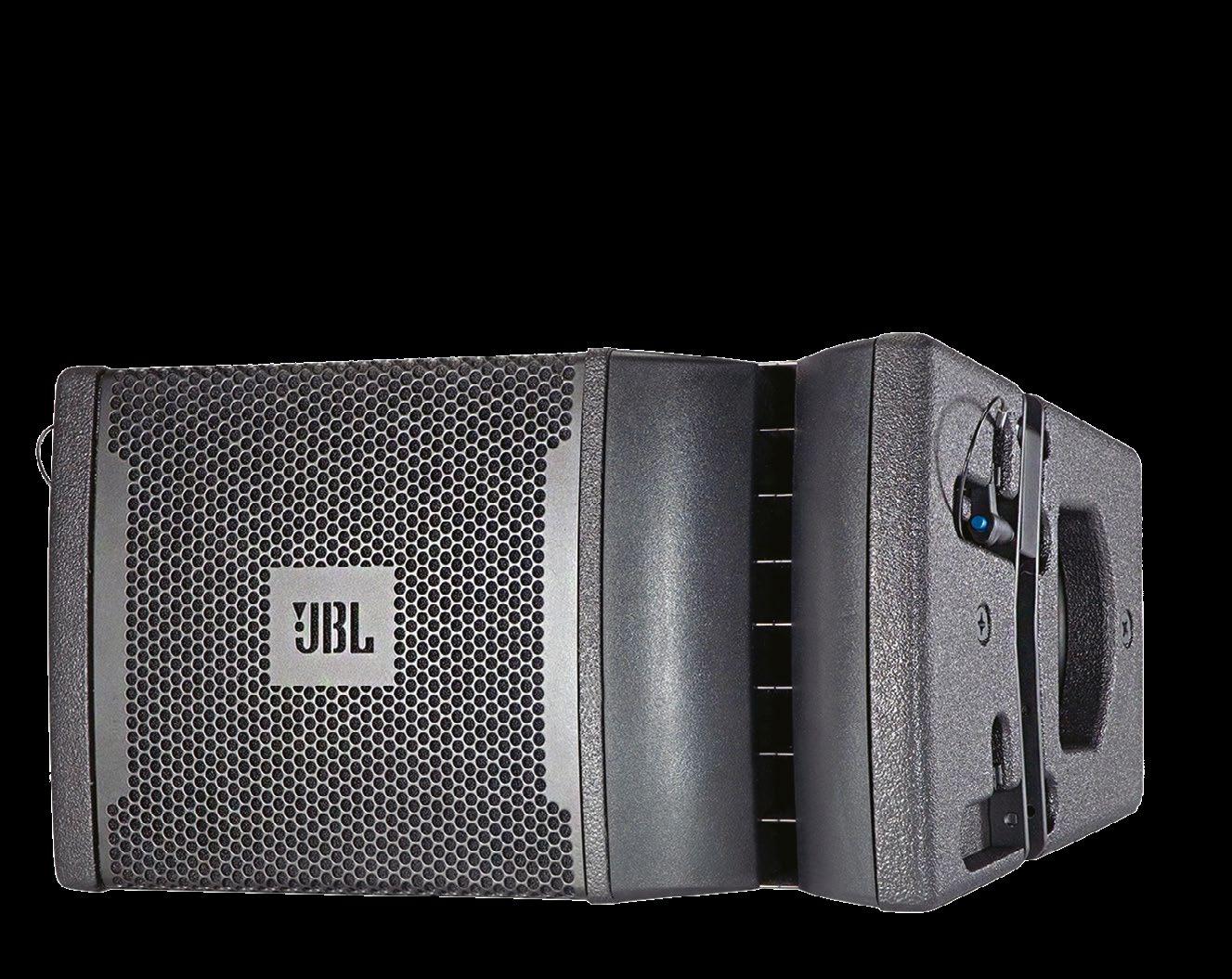

and pillars. The integral transformers allow the unit to be used in large numbers on a 70/100V system, where its 115dB maximum SPL covers a 7-degree vertical and 90-degree horizontal pattern.
compression drivers. These are united through twin hydra plane wave generators into a 120x10degree waveguide.
Little brother of the VRX932LA line array element, JBL VRX928LA is a compact product designed to fill smaller venues in arrays of up to six passive 8-ohm units. This two-way system
Differential Drive woofer and two JBL 2414H neodymium compression drivers. Capable of 122dB SPL in passive mode, each element is equipped with a Neutrik Speakon NL-4 connector mounted in birch plywood and covered with a black DuraFlex finish. The grille is powder coated black 18-gauge perforated steel with an acoustically transparent black foam backing.
The next best thing to having sound emanate from an invisible source, the KGEAR GF162T I is an array composed of 16 2in. ferrite magnet woofers enclosed in a column less than 3in. wide. It is available in black or white finish, and when in place, the array can blend right into the architecture. These thin columns are especially useful in traditional churches with stone walls
An award-winning active array element with multi-cellular DSP and digital networking, the Martin Audio MLA Mini uses separate Class D amplifiers to power each cell. Automatic and accurate DSP configuration is made by DISPLAY2.1 intelligent software, while vertical coverage is tweaked electronically. The flying system permits up to 16 MLA Mini units or 12 MLA Mini elements along with 3 MSX enclosures to be easily rigged and flown. The enclosure’s peak SPL of 130B covers a horizontal angle of 100 degrees (-6dB) and delivers a (+/-3dB) frequency response of 76Hz-18kHz.
Two 8in. high excursion 16-ohm neodymium LF drivers, twin HF compression drivers, and REDLockTM rigging team up to say smaller is better with the NEXO M28 compact array module. These produce a frequency response of 65Hz19kHz (+/-3dB) and a 141dB peak SPL. There is a range of possible customized combinations using the M28 in conjunction with other Nexo array components. Nexo’s NS-1 is a simulation tool that can be used to configure and optimize the M28 and other system elements. Compass RigTM


inter-cabinet angle to adjust vertical coverage.
Lightweight design and low stage profile are key features in the Meyer Sound Leopard line of speakers that enable brisk setup and tight control during operation. For a wide 100-degree horizontal coverage pattern, the original Leopard is the choice, but for tighter patterns and challenging spaces, the Leopard-M80 narrows that horizontal angle to 80 degrees. The two can be flown together for asymmetrical coverage. The Leopard units are self-powered with an integral Class D amplifier, and the addition of the 900LFC low-
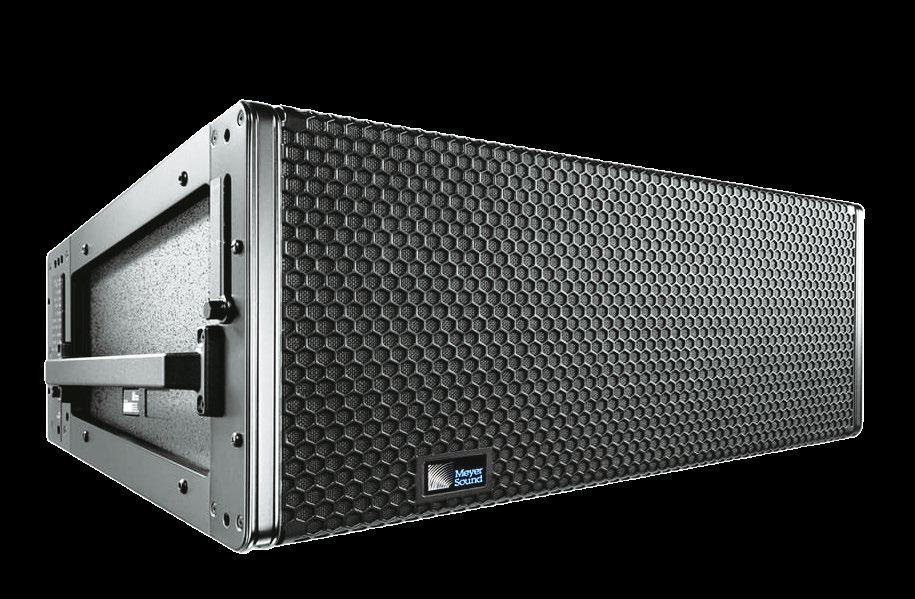
frequency control element extends bass considerably. Colored finishes and weather protection are among available options.
The PK Sound T8 robotically controlled line element combines a pair of vented 8in. Tetracoil LF transducers with a 3in. dual ring radiator coaxial compression driver for mid-range and a 2in. variant of that compression driver to handle HF output. A distinctive feature is the ability to remotely control horizontal directivity between 60 and 120 degrees in real time by manipulating its waveguide from a control point. A acts to smooth frequency response over the entire acoustic space. High-grade Baltic Birch forms the cabinets, and the grill is powder-coated aluminum.

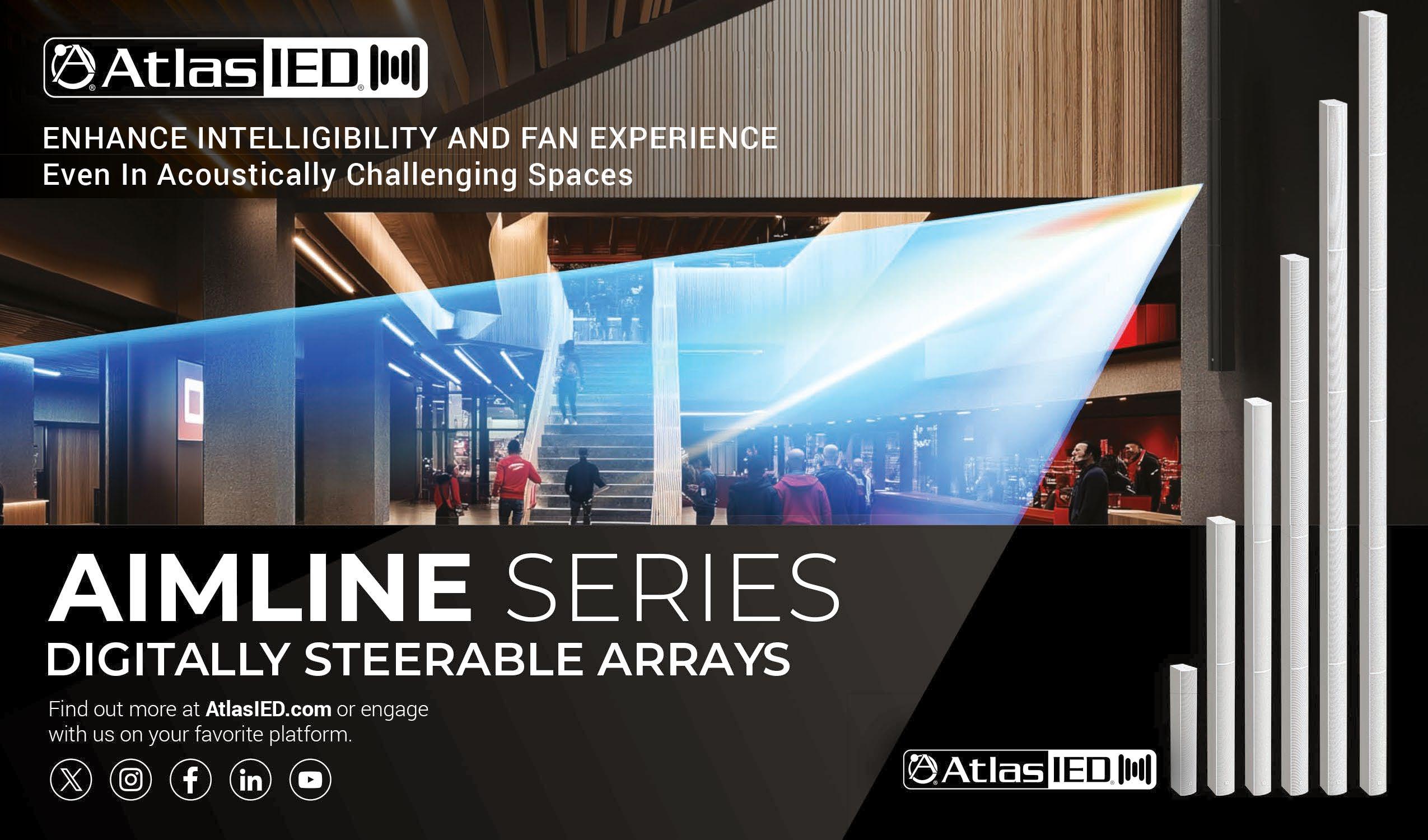
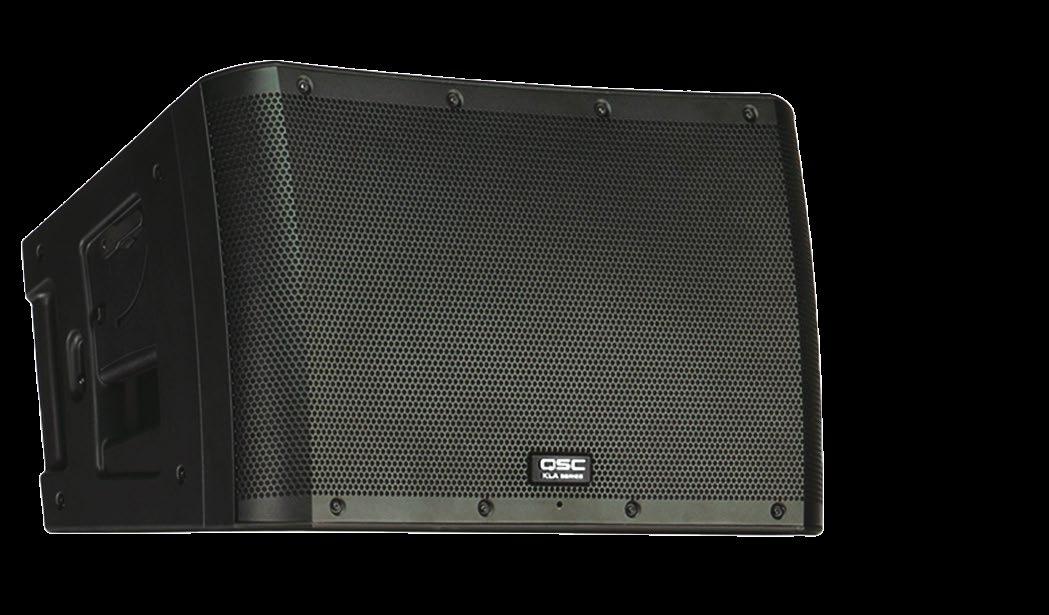
with ease of use, the QSC KLA12 normally teams with the KLA181 18in. subwoofer to form the KLA line array system. Whether mounted in the SOLO (Single-Operator Logistics) Rigging System or Tilt-Direct 35mm pole socket, the component uses balanced, line-level XLR inputs and powerCON AC in and out connectors along with LED indicators marked Signal and Limit. There are also discrete LED indicators for Power/Standby status. Power is applied through a Class D 500W x 500W power module that drives a 12in. woofer and 1.75in. diaphragm compression drive. The system produces a frequency response of 49Hz18kHz (-6dB).
Large venues with outdoor weatherization and long-throw requirements are the application for the RCF HVL 15-L three-way, bi-amp loudspeaker system. Two 15in. neodymium magnet HVL Series woofers, twin 10in. mid-range transducers, and a pair of 4in. voice coil, titanium dome compression drivers compose each high-power unit. The system handles 1000W RMS power on the LF end and 900W on mid/high for an SPL of 144dB and frequency range of 43Hz to 18kHz (-10dB). The coverage pattern created by these components is 90 degrees horizontal and 30 degrees vertical. The Baltic birch plywood housing is weatherproofed with a textured, polyurea coating.
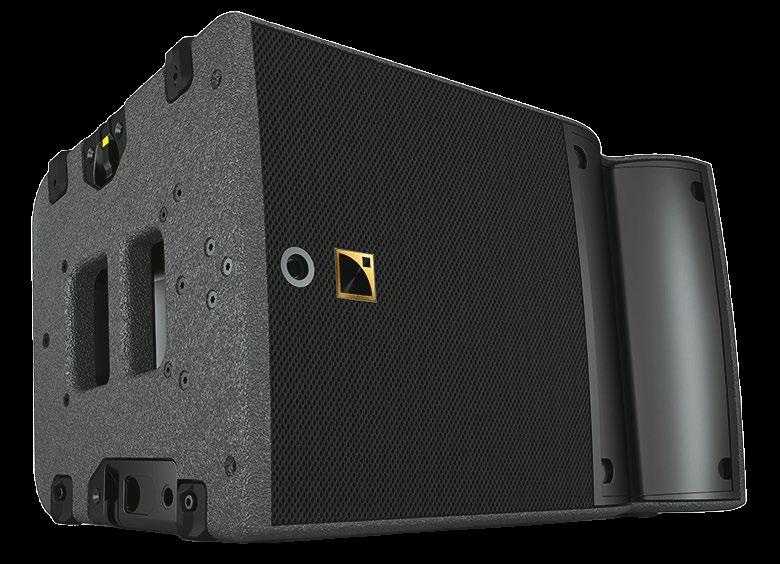
Part of the A lineup, L-Acoustics A10i Focus can suit a large variety of sound spaces with the capability to be flown in vertical or horizontal arrays, stacked, or pole-mounted. Each enclosure can be configured for 10 or 30-degree coverage options and adjustable waveguide configuration. It is a passive 8-ohm 2-way system featuring a single 10in. cone driver and a 2.5in. diaphragm compression driver. The integral L-fins produce 100/70-degree symmetric coverage or a 90-degree asymmetric pattern with a maximum SPL of 140dB and -10dB frequency response of 66Hz - 20kHz.
source line array speaker can be used in vertical or horizontal arrays and is capable of ground stacking as well. Fitted with integral SA1250 amp modules, the devices use a single 10in. LF woofer and a single or pair of HF compression drivers, depending on the need. They are fed through the company’s Tuned Conic Diverter WaveGuide. Variants include 60, 90, and 120-degree standard configurations, and the transitional WaveGuide options enable 60/90 degree and 90/120-degree coverage patterns. There is also an externally powered version designated as the VX101-7.
A built-in isophasic wavefront control horn optimizes the 1in. HF compression driver in the TOA Electronics HX-7 enclosure that is used in four bass reflex module arrays, each of which
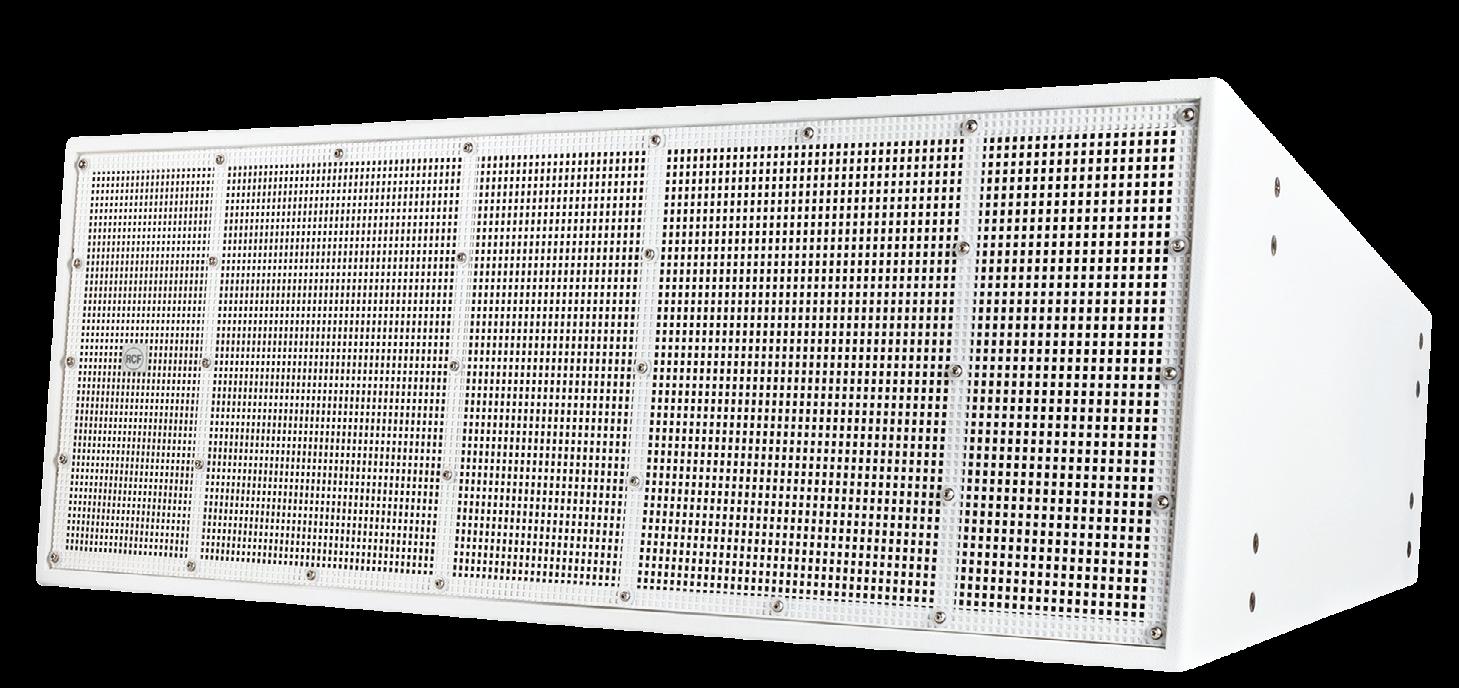
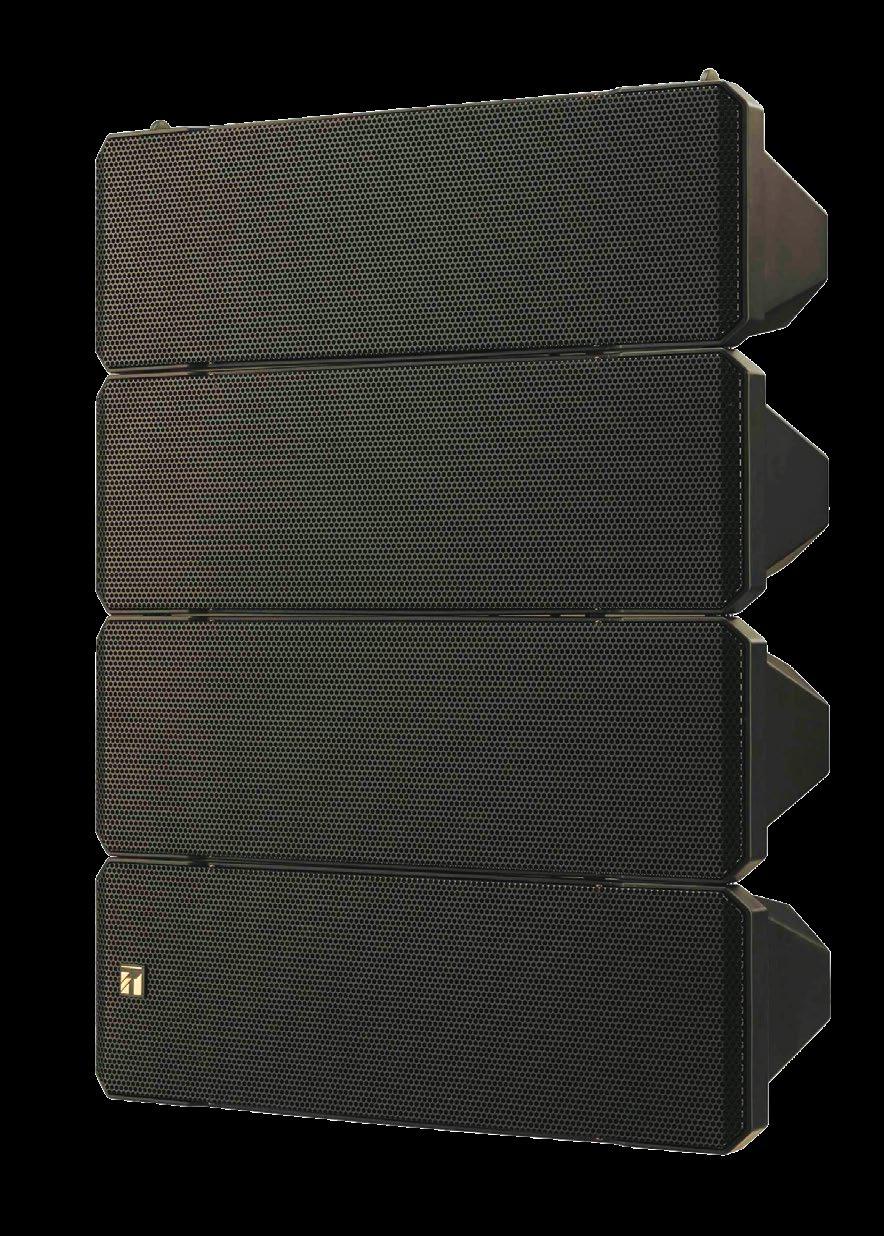
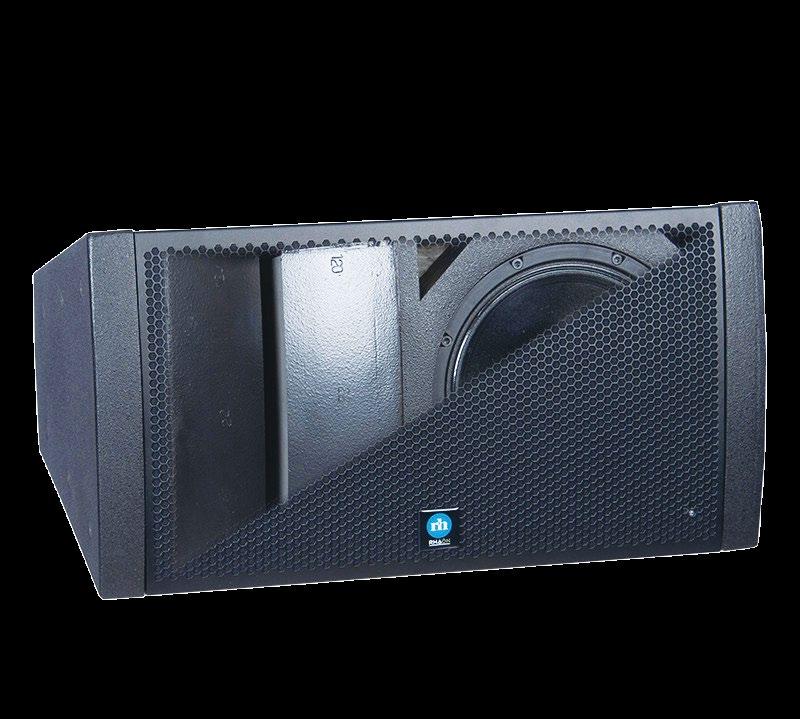
Working as an 8-ohm unit, each array delivers 75Hz-20kHz frequency response while enclosed in a polypropylene cabinet with a punched net, surface-treated steel plate grille. Steel hanging brackets ensure safe installation of the 66lb. arrays and the system handles 750W continuous power. Connectors include two Speakon NL4MPXX and M4 screw terminals. The HX-7 variants are available in black or white finishes.
envisioned in large venues but the VUE Audiotechnik al-4 can fit well into a small space and fill it with big sound. Designed with two 4in. Kevlar cone neodymium woofers and a single 1in. exit neodymium compression driver with its Truextent Beryllium diaphragm. This model’s 90-degree horizontal coverage angle can be adjustably complemented on the vertical depending on the number of units used. As many as 24
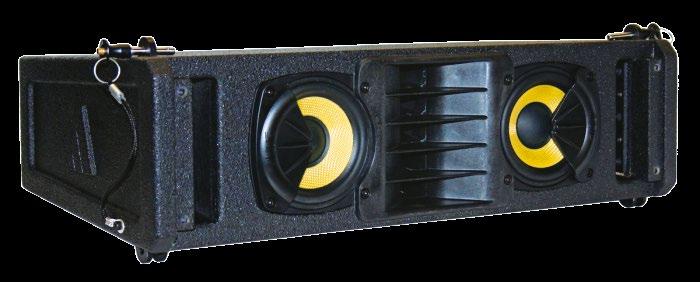

can be hung from a single flybar. The 19.9in. housing width allows it to blend visually with no blocked sightlines. Conference rooms demand a natural-sounding speech environment, and the Yamaha VXL1B16P/VXL1W-16P (black/white) has made a name for itself in that realm with Dante connectivity and PoE power. Sixteen 1.5in. full-range, neodymium magnet drivers pump out 15W with an IEEE802.3at PoE device or 6W running on IEEE802.3af type PoE. A PoE-compliant L2 switch enables the speakers to be operated as a network device. The column’s small size and the wide assortment of available attachment devices allow them to be mounted in any location that suits the room acoustics and décor.
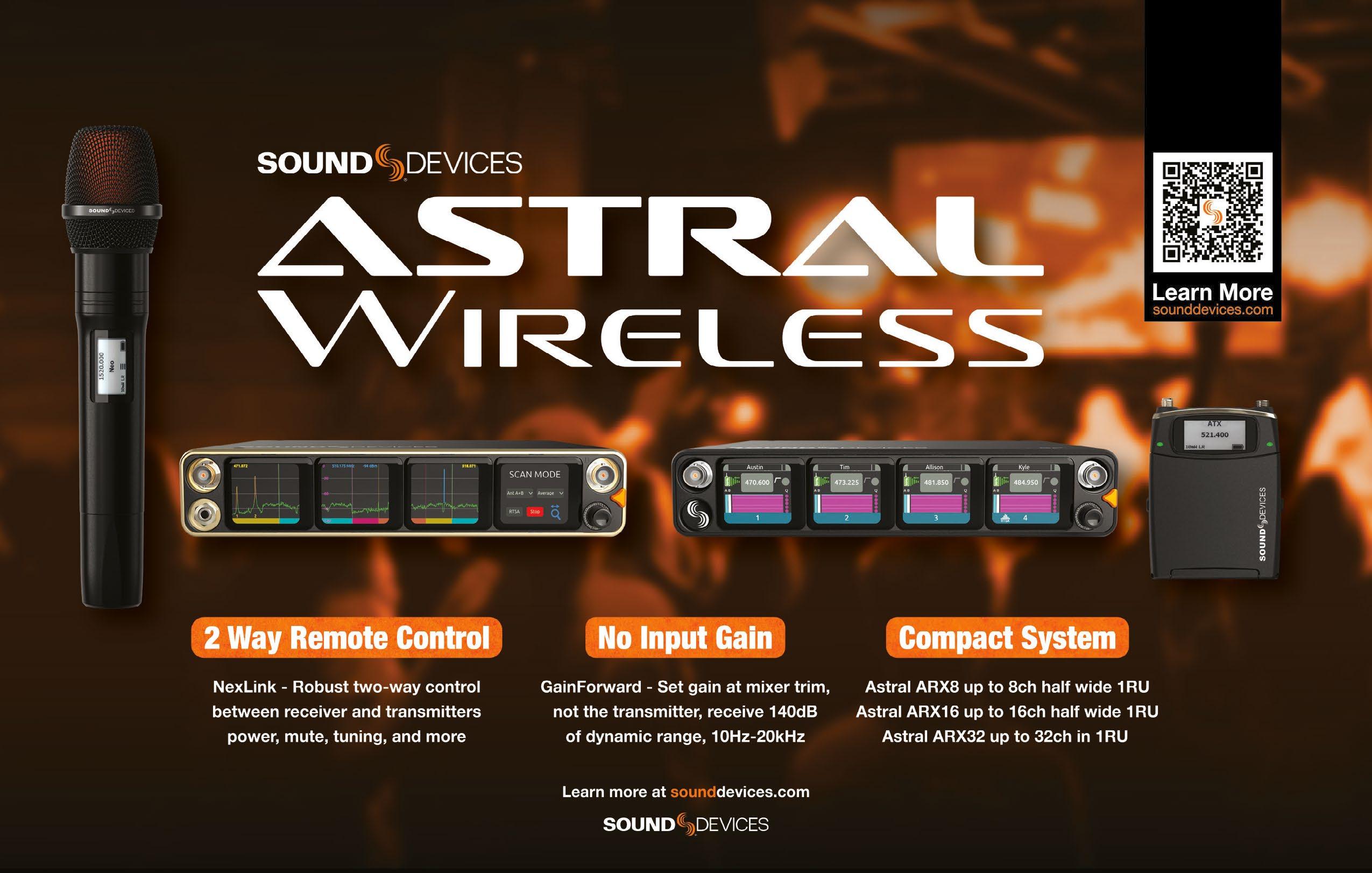
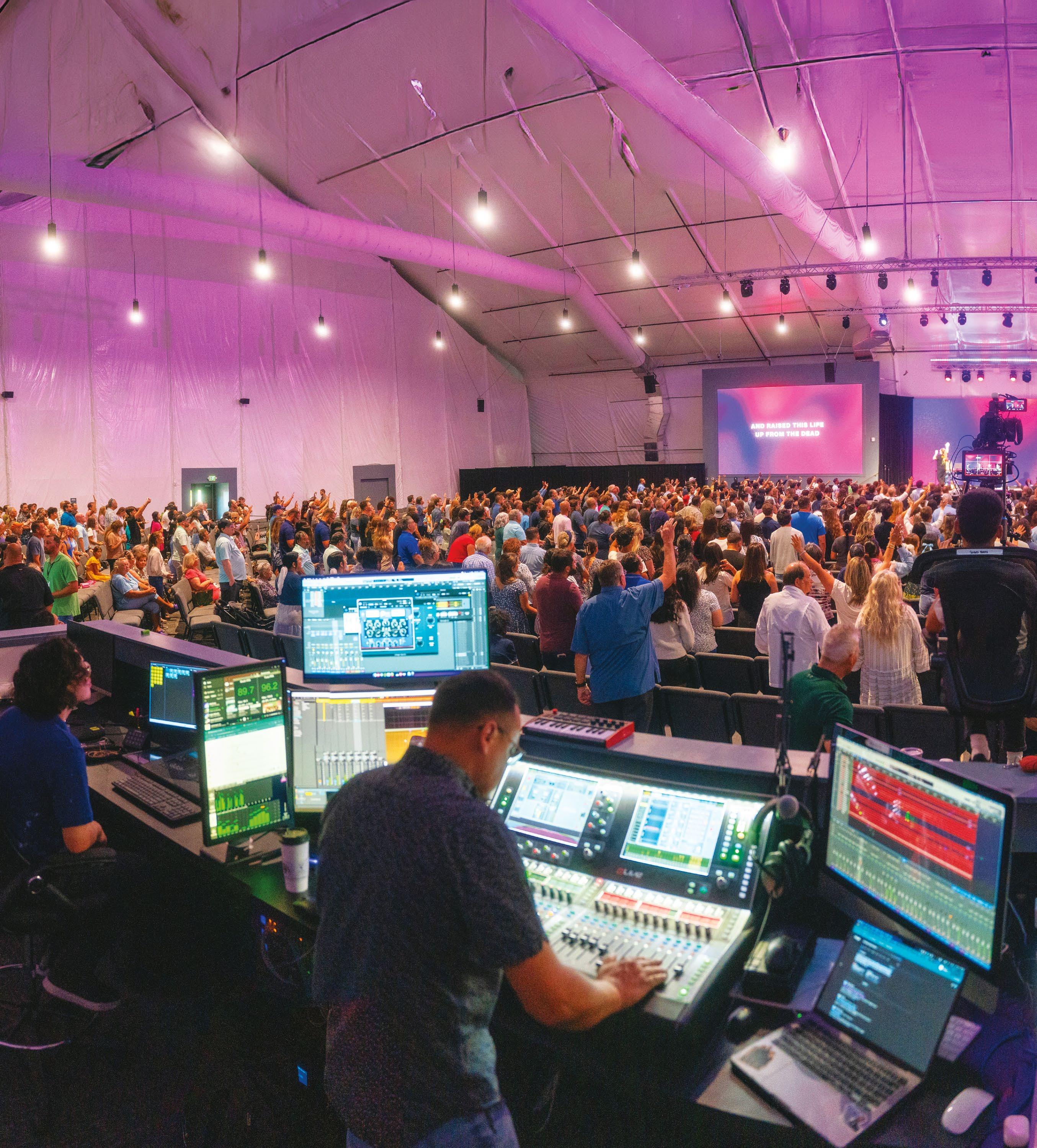
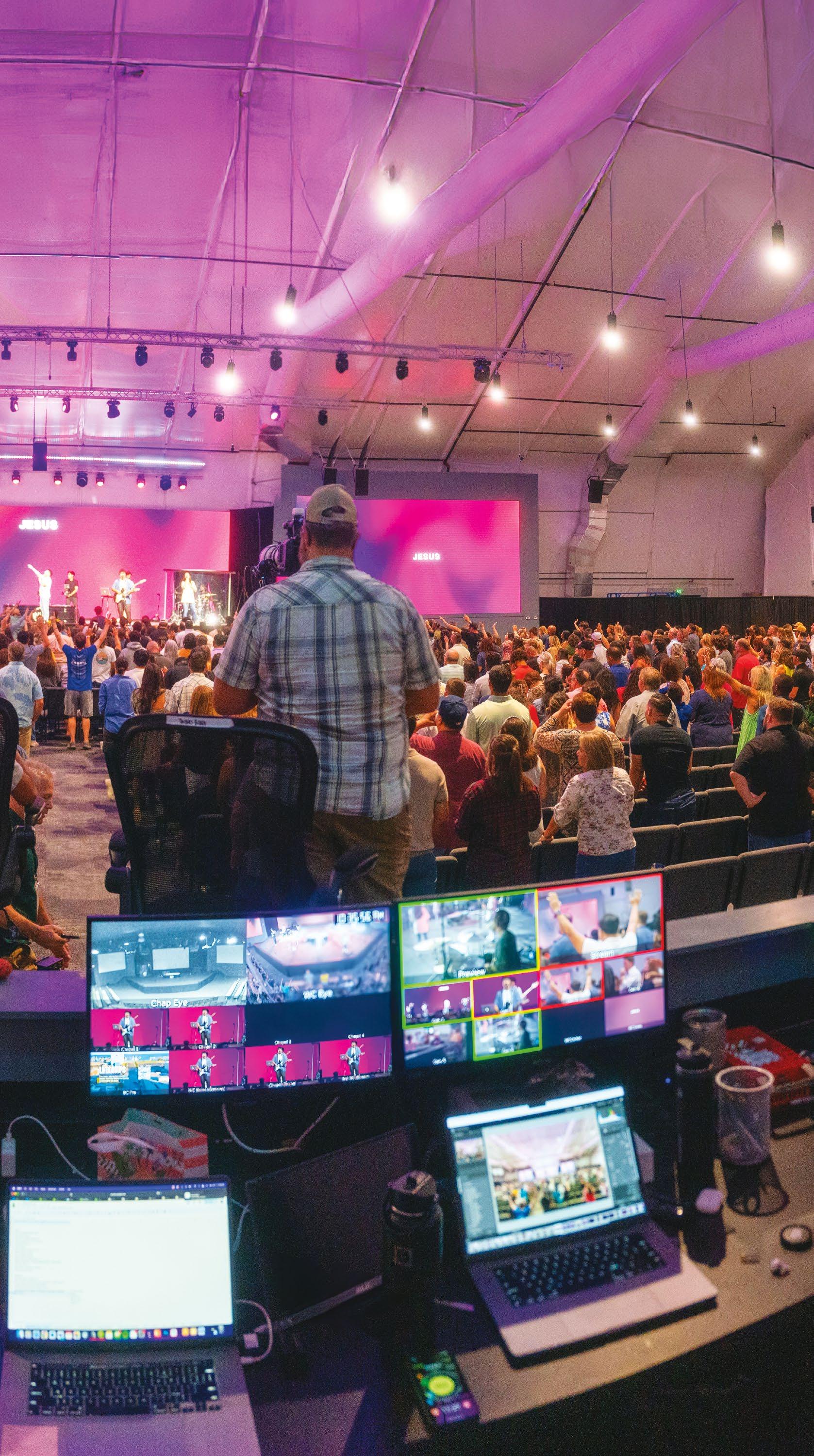
One of the most interesting developments in audio over the past 20 years is the rise of spatial sound technology that can change a room, whether to manage troublesome acoustics or create immersive experiences. Since Meyer Sound Constellation debuted in 2006 (and dominated the trend for the first decade), other acoustical and spatial systems have emerged from our industry’s best minds to bring unique experiences to theaters, restaurants, attractions, and live events. Not to be left out, a number of houses of worship have proven that spatial sound has a place in church too.
Earlier this year, New Life Church in Corpus Christi (left) unveiled its unusual new location featuring a d&b audiotechnik Soundscape audio system with En-Scene and En-Space modules. Soundscape draws on 40 years of processing innovation to provide a sophisticated spatial platform. Five years in development, under the supervision of Ralf Zuleeg, Head of Sales Services and Application Engineering at d&b, it had its first showing at AES 2017 in New York and made its official debut in 2018 at ISE. The following year saw its theatrical debut on London’s West End and since then it has served in events, tours, and venues across the world, including houses of worship.
New Life Church is housed in a structured tent with the unique acoustics you might expect. The system installed by E2i Design resulted in a dramatic transformation of the tent’s acoustics, improving the depth and localization of the worship band in the mix, and increasing engagement from the congregation through the innovative voice lift technique.
Because the church is adjacent to a military airstrip, it required the construction of a nonacoustically optimal tent structure with its inherent lack of reflective surfaces. E2i Design found d&b audiotechnik Soundscape with the En-Space an ideal solution. “Tent fabrics don’t offer the same reflectivity as permanent construction,” said Evan Hamilton, Chief Technical Officer at E2i Design. “Soundscape with EnSpace enabled us to create natural-sounding reverb times with resonances better than many traditional church environments.”
The core of the d&b Soundscape is the DS100 Signal Engine audio processor with Dante networking and a 64x64 level and delay matrix with in- and output processing. Users can do object-based or channel-based audio.
The object-based software module En-Scene provides detailed control that allows users to play with audio reality either to support detailed localization to what listeners see on stage or to create spatial audio illusions that bend expectation. The En-Space software module can manipulate room acoustics and even match them to recreate renowned acoustics spaces.
For New Life, the decision to include the Soundscape En-Scene module proved to be instrumental to the venue’s transformation. “New Life Church has a large worship band with six singers,” commented Hamilton. “En-Scene allows us to place those musicians in the mix, corresponding to where they are on stage, and provide a great sense of localization to everyone across the congregation. En-Scene is incredible, you gain depth and spaciousness in your mix where you never previously had it.”
During the process of deploying Soundscape, E2i Design realized how much the lackluster tent acoustics affected the sound experience of those on stage and also negatively impacted the experience of the congregants. “I am particularly proud that we leveraged Soundscape to provide an even more immersive environment through a voicelift system,” said Hamilton. “With mics hung over the congregation and piping them through En-Space, everyone in the audience experiences a greater sense of presence, especially while singing along… they feel like they’re in the same acoustic space as the band, making them feel more connected.”
E2i Design was able to provide a cost-effective solution to New Life Church by repurposing the existing d&b audiotechnik xS-Series system from the church’s old location. “When constructing New Life Church’s new location, their dream was to create an immersive worship experience, even though it was in a tent,” says Hamilton. “We were immediately off to a great start with their previously purchased xS-Series system. We integrated it with the DS100 and some additional d&b loudspeakers, and now New Life Church has a full-scale Soundscape PA.”
“The planning and approvals required due to the church’s proximity to the military airstrip made this a long process,” continued Hamilton. “ Now that the church is finally open, they have so much pride and passion for their new home because of its uniqueness and how amazing it sounds.” Hamilton adds that he sees a benefit specific to churches, beyond the immersive aspect. “Soundscape with En-Scene empowers a volunteer who knows absolutely nothing about audio, let alone
immersive audio, to easily create a phenomenal mix with space and depth. Plus, because elements don’t compete against each other, your overall volume is down across the board. We’ve had so much success with clients by showing them this one thing alone, I find it one of Soundscape’s most compelling features.”
The complete system installed by E2i Design for New Life Church included: five xS-Series 245-D loudspeakers for the mains; two 10S-D point source as extensions; six 21S subwoofers; eight 85 loudspeakers as surrounds; and six 44S loudspeakers for front fills. The system is powered by a combination of 30D and 5D amplifiers. A DS10 Audio Network Bridge Networking handles signal routing, and processing is provided via the DS100 Signal Engine running Soundscape with En-Scene and En-Space software. Half of the 8S speakers and two 24S-D were sourced from New Life Church’s earlier d&b audiotechnik installation.
Sometimes a spatial system may create a dramatic aesthetic experience, but it can also play an invisible but crucial role in creating community by bringing people in and helping connect them to their fellow worshippers.
In August, La Croix Church in Cape Girardeau, MO debuted their d&b Soundscape system designed for this important purpose. Installed by Panavid, it incorporates En-Scene, En-Space, and A-Series augmented arrays to address the acoustical challenges of the church’s sanctuary that were inhibiting full participation by congregants.
For years, the church struggled with an aging sound system and an acoustically dead space, the result of an overly aggressive acoustic treatment. The consequences were uneven sound coverage, poor speech intelligibility, and a lack of congregational participation during worship.
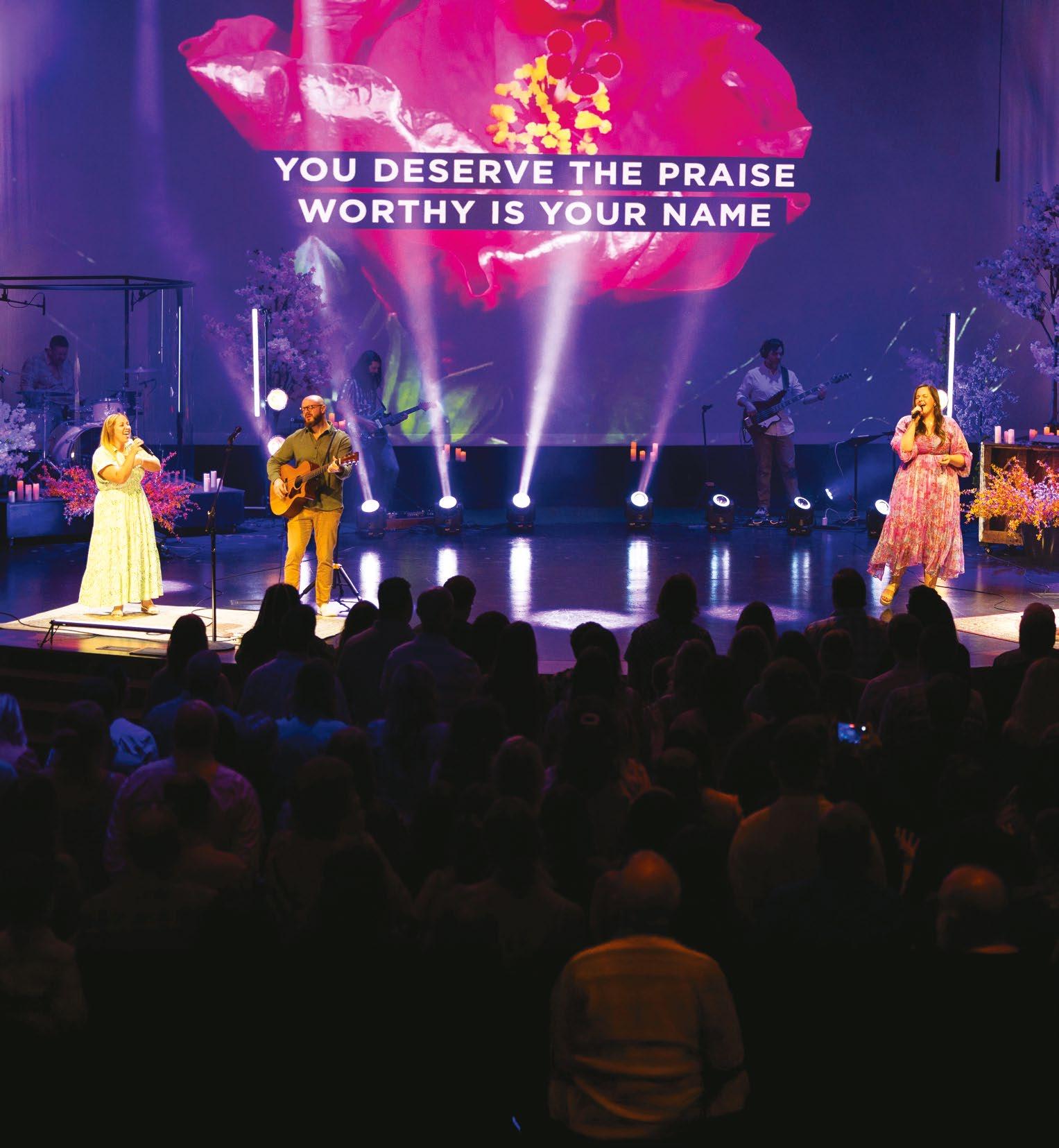
“Due to their 19-year-old sound system, the experience for the congregation wasn’t consistent from seat to seat, and because of the lack of reflections in the Sanctuary, the congregation was less comfortable singing in times of worship,” explained Rob Allen, Panavid’s Senior Director of Business Development. “La Croix came to us and asked if we could fix it with a beefier, more modern system. With the acoustic challenges that they had, Soundscape was a no-brainer.”
An old sound system and poor acoustics weren’t the only challenges faced by Panavid. “Their room has tiered seating, so vertical arrays would have introduced sightline issues. Above the stage, there was existing acoustical treatment, HVAC, catwalk, projection, and lights that we had to install around.” said Mike Cirrito, the lead technician on the project. “It was complicated. We were limited to using their existing fly points in the previous speaker locations. That’s why A-Series was perfect for this installation, and ArrayCalc simulation software was indispensable.”
“For the front stage, we went with A-Series because they can fly horizontally, are a third of the size and weight of the preexisting system, yet still drive comparable output levels,” continued Cirrito. “And the hardware accessories offered by d&b audiotechnik provide flexibility in installation. We placed the A-Series where they needed to go, without introducing sightline problems, and we did so efficiently. We were able to hang the threecabinet center cluster from a single fly point, where the previous setup required three points.” Cirrito also explained how ArrayCalc ensured a smooth deployment and helps ensure the system is best configured to take advantage of Soundscape benefits. “Knowing that there were heavy limitations in speaker placement, we put the exact measurements into ArrayCalc along with the components that we wanted to install. The way ArrayCalc displays coverage patterns and frequency responses in a scenario like this was instrumental. All of that was done ahead of time and then imported into the R1 management software at install.”
In addition to the loudspeaker deployment, Soundscape offered other benefits. The mix separation and depth of field provided by EnScene (along with the overall improvement in clarity from the new speakers) resulted in much better vocal intelligibility for the congregation. The acoustic dryness of the Sanctuary was addressed via En-Space room emulation and further enhanced through the implementation
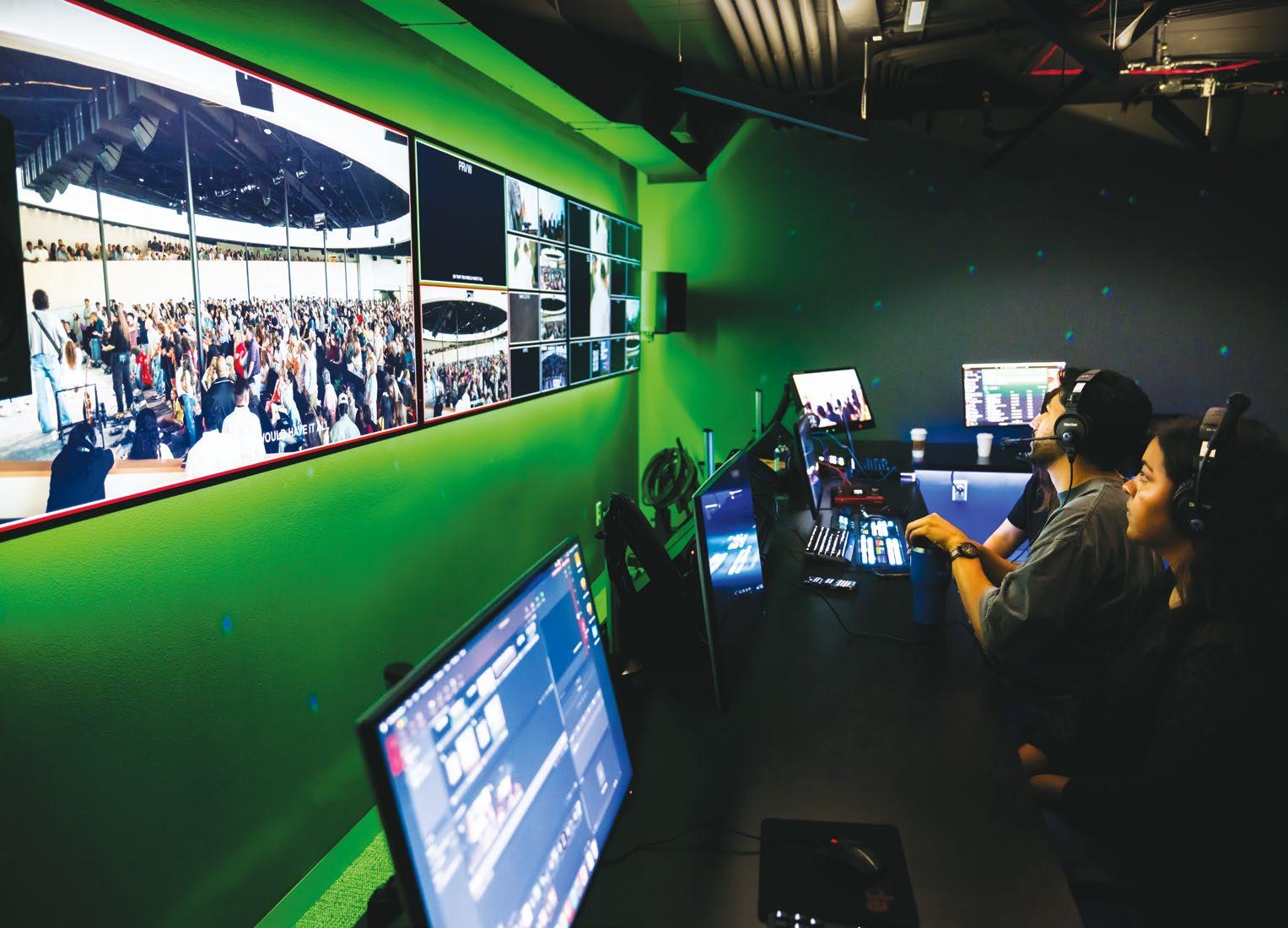
of a voice lift configuration where Panavid hung microphones over the congregation and fed them through En-Space to create a more engaging and participatory experience during worship.
“We chose the voice lift application to improve ambience during worship elements, but we’re discerning in how we use it.” Paul Smollen, La Croix Church’s technical director, explains. ”During the speaking part of the service, we switch En-Space off to give maximum clarity and focus to the pastor or presenter on stage, then when the worship band comes on, we enable En-Space to bring the entire congregation into the experience.”
The complete system included: eight A-Series Ali60 augmented array cabinets and eight flown Bi6 subwoofers for the main L/C/R. Seven Yi10P Y-Series point source were used for the delay ring and side fills. Three 44S point source were installed as front fills, and 31 5S point source were utilized as surrounds. The system is powered by two 40D amplifiers for main speakers and subs; two 10D amplifiers for delays and side fills; and seven 5D amplifiers for front fills and surrounds. Networking and processing are supplied by a DS10 Audio Network Bridge and the DS100 Signal Engine running Soundscape with En-Scene and En-Space software. Seven Audix SCX1 studio condenser microphones were hung in the Sanctuary for the voice lift configuration.
One of the most fascinating aspects of spatial sound is how it can change the physical size and presence of a room to transport people into a distinctive space with a powerful aural atmosphere and meaning. Even more interesting is when that spatial atmosphere is palpable both in-person and for streaming congregants.
Leadership at the newly opened Dallas-based UPPERROOM wanted to transport worshippers to the delay-heavy atmosphere of a cathedral, even though in real life they were gathered in a smaller modern setting. A dynamic church with global outreach, UPPERROOM wanted a compelling audio identity for all its congregants, in person and worldwide, and d&b Soundscape was the key to that.
The audio system, designed and installed by Epic Resource Group, dramatically transformed the acoustics of the church’s reclaimed industrial space, which was designed by Overland Partners, an architectural firm known for delivering transformative, innovative, and sustainable solutions. While Overland provided an impactful design, there were an array of acoustic challenges inherent in the space that needed to be overcome, including: an asymmetrical-shaped room with a glass wall, an overhead circular halo structure over the congregation, an acoustically dead environment, and numerous structural poles that
blocked loudspeaker dispersion.
Offering ministry 72 hours a week, UPPERROOM’s vision was to create a more intimate and engaging worship environment to better draw attendees into the worship experience. Their goals, however, were not limited to the in-person services. UPPERROOM connects with as many as 10,000 viewers per day on YouTube, and there was a strong desire to enhance the quality of their online ministry, as well.
In working towards a solution to address inperson and online pastoral care needs, it became evident that a Soundscape solution could meet and exceed the UPPERROOM requirements.
A combination of design tools helped provide a working plan. “Designing a system for a space this complicated wouldn’t have been possible without ArrayCalc,” shared Epic Resource Group Founder Brandon Chynoweth. “The software enabled us to quickly envision how acoustic energy would fill the room and guided loudspeaker placement. Once the system was up and running, ArrayProcessing ensured consistent acoustic energy projection across the room. The design of the system’s loudspeakers and subwoofers with their inherent directivity patterns was instrumental in providing low stage volume, resulting in clean, high-quality live recordings.”
The lynchpin of the installation was Soundscape, which helped solve the room’s most vexing acoustic problem, its twelve support poles. “Any stereo iteration I considered always had a pole about 3 feet in front of at least one speaker. The En-scene module on Soundscape provided the only answer,” affirmed Matt Wheeler, Epic’s senior audio systems designer. “The elegance of the Soundscape’s object-based mixing means a single loudspeaker doesn’t have to do all the work. En-Scene minimized shadowing from the room’s support beams, ensuring adequate coverage of the entire room. Now, you don’t hear the obstruction from the poles; sound appears to pass right through them.”
With En-Scene addressing the room’s acoustic challenges, En-Space room emulation opened up further possibilities. UPPERROOM’s Global Audio Director, Brandon Meyer elaborates, “En-Space is the key to making everything sound as good as it does. The natural reverb time of the room is less than half a second, but with the Basilica emulation, we can create an acoustic space with up to a six-second reverb tail.” Meyer continues, “Although we’re not physically in a huge cathedral, acoustically we are. Best of all, front-of-house engineers can apply processing to specific elements or sources
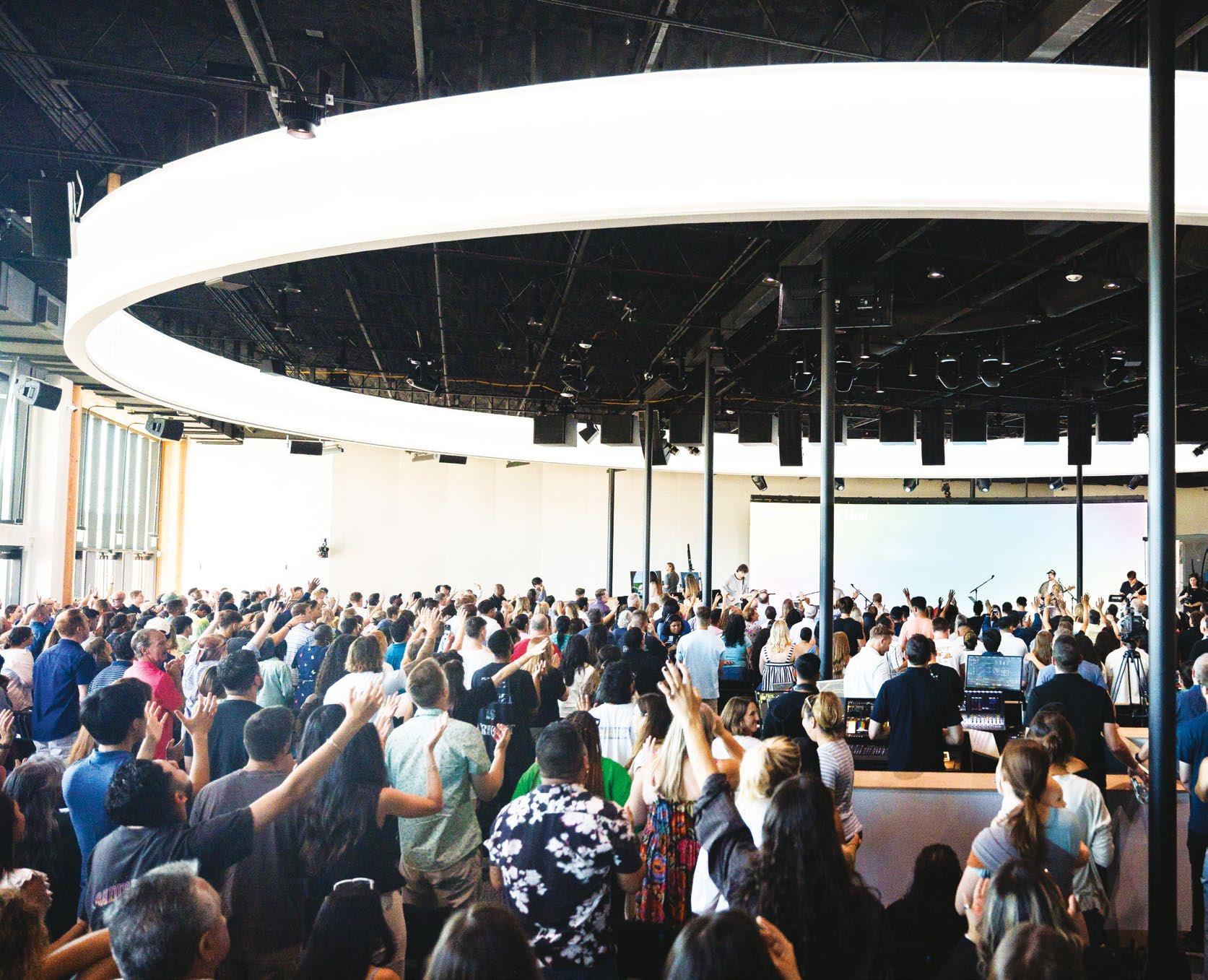
within the mix. Then when the pastor speaks, the message can be more tightly focused and sound like he’s speaking directly to you.”
Congregants affirm that feeling of being more deeply connected and immersed in the worship services. As Jonathan Lewis, executive prayer and worship pastor, shared, “It’s like you’re in the middle of the experience and you’re part of it.”
Lewis also reports that the system has elevated the quality of UPPERROOM’s live recordings and online broadcasts. “We didn’t just get a new sound system, we’re thrilled to have a ‘recording studio,’ too,”
The immersive nature of UPPERROOM’s new location has also contributed to a growth in attendance. “Since we’ve opened the space, what’s transpired since has been really special,” said Meyer. “People don’t know what they’re hearing, they just know they like it. Sunday’s services hit capacity and nearly doubled the attendance of our previous location. In fact, we’ve added another service on Saturday to accommodate everyone who wants to be a part of our worship experience.”
Epic’s Chynoweth concludes, “When you connect with people that deeply, your retention rate is much higher. If you’re focused on what that means for growing your church, spreading the word, making meaningful experiences in people’s lives, and keeping them engaged, Soundscape is a relatively small investment for the outcome it helps provide.”
The Soundscape 360 system features the DS-100 Signal Engine combined with 117 d&b loudspeakers installed in the facility. The front 180 degrees utilizes five compact T-Series line arrays, with each array comprised of six T10 enclosures. Flown in between the T-Series arrays are twelve V-SUB subwoofers, which combine with 9x ground stacked 21S-SUB subwoofers for low-end support. Thirteen xS-Series 44S enclosures are used as front fills, while six individual A-Series augmented array boxes comprise the inner surround ring, and nineteen E-Series E12 point source loudspeakers complete the outer surround ring. Five Y-Series YiP10 point source loudspeakers fulfill extension duties, and five T-Series T10P enclosures provide delay coverage for the oval-shaped ramp that leads to additional seating.
Since its founding in 1976, Westside Family Church, a multi-site Southern Baptist congregation in Lenexa, Kansas, has embraced change to best serve its community, so it’s perhaps not surprising that last year, they made the move to incorporate L-Acoustics L-ISA immersive sound technology into their worship experience.
The L-ISA immersive platform debuted in 2016 and expanded to include the Hyperreal Technology for precisely locating sound and L-ISA Studio for

creators to mix object-based audio.
“The Westside design presented several unique challenges,” explains Marc Breda, Project Lead at Vantage Pro AV, the church’s integration and technology partner. “First, the main worship space has an unusually low ceiling for a room of its size. We also had to work around a centrally located catwalk that further limited our usable trim height. Additionally, the church uses a large 34-foot-by14-foot projection screen for their services, so maintaining clear sight lines for important visual content throughout the seating area was crucial.”
Using L-Acoustics Soundvision 3D audio modeling software, the correct solution quickly proved to be an L-ISA design utilizing A10i as the primary loudspeaker. A mixture of both Wide and Focus models comprise the main Scene array, buttressed by KS21 subwoofers, with everything powered by a pair of LA7.16i amplified controllers.
“The new system nicely fits the room’s geometry,” he says. “It’s a moderate fan shape with stadium seating in the back, which lends itself well to an L-ISA design. There’s a little bit of extension seating out to the wings of the main floor, and we had to bring the main speakers a little lower in order to shoot up underneath the catwalk, but ultimately, everything fit perfectly.”
That would have been enough for almost any church, but Westside Family Church also wanted to
enhance the audio experience, says Vantage Pro Audio Team Lead Duke DeJong—and that meant immersive. “It’s been fun to watch their tech staff really lean into the L-ISA immersive technology,” he says.
“Houses of worship are embracing immersive sound for both creative and practical reasons,” explains DeJong. “While many are excited about the enhanced mixing capabilities and more immersive worship experience, there’s also a practical driver behind this trend. Traditional line arrays can protrude ten feet or more from the ceiling, creating visual obstacles. Interestingly, aesthetics have been the initial catalyst for all our L-ISA installations,” he adds. “
The impact of L-ISA technology extends beyond better sound—it can transform how worship teams engage with their ministry. For Obed Castillo, Westside Family Church’s longtime AVL Engineer, the difference was profound enough to bring him back to the mixing console. “With our previous system, I had stepped away from hands-on mixing because the lack of clarity made it difficult to distinguish frequencies,”
Castillo explains. “But L-ISA completely changed that. The clarity is exceptional—even subtle EQ adjustments are immediately noticeable. Plus, the system’s localization capabilities give me new creative options. Instead of relying solely on EQ, I can enhance elements in the mix by adjusting their spatial positioning. The results have been so inspiring that I’ve gone from mixing just three services a year to being at the console any time a volunteer is not available, and I can step in at front of house.”
The intuitive nature of L-ISA technology has proven particularly valuable for Westside’s volunteer audio team. “The system is remarkably user-friendly, especially with the comprehensive training provided by L-Acoustics staff,” Castillo shares. He cites an unexpected success story: when one of the church’s video operators attended the training sessions and created a practice mix at home, the results were impressive. “Their mix had a unique visual perspective, making creative use of the spatial capabilities. Despite coming from a video background, they produced excellent sound. This really demonstrates how intuitive L-ISA is— making immersive audio mixing accessible to our entire production team.”
On the creative side, L-ISA offers the church new capabilities that are changing the way it presents its messaging. “It has us thinking in a different way about sound and presentation,” says Derek Davis, Worship & Creative Arts Director. “Now, we have a variety of options that weren’t there before. For instance, we can pan any instrument or person to any part of the stage, and everyone listening will perceive the sound to be at that place onstage, no matter where they’re actually sitting. We can pan hard left or right, and everyone will hear it clearly.”
“We’re taking a methodical approach, using weekdays to explore L-ISA’s extensive capabilities and fine-tune them for our Sunday services,” Davis explains. “The system offers so many creative possibilities that we’re discovering new ways to enhance our worship experience every week. The results we’ve already achieved are incredibly rewarding, and we’re excited to continue exploring L-ISA’s full potential.”
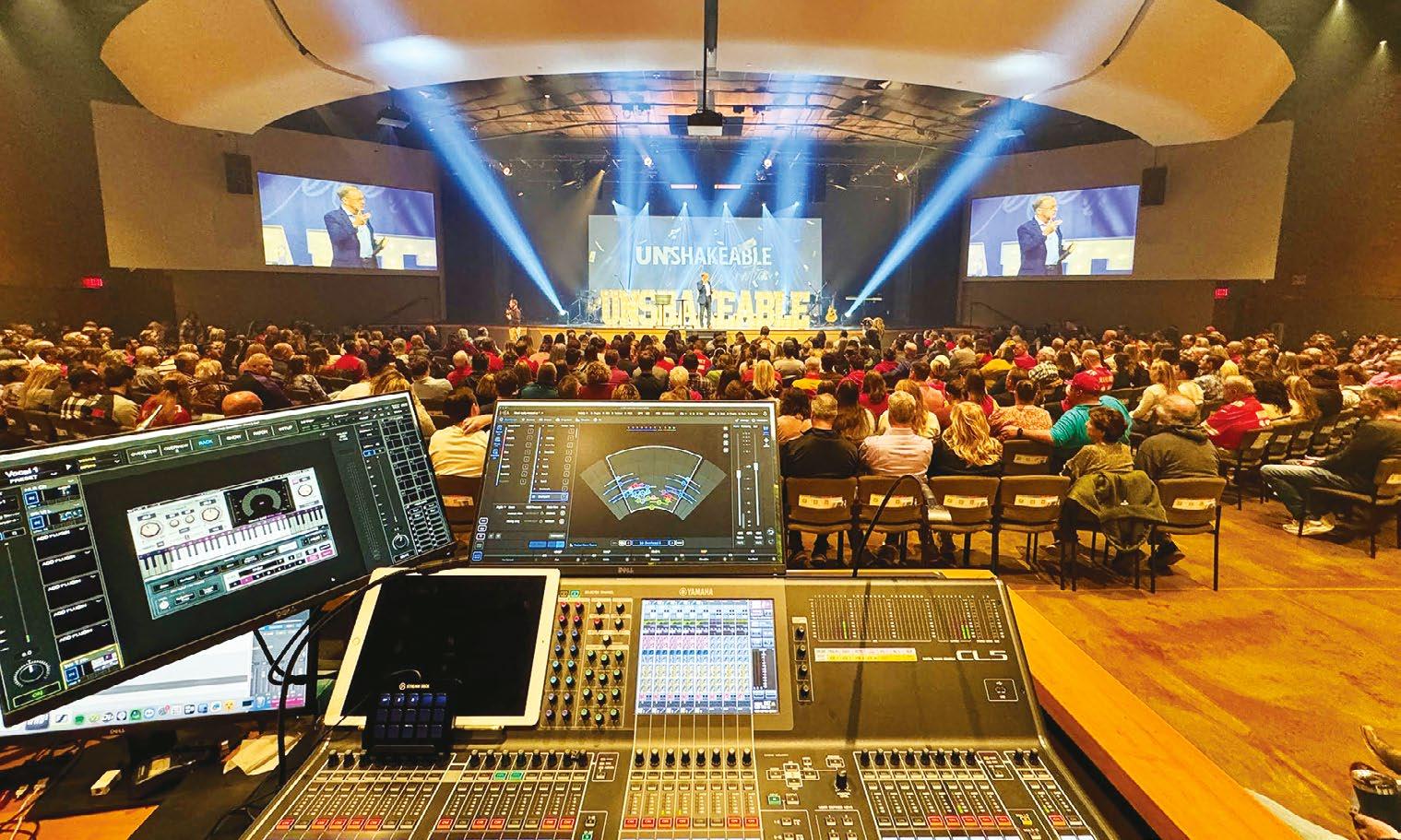
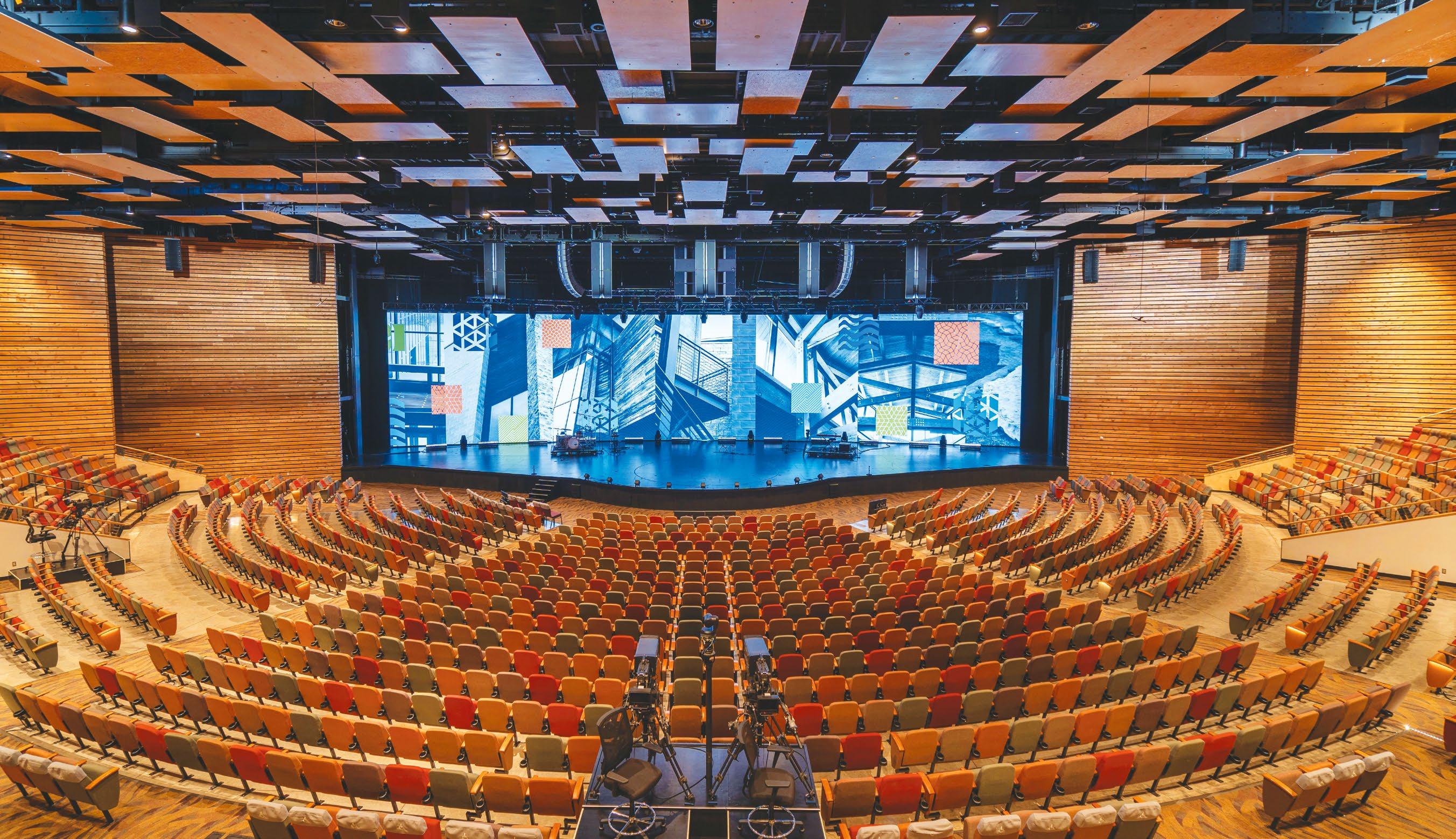
For churches with videowall centerpieces, spatial audio can play an important role in maximizing the impact of the video. The most recent L-ISA worship installation for Dallas-based Watermark Community Church is one of those examples with multiple campuses and over 9000 weekly attendants.
For years, it has been an L-Acoustics user, starting with a Kudo PA system that served them well for more than a decade. This year, Watermark headed into its next chapter with the adoption of L-ISA Hyperreal Sound technology with L-Acoustics L Series loudspeakers, sold and installed by Clark, an integration company based in Alpharetta, Georgia.
“Watermark is definitely unique,” says Clark Business Development Executive Noah Hawley. “The moment you walk in, you are riveted by the church’s nearly 100-foot-wide video wall made up of more than 1,000 half-meter-square LED tiles. And that massive scale is indicative of how they approach music and video production – there’s a lot of creative horsepower at work there. But amazing visuals aside, the single most important element in a house of worship is the sound, being able to effectively communicate the message to everyone in attendance.”
The church’s recent switch to L-ISA paired with L Series arrays has provided improved intelligibility and fidelity throughout the entire seating area. The main Scene system is comprised of five arrays of one L2 over one L2D. Four Extension arrays to the far left and right are made up of Kiva II, with eight enclosures per hang closer to the Scene system and seven enclosures per hang further out. Arrays of 10 Kara II each provide out-fill, with low-end coming from a center deployment of 10 KS28 subs flown in two hangs of five KS28 in cardioid mode.
Seventeen compact coaxial X8 enclosures are evenly distributed across the lip of the stage for spatial front-fill, while three KS21i subs per side are mounted into the face of the stage to supplement the room’s low end. Arrays of two A15i Wide per side provide extreme left and right over-balcony delay, while a dozen X8 serve as under-balcony delays. The entire system is powered and processed by 16 LA7.16i amplified controllers and three LA12X. These are driven via Milan-AVB with L-Acoustics LS10 switches, while an L-ISA Processor II with a 64-output license is driven over MADI from the church’s SSL L350 Plus FOH console.
Hawley says the sanctuary’s acoustics are magnificent. “Coupled with the acoustics and
L-ISA, for the first time everybody could see, wow, this is how the room is designed to be heard,” he says. “This is what the intended experience was supposed to be. Now the room’s complete, the vision’s been accomplished.”
“While I think most people don’t really understand what a spatial system does, they do know that it sounds clear and amazing, which is what we were shooting for,” says Bekah Winans, Watermark Community Church’s Audio Director. “They’re now able to pick out distinct instruments instead of just hearing a wall of sound.” She adds that the use of L-ISA technology has dramatically expanded sound coverage in the room, with at least 80 percent of the seating areas getting a fully immersive experience.
Operationally, L-ISA easily integrates into the church’s workflow, and can be controlled via either an external L-ISA Controller display or directly from a touchscreen of the SSL house desk. But the greatest accomplishment has been the enhanced sense of community with L-ISA, making the venue feel more intimate, says Hudson Horsley, the church’s Systems Engineer. “Whereas a lot of other systems divert attention to the speakers, L-ISA pulls your attention to the stage, and connects the audience with the communicator.”
An undisputed pioneer in spatial audio, Meyer Sound supported what must be one of the first use of it for worship. Eleven years ago, Constellation supercharged congregational singing for the Clinton Frame Mennonite Church in Goshen, Ind. (below)
Constellation was developed under the leadership of Steve Ellison and based on the patented VRAS (Variable Room Acoustic System) technology developed by Dr. Mark Poletti. It gives venues the ability to modify their room acoustics at the press of a button, allowing them to host a wide range of events and provide the acoustics most appropriate for them. For churches it allows them to create the ideal sonic characteristics for congregants to feel immersed and join in.
“The first time Clinton Frame used Constellation, the congregation sang ‘It is Well with My Soul’ acapella, and when they were done, everybody burst into applause,” recalls Doug Hood, president of Fort Wayne-based CSD Group, which provided and installed the Constellation system. “I was told that this sense of total engagement hadn’t happened in the church for years.”
The Constellation system at Clinton Frame’s 1,000-seat sanctuary was configured with multiple acoustic presets, four of which are primarily used for worship, with about six changes made during a typical service. That system was built around a D-Mitri digital audio platform that hosts patented VRAS acoustical algorithms. Acoustical ambience was captured by 23 miniature cardioid microphones, and the

enhanced acoustical response was delivered through 81 MM-4XP self-powered loudspeakers, eight UPM-1XP loudspeakers, and twelve MM10XP subwoofers.
“During services when the worship team sings through the PA, we turn on Constellation, and the crowd response keeps building as they join in,” reported Joel Miller, head sound technician at Clinton Frame at the time. “This folds back energy to the stage, and it just goes back and forth and gets stronger and stronger. The worship teams are just soaking it in and saying, ‘Wow, we can’t believe this is happening.’
“We installed Constellation for acapella singing, but we didn’t expect how much better speech would sound with a subtle blend of early reflections, and how the right setting could improve
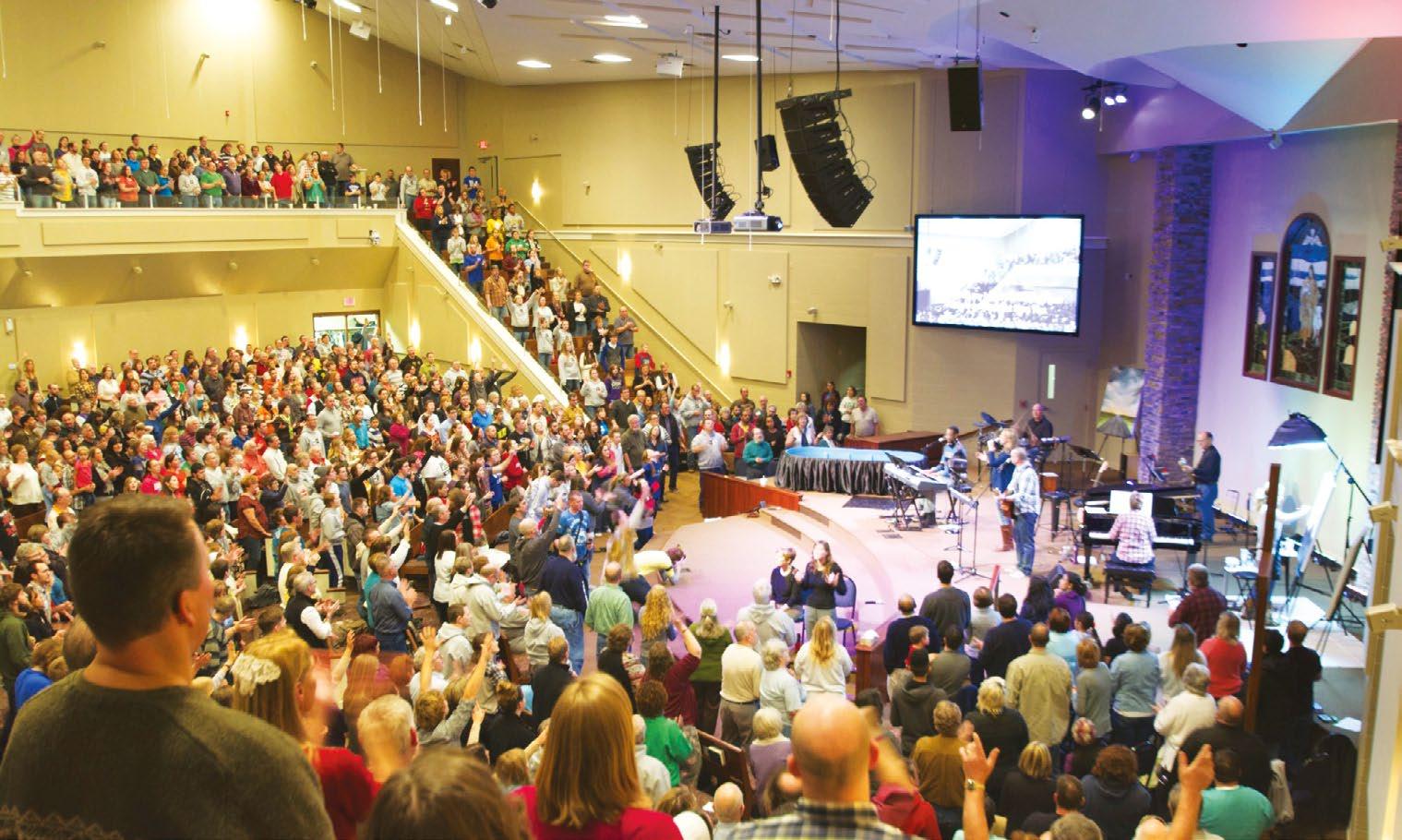
a musical performance by the worship band.”
Since then, other churches have incorporated the technology, and Meyer Sound has gone on to bring another spatial tool to fruition, Spacemap Go, a design and mixing tool for 3D audio. The seeds of Spacemap Go iPad app reach back over three decades; it was formally launched by Meyer in 2020, in the process, turning every GALAXY processor into a potential spatial audio engine and opening up a broad vein of applications worldwide.
On the worship front, Good Shepherd Church in Naperville, IL (above) deployed Spacemap Go to create a 3D audio experience for the church’s annual holiday show, “Encounter Christmas.” The system for the show, designed to cover a 400-seat black box worship space, was composed of 10 ULTRA-X40 compact loudspeakers, two ULTRA-X20 compact wide coverage loudspeakers, four 900-LFC compact low-frequency control elements, and two Galileo GALAXY Network Platforms. The deployment allowed the FOH engineer, Brian Rutter, to map each of the 16 GALAXY inputs around the room to create an immersive experience that used Spacemap Go to supersede what could be done with the traditional stereo line array system normally installed in the room.
“The benefit of an immersive deployment is that we no longer have to play the ‘sweet spot’ game where the listener needs to be equidistant to the left and right speakers to get a good image,” said Andrew Dewar, Good Shepherd’s Technical Director. “With an immersive system, where every speaker covers the entire audience, every seat in the house is sweet.”
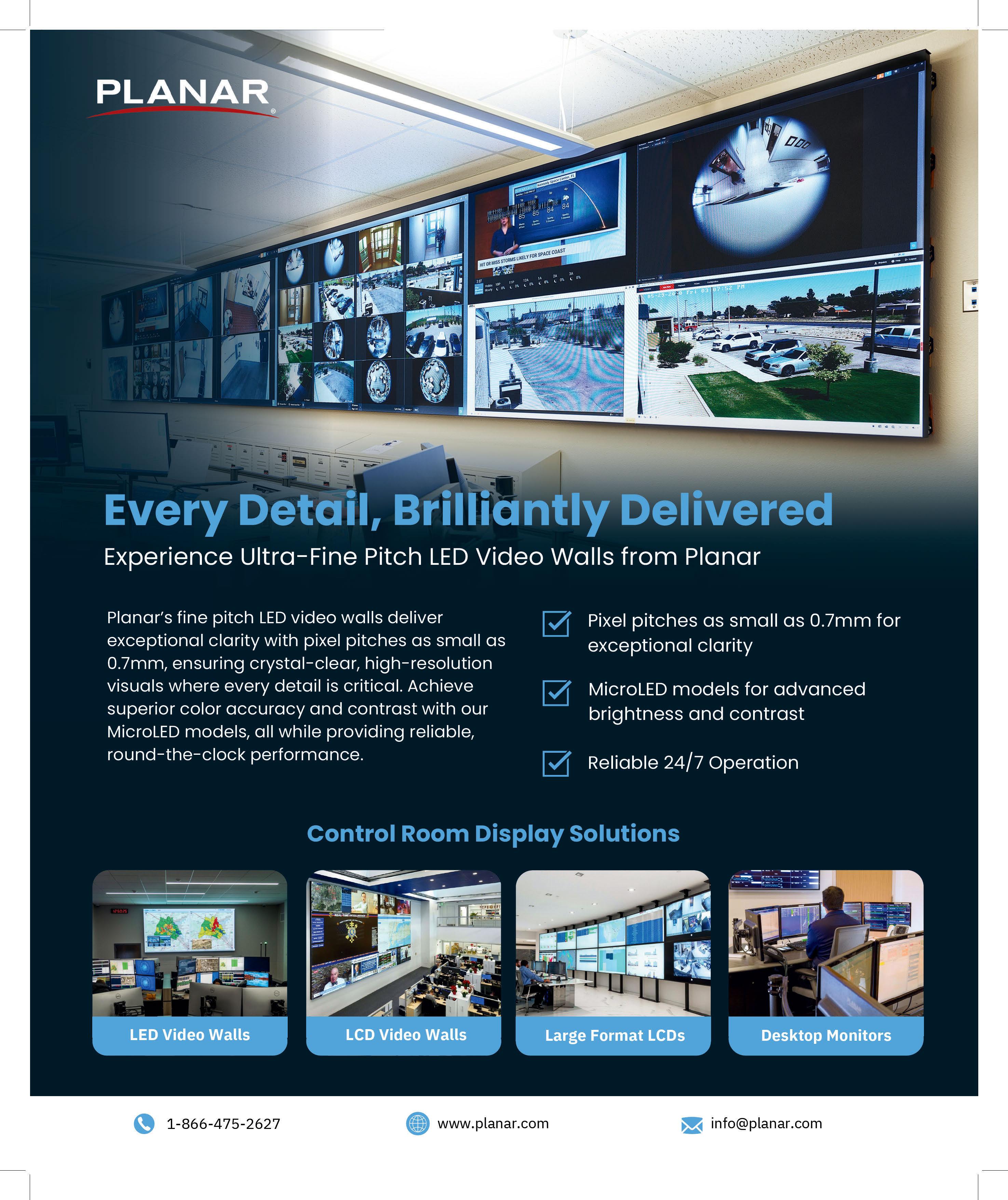
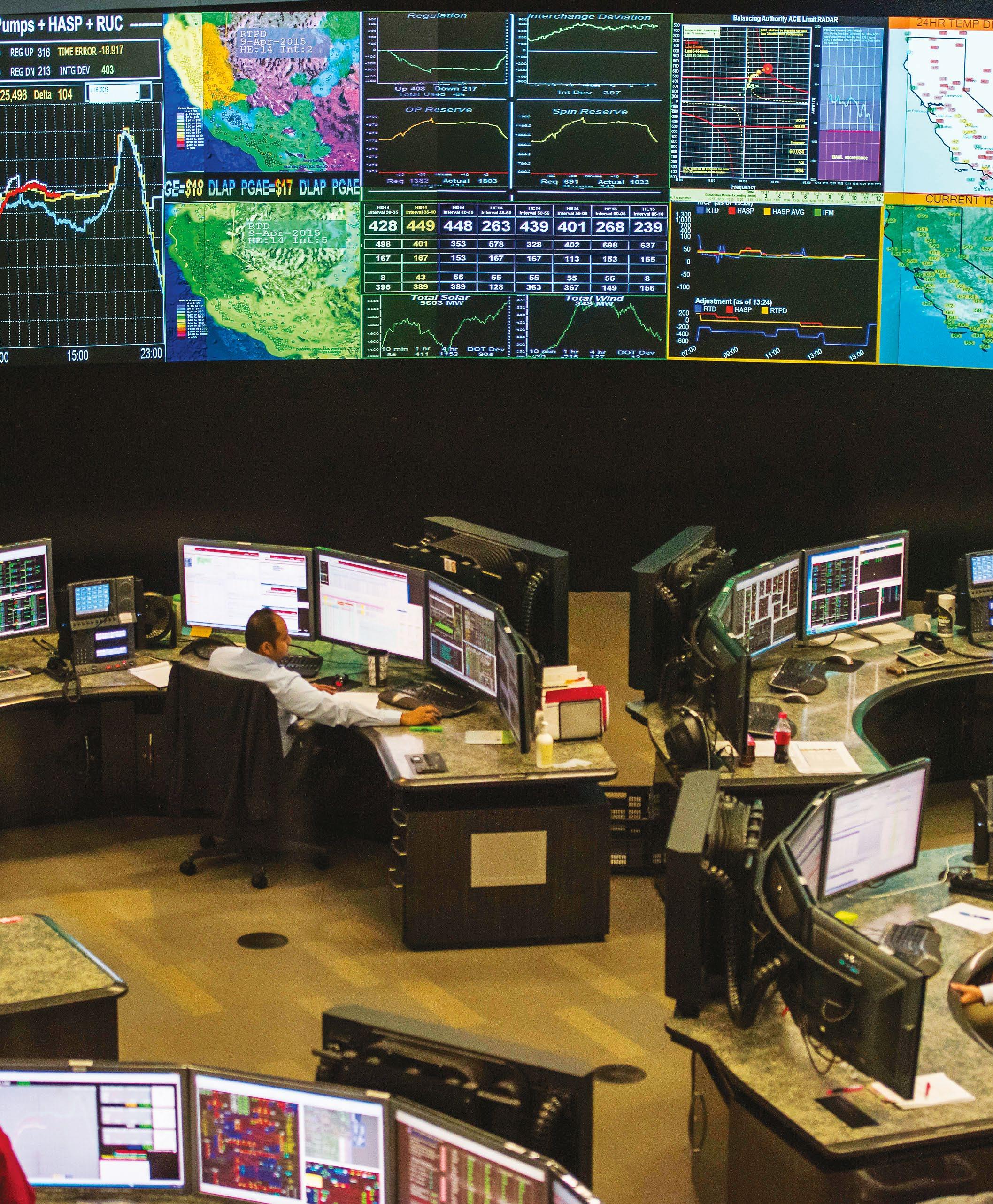
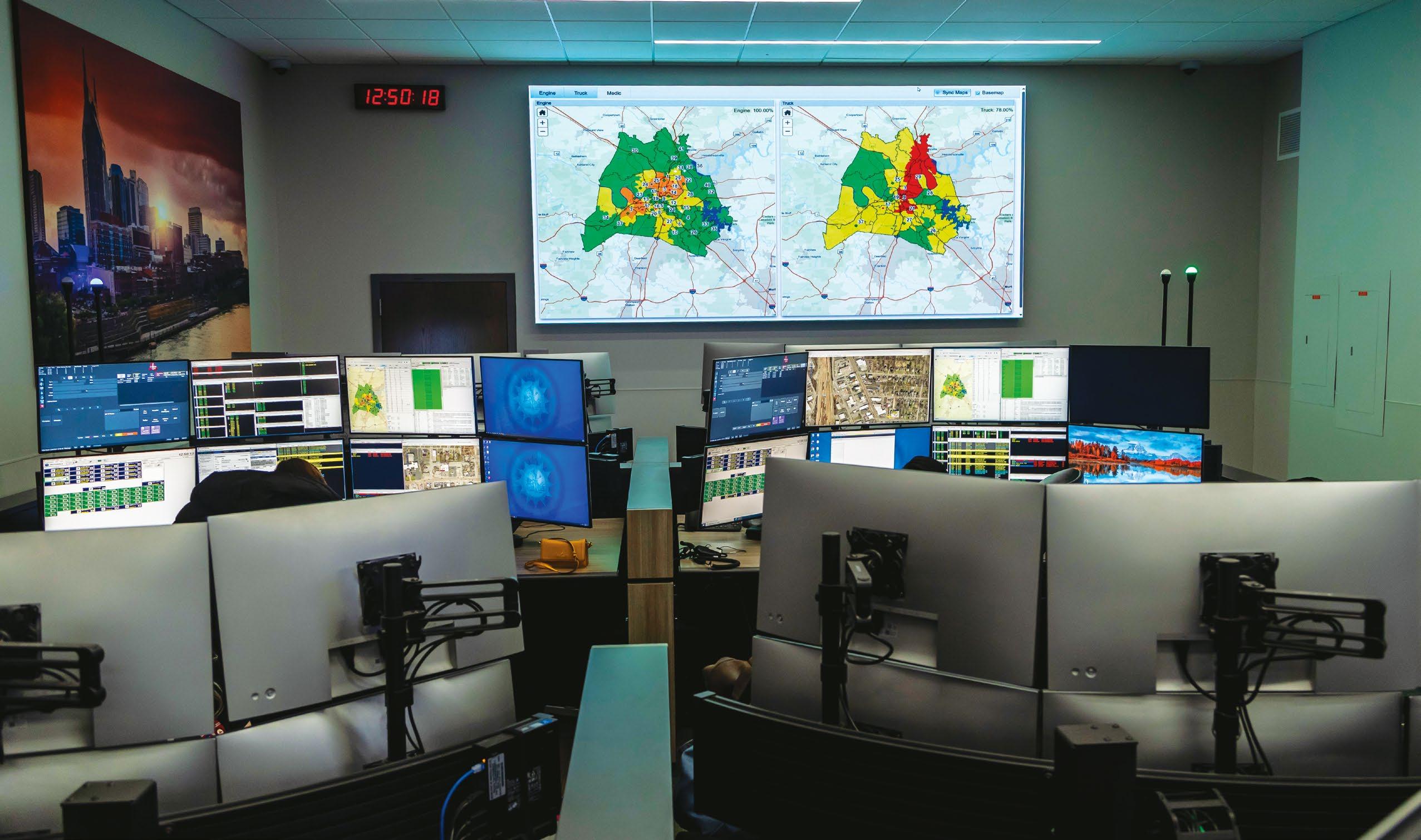
The Metro Nashville Department of Emergency Communications (DEC) serves an integral role in ensuring public safety throughout Davidson County and the greater Nashville area, and is responsible for responding to emergency and non-emergency calls, directing emergency response efforts and dispatching appropriate personnel. These activities are coordinated out of Nashville’s Emergency Communications Center. Due to aging facilities and outdated technology, DEC embarked on a full renovation of the Emergency Communications Center building.
The improvements included updates to the facility’s infrastructure and AV solutions and featured the addition of Planar fine pitch LED video walls to the operations room as well as an executive conference room.
The operations room is located in a long, rectangular room on the ground floor of the building. DEC’s original design plans called for 85-inch displays to be installed at each end of the space. However, DEC’s IT Manager Tim Watkins suggested an alternate solution that led to Planar.
Watkins advocated for LED video walls to ensure content visibility from anywhere in the room, eventually leading to the addition of two nearly 12-foot-wide, 6-foot high (6x5) Planar TVF Series LED video walls with 1.5mm pixel pitches.
“The LED video walls serve our goal of providing situational awareness,” Watkins said. “We can split the video wall into different configurations and present content in multiple ways.” Anthony Sallee, senior manager of AV
Systems and Integration at ACCESS Data Network Solutions, the project AV integrator, said the client’s redundancy needs were met by the missioncritical design of the Planar TVF Series. “The Emergency Call Center is a 24x7 operation, so that was definitely a factor,” he said. “And when you walk into the space, those video walls are the focal points— they are definitely impressive,” he said.
Data inputs to the Planar TVF Series LED video walls include live Tennessee Department of Transportation (TDOT) SmartWay road cameras; real-time fire engine/truck coverage monitoring and alerting for optimized response times; and an emergency and non-emergency queue board displaying current agent availability status, number of calls waiting and longest wait time. “We also regularly display the positive feedback we receive from the satisfaction surveys that we send to the public electronically,” Watkins said. “The responses allow employees to see what citizens are saying, which provides a great morale booster.”
In the executive conference room, ACCESS Data Network Solutions installed a nearly 10-foot-long, 6-foot high (5x5) Planar TVF Series LED video wall with a 1.2mm pixel pitch that incorporates the same level of functionality as the other Planar TVF Series LED video walls. The intent of the Planar TVF Series LED video wall is to support flexible uses, Watkins said. “It provides lots of options for that space, whether it’s situational awareness, board meetings, video conferencing, interviews, or press conferences,” he said.
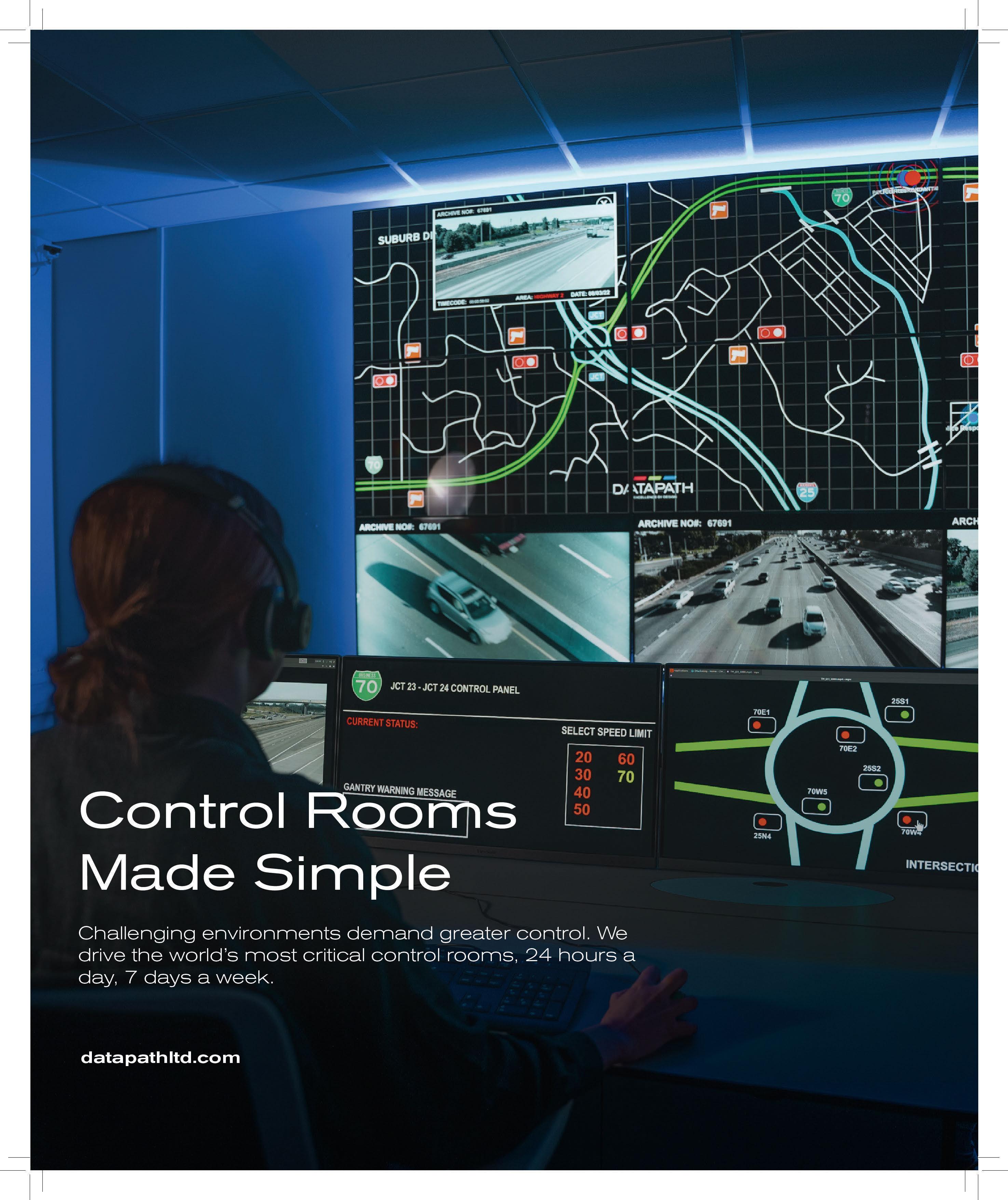
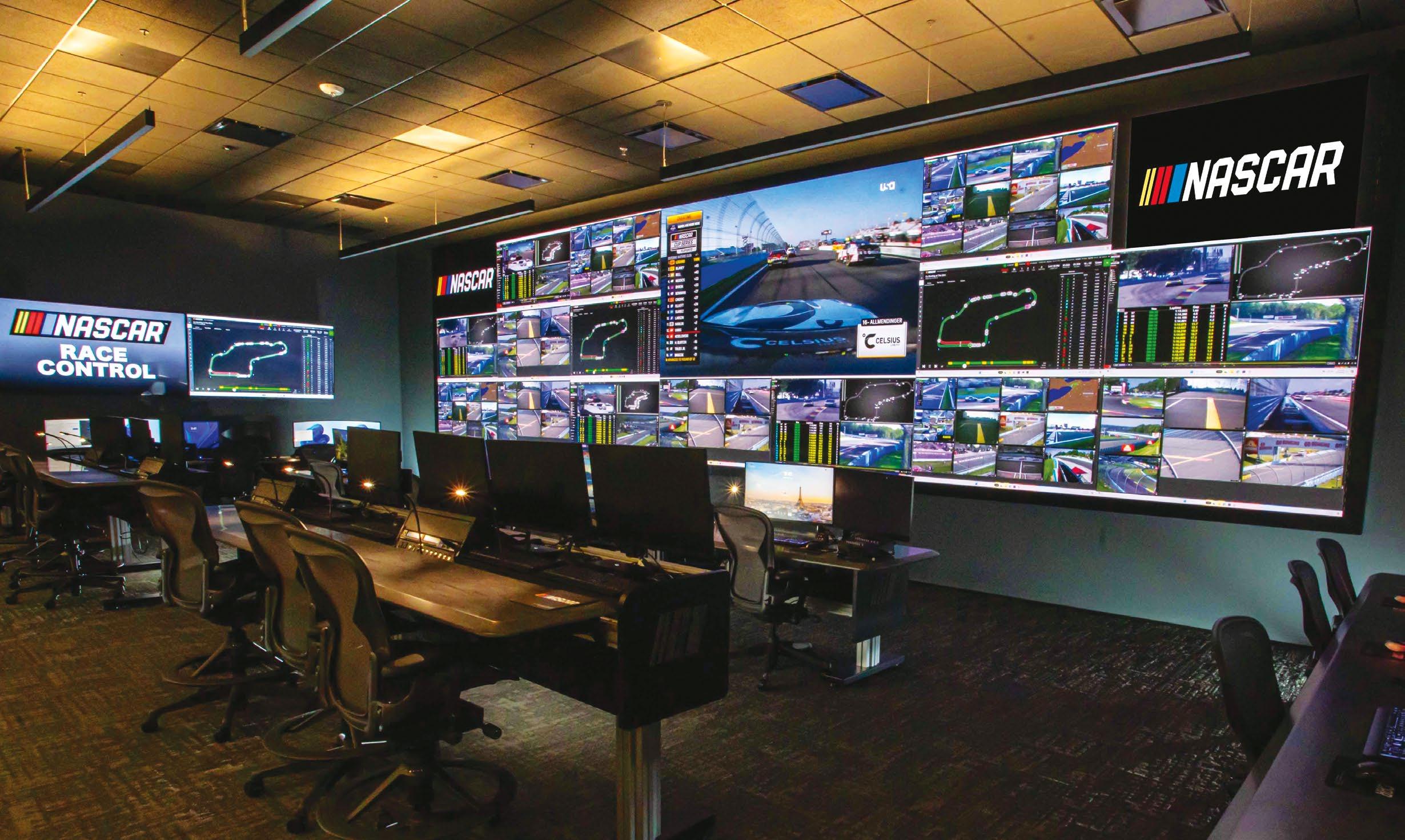
In January, Samsung became a NASCAR Technology Partner and will provide digital displays to elevate the NASCAR fan experience, racing operations, and enterprise processes. The multi-year partnership will begin with the introduction of Samsung’s displays and monitors for NASCAR Productions’ newly launched remote race control room.
Housed in NASCAR’s 58,000 square-foot production facility in Concord, N.C., the state-of-the-art control room features Samsung’s The Wall as its centerpiece, allowing officials to review comprehensive, real-time video, audio and data from the track and remotely officiate races. The installation of The Wall spans a noteworthy 32 feet wide and nine feet high.
The new control room sets the stage for NASCAR to remotely execute officiating in a precise and data-driven approach for large-scale races nationwide. During races, up to 24 officials in the room will use The Wall as their primary screen to access replays from the SBG Sports Software system, capable of aggregating up to 200 camera angles, all driver audio and voice-to-text transcription of team radio transmissions. The Wall’s true-to-life picture quality will deliver the footage and data with the finest level of detail, equipping remote officials with crisp and clear information to confidently make decisions on penalties and race results.
Remote officials in Concord, N.C., will remain fully immersed in the racing action via live feeds and intercom communications to consult with their
counterparts at the track. The Wall’s large-scale display provides the officials with a real-time view of information as drivers make their laps and pit stops. The screen will showcase a variety of data, including feeds from onboard cameras, Engine Control Units (ECUs), optical tracking cameras, Pit Road Officiating (PRO) systems and official cameras positioned at the pit, start and finish lines, restart zones and other key locations.
Officials will use a range of Samsung monitors to gather and analyze insights, including 25 models of the 27-inch ViewFinity S6 high resolution monitor and seven models of the 490-inch Odyssey G9 monitor. The ultrawide, curved Odyssey G9 monitors offer extensive screen real estate for officials to simultaneously view and assess multiple data sources, enhancing their ability to efficiently support track operations.
“Remote Race Control will give NASCAR officials unparalleled views of more than 200 camera angles with multiple data points from every car that were previously not available,” said Steve Stum, NASCAR Vice President of Operations and Technical Production. “It will also allow us to make competition calls faster and more accurately than ever before to ultimately help improve the product.”
The remote race control room was fully operational and debuted to support the 2025 NASCAR Cup Series that kicked off with the Cook Out Clash at Bowman Gray Stadium in February.

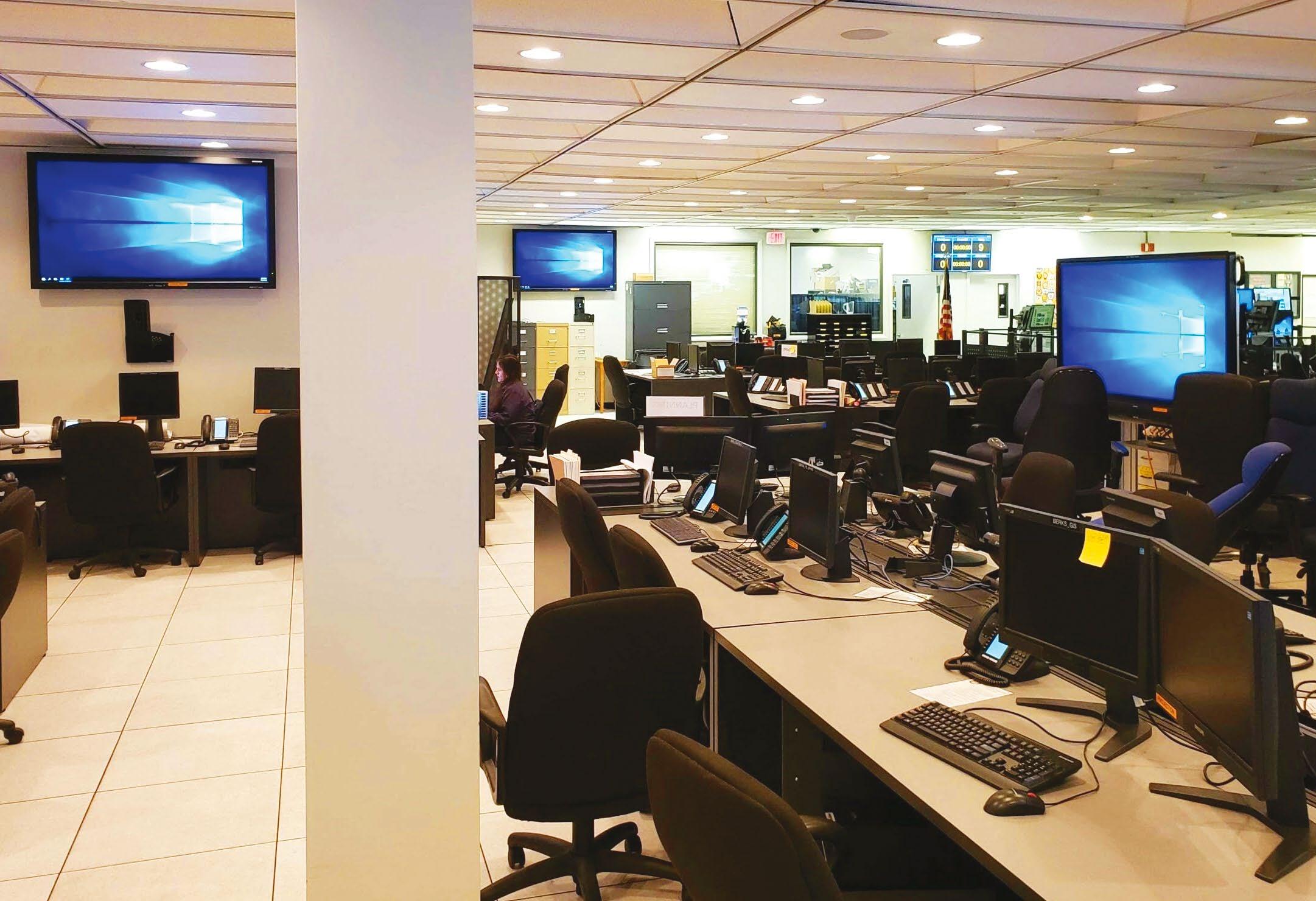
In the wake of recent global events, emergency response has become a focal point for businesses and municipalities alike. The trend toward creating more sophisticated and connected operations centers continues at a steady pace. In the Philadelphia area, this trend is driving organizations to invest in advanced audiovisual solutions to benefit control rooms of every size and scale.
Haverford Systems, a specialist control room integrator in the Philadelphia tri-state area, has worked with Datapath to provide a system for an emergency operations center in southeastern Pennsylvania.
Video walls play a pivotal role in bridging the gap between data and decision-making in emergency operations. With many 4K and HD video sources to view and manage, reliable control room technology is key.
“Staying ahead in emergency response is not just a priority; it’s a necessity,”
R.T. Chalfant, integration sales account manager at Haverford Systems explained. “As businesses and organizations strive to enhance their operational efficiency, the integration of cutting-edge technologies becomes a pivotal strategy.
“One such technology making waves in the emergency operations sector is video walls and video content management,” Chalfant added.
Datapath was selected to power the center’s 4K video walls and give operators the capability to display multiple inputs, in different layouts, on a choice of video walls.
Using Datapath’s WallControl 10 software, Haverford Systems created a system that allows operators to design their own bespoke content layouts, and switch among them seamlessly when circumstances and events dictate.
The emergency operations center in the Philadelphia area features three 2-by-2 4K video walls, with eight operator terminals managing 20 4K and HD sources. To manage the vast volume of video data with near-zero latency, Haverford Systems utilized Datapath’s VSN1172 video wall controller—an 11slot unit powered by a Core i7 processor and two 240GB SSDs.
Performing pixel duties inside the VSN, the unit is equipped with five ImageDP4+ graphics cards, five VisionSC-HD4 four-channel capture cards, plus a multi-channel ActiveSQX IP decoder.
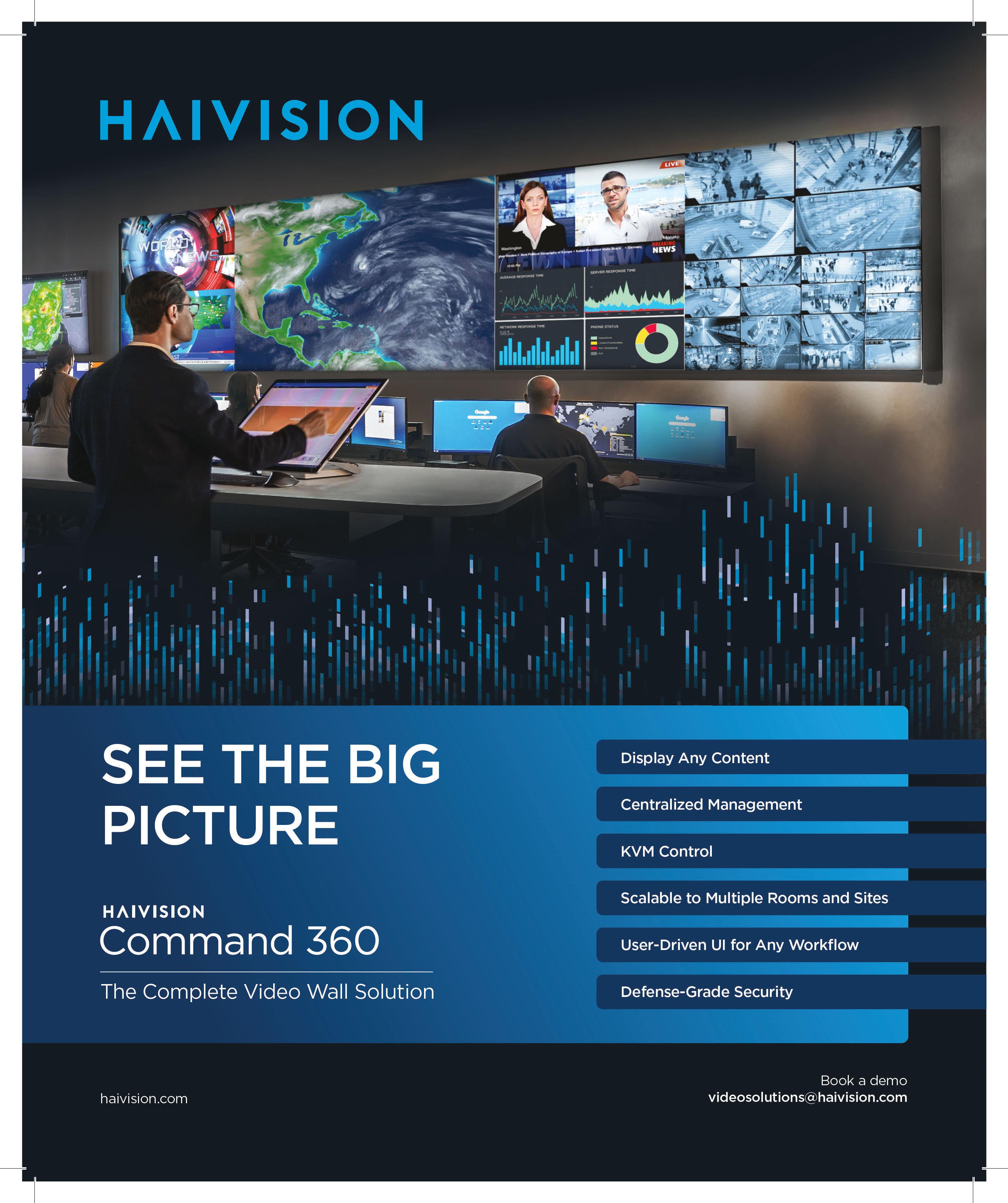
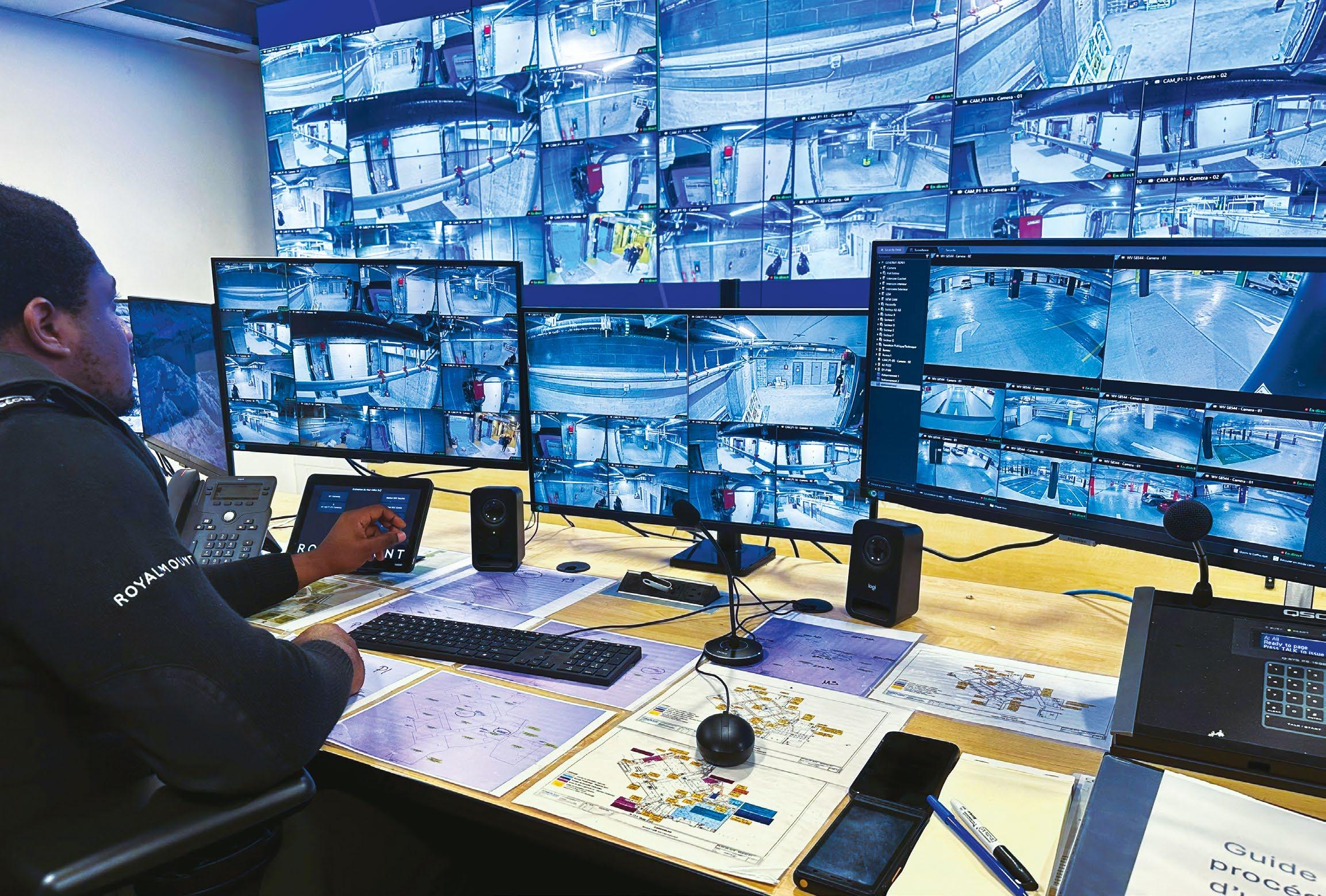
The Royalmount project in Montreal exemplifies how modern AV technology and control systems can support urban developments. As the second-largest mall in Canada, at 824,000 square feet of campus, the control center is a critical aspect of the site’s operations.
At the heart of Royalmount’s Security Monitoring Operation is VuWall’s video wall management, KVM, and visualization technology. VuWall’s solutions allow operators to monitor, manage, and respond to multiple activities across the complex in real-time from a single interface. The video wall solution also integrates with various AV systems for situational awareness, aligning with Royalmount’s commitment to safety, sustainability, and architectural harmony.
Royalmount’s Security Operations Center was seeking to build a state-ofthe-art security center that could handle real-time monitoring, complex site management, and integration across multiple systems, including Genetec’s video surveillance technology. Given the scale and diversity of operations, the project required a solution that balanced cost, performance, and architectural design.
VuWall’s video wall technology, specified and deployed by AV systems integration partner Solotech, plays a crucial role in addressing Royalmount’s security operations requirements for this new facility. The solution comprises
three VuWall PAK 40 Video Wall & KVM nodes, nine VuStream encoders, and a ControlVu touch panel, all managed by the TRx Centralized Management Platform. This system integrates with the Gentec Security Center, currently in version 5.12, thanks to TRx’s Genetec plug-in. This plug-in is used for the monitoring of real-time video from 1,560 surveillance cameras and is also capable of managing IP encoders, web apps, web maps RSS feeds, HDMI sources, and other computer sources.
VuWall’s system powers an expansive 5×2 video wall featuring ten Samsung VH55R-R thin bezel LCD displays. Additionally, the room is equipped with three operator desks, each outfitted with the 27″ displays, serving for both desktop control as well as video wall collaboration.
VuWall’s comprehensive video wall management and KVM solution has allowed Royalmount to achieve real-time monitoring of 1,560 cameras and efficient site management from their new, centralized Security Operations Center. Operators can monitor diverse activities across multiple systems throughout the site with enhanced situational awareness, streamlining decision-making, and improving response times. The integration of diverse AV systems into a single visualization platform not only improves operational efficiency but also maintains the project’s sustainability goals.


In southeastern Mecklenburg County, North Carolina, the Town of Matthews is a suburb of Charlotte known for its small-town feel, family-friendly entertainment, and renowned parks and recreation amenities. Every year, it hosts several annual festivals and special events. Traditionally, Matthews coordinated its emergency management and response from a space in the town’s municipal fire department. Its emergency operations are activated in response to extreme weather, large traffic issues and major events which can bring in upwards of a couple hundred thousand people to the small community. In April 2019, an EF-1 tornado hit the town, causing widespread destruction. That incident, combined with other significant weather events, helped prompt the idea to establish a formal operational space to better oversee the town’s emergency coordination functions, according to Major Roy Sisk of the Matthews Police Department.
Opened in 2024 and located in the Police Department, the town’s new Emergency Coordination Center (ECC) is a control facility for sharing information and managing response activities throughout the Matthews area.
“It allows Public Works, Fire & EMS, and the Police Department to convene in one location and better communicate with Mecklenburg County’s Emergency Operational Center,” Sisk said.
The central feature of the new ECC is a nearly 12-foot-wide, 7-foot-high
(6x6) Planar TVF Series LED video wall with a 0.9mm pixel pitch. Installed by AV integrator Inter Technologies Corporation, the LED video wall delivers a fine-pitch solution for monitoring real-time information and guiding operational decisions.
“The video wall gives them seven input sources and the ability to display four of them at any time,” said Randy Scott, Southeast regional director of sales and business development at Inter Technologies Corporation. “That was a big selling point.” Viewing distances were likewise very important, according to Dale Miller, director of design at Inter Technologies Corporation. “The 0.9mm pixel pitch is a major upgrade over what they had before,” Miller said.
Content sources displayed on the video wall include laptop and PC feeds, trailer-mounted and permanently mounted video camera streams, as well as visual data from dispatch and emergency management software. The ECC team can also easily switch among different screen layouts.
“The Planar video wall provides everyone in the ECC with a common frame of reference about the incidents taking place,” said Rob Kinniburgh, Matthews Fire & EMS Chief of Department. “When a large event occurs, we can coordinate our activities more seamlessly.”
For its inaugural kick-off, the Town of Matthews activated the new ECC and Planar TVF Series LED video wall to support a multi-agency law enforcement raid of an illegal gambling network throughout North Carolina, with arrest teams executing search warrants at multiple locations. “Having all the data visible in one location makes us more efficient,” Major Sisk said. “The information on the display is incredibly vivid, and the clarity is amazing.”
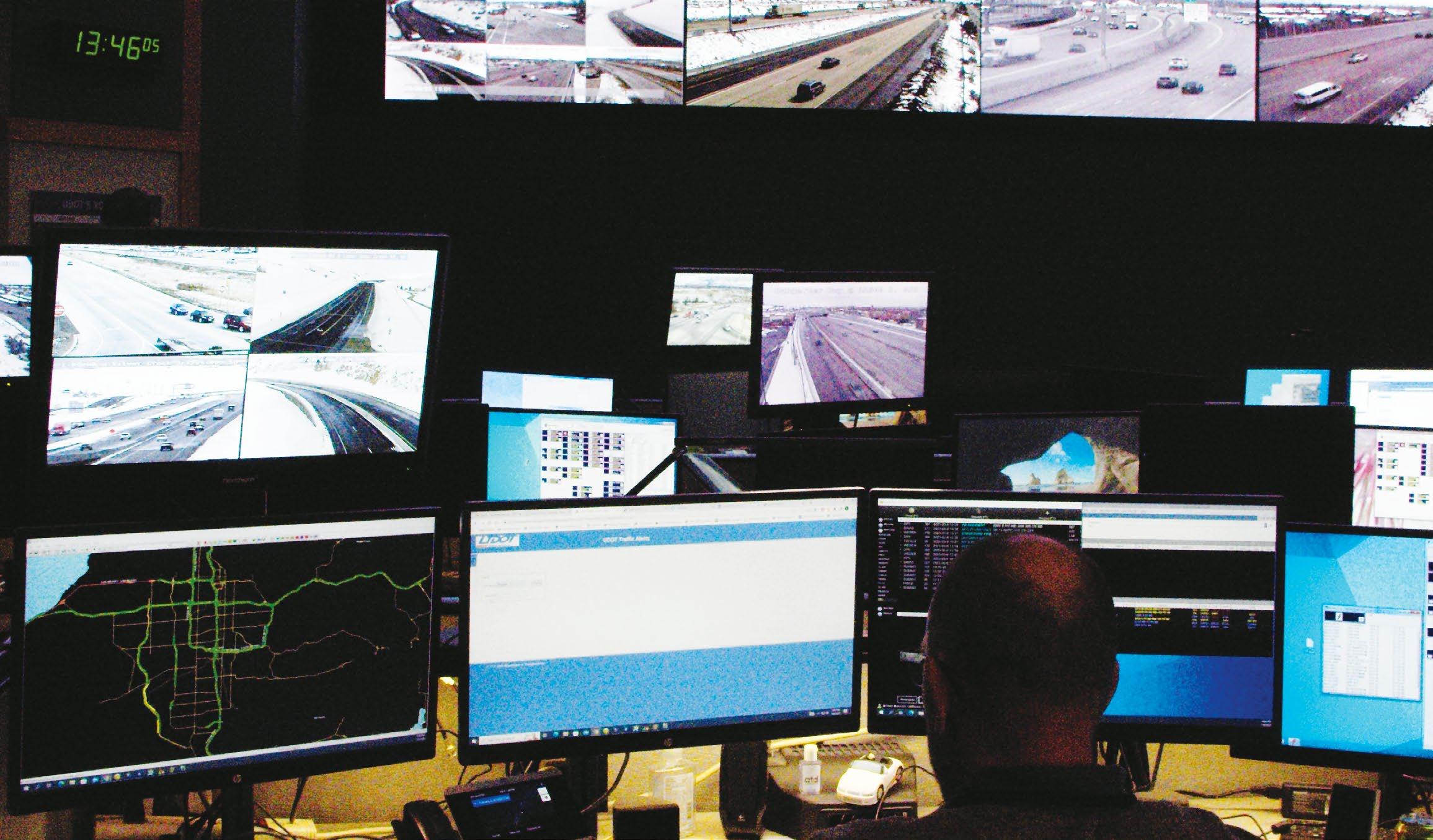
As the nerve center from where more than 1,700 traffic cameras are monitored for any signs of incidents requiring a swift response, the Traffic Operations Center in Salt Lake City performs a 24/7/365 mission-critical role supporting Utah highway safety. When the Utah Department of Transportation decided an update was necessary for the primary display capabilities at the center, they turned to AVPro Edge, alongside Salt Lake City integrator TVS Pro and their chief technology officer, Dalton Parker.
For this project, TVS Pro chose AVPro Edge MXnet 1G, one of the AVPro Edge Audio Video over Internet Protocol (AVoIP) ecosystems, to connect with, distribute, and manage traffic camera feeds from the Utah state roads and highways within the operations campus.
UDOT wished to replace its aging and dated rear-projection primary operations display system, originally installed by TVS Pro, with a newer type of video technology. The concept Parker’s team arrived at was a three-screen array centered by a massive multi-panel, cinema-dimensioned main display, flanked on each side by quite large auxiliary screens. The result is an impactful control room and video wall that unfailingly monitors the pulse of traffic flow all over the state.
Camera information arrives from locations dotting the Utah landscape and is received by camera decoders equipped with HDMI outputs. When users select a signal selected for more intensive viewing, it is patched via HDMI into one of 36 MXnet 1G encoders, which combine to create a virtual matrix
switcher for the 36 packetized, routable streams that are ferried across the network.
After routing, the streams are converted back into HDMI by MXnet 1G decoders. MXnet dispatches all signals at near-zero latency through its multicast routing.
Using MXnet as a transformative virtual matrix, the MXnet 1G decoders subsequently supply camera content to 32 inputs of a tvONE CORIOmaster2 video wall processor, which generates the video canvas. Touch panel control enables operators to efficiently customize images to conform to the needs at hand, with overlay, picture-in-picture, multi-picture, and multi-size capabilities, or a solo full wall image. The CORIOmaster2 then passes all outputs through to an additional signal processor that interfaces with every display panel to provide connecting paths from the CORIOmaster2.
For eco-conscious government agencies, a great deal of importance is placed on the environmental impact a wholesale equipment changeover might present, and often there are restrictive limits placed on the amount of additional power consumption a remodel or new project is allowed to assume. TVS Pro points to the highly efficient MXnet encoders and decoders as a decisive advantage. Each unit siphons less than 5 operational watts from the power grid, running cool to the touch from utilization of the metal chassis frame working strategically with the main processing chip, and its topmounted heatsink, to efficiently extract heat and disperse it quietly, fan-free, and noise-free.
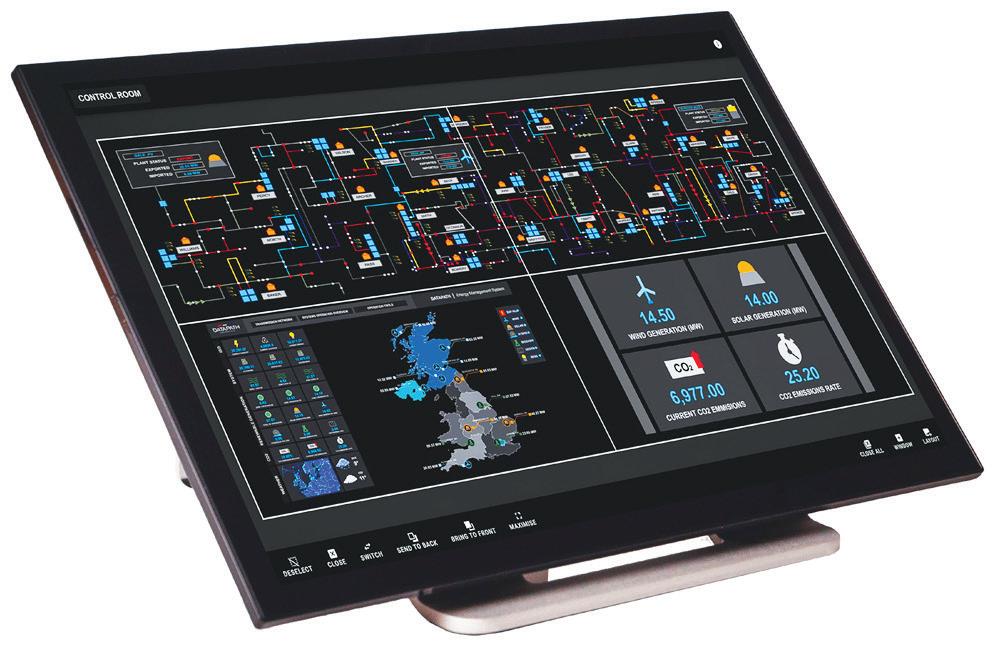
The Aetria Touch panel allows quick, easy management of content displayed on any video wall within the Aetria environment. The 10.1” touch panel is designed to sit on an operator’s desk or be affixed to a wall and connects directly to the Aetria control network via an Ethernet connection with optional POE. Secured using device encryption and Aetria User Rights Management, users can select the video wall they’d like to manage and open and close layout files as the situation demands. Access to Layouts, Templates, and all Source types is available to all Aetria Touch users. The additional, optional Aetria Touch Pro interface allows users to open sources as individual windows and use touch gestures to place them on the wall, sizing and positioning them as needed. For whole-wall collaboration, windows can be quickly maximized across the video wall when an issue occurs and restored to their original position once the situation is resolved.

Debuting this year, the Matrox Video Avio 2 is the world’s first open standards-based IPMX/ST 2110 IP KVM extender. The newest addition to Matrox Video’s IP KVM product line, the Avio 2 HDMI IP KVM extender supports up to 4K60 4:4:4 resolution, delivering realtime remote performance. Its open standard design claims increased quality, interoperability, and flexibility for applications including pro AV/IT, medical, broadcast, and high-quality media production. Avio 2 integrates with existing infrastructure and scales efficiently for installations of any size. Enabling secure, real-time KVM-over-IP extension and switching over 1GbE, and supporting true uncompressed 4K 4:4:4 over 10GbE networks, the Avio 2 IP KVM extender is suitable for the most demanding applications, such as handling of detailed content that requires high-color fidelity and image quality. It supports multiple codec options, including JPEG XS. As part of the IPMX standard, Avio 2 supports NMOS, an open API for device discovery and connection management.
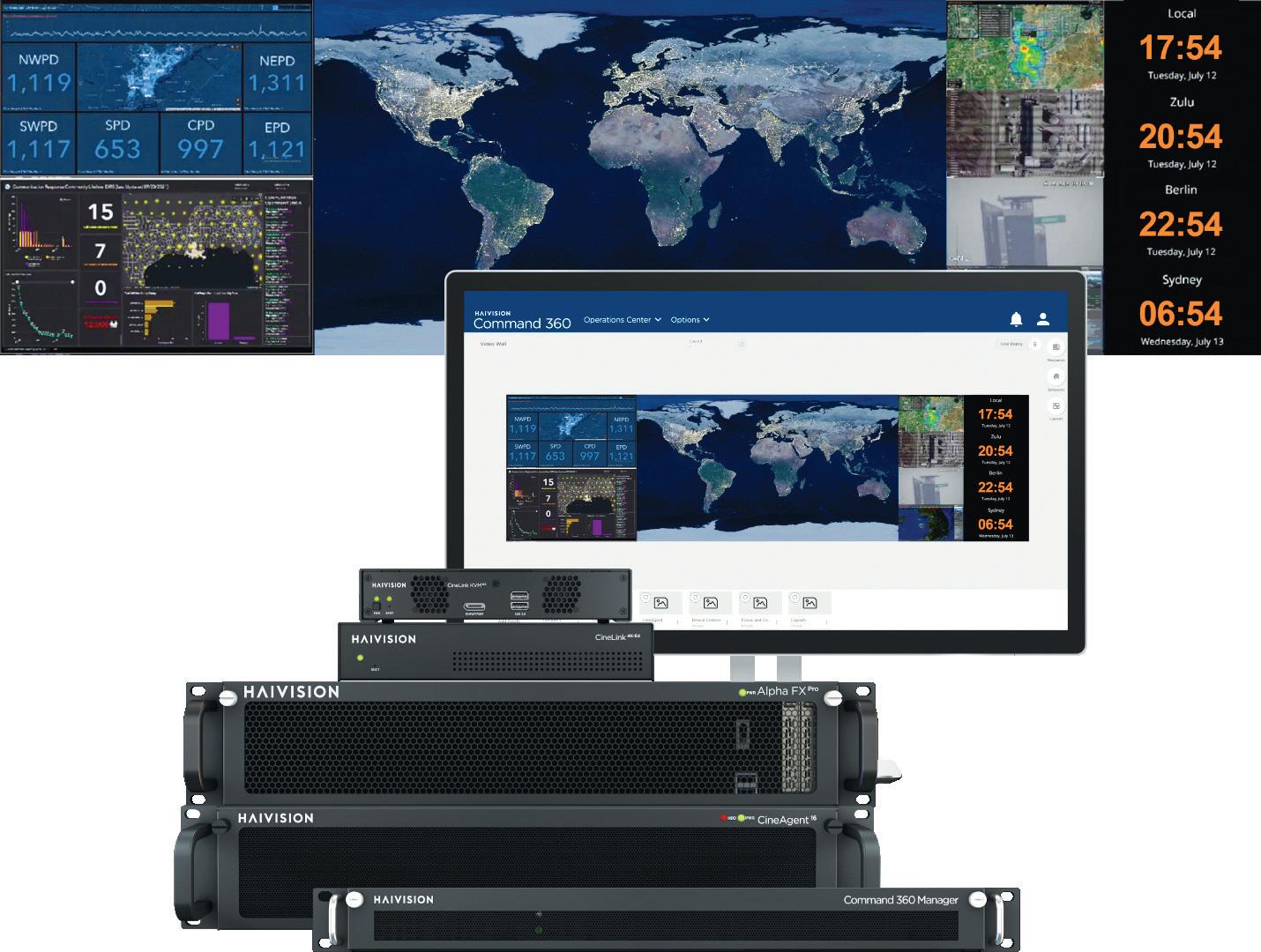
The Haivision Command 360 is an intuitive video wall software platform that powers Haivision’s end-to-end video wall solution. It works with purpose-built hardware to give enterprise teams realtime visualization of business-critical information on video walls in operation and command centers. Users can establish a common operating picture to instantly view and resolve critical situations such as cyber-attacks, security breaches, and fraudulent activity alerts. Users can easily visualize content on a video wall display, set user permissions and access, dynamically change sources, and establish a common operating picture to collaborate with local colleagues or geographically distributed teams. The platform supports presets, multiple layout options, and scheduled workflows. Complying with defense-grade and enterprise zero-trust model standards, Command 360 allows users to configure settings to align with their organization’s security posture.

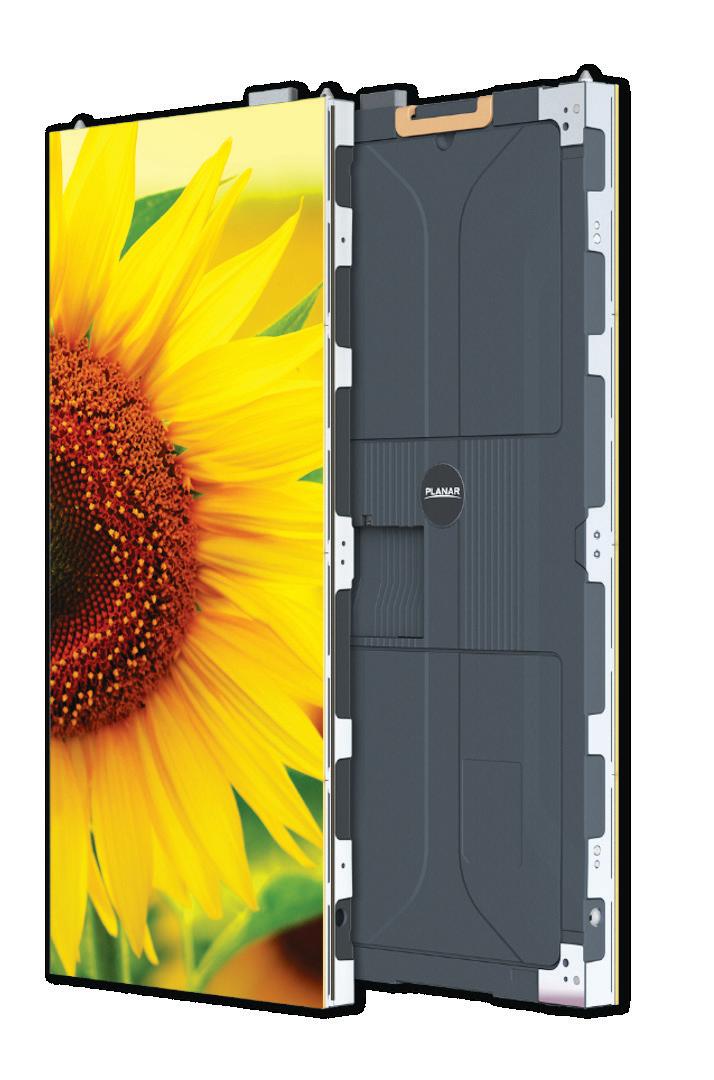
Featuring an ultra-thin, narrow-width form factor, the Planar DirectLight Slim Series accommodates curved and spaceconstrained applications. Models feature MicroLED technology and are available in 0.9, 1.2, 1.5, and 1.8 millimeter pixel pitches with a maximum brightness of 1,600 nits and a unique 4:9 aspect ratio. A new low-power model is also available and optimized for energy-conscious customers as well as environments with low ambient light conditions, delivering 500 nits of brightness while consuming just 68 watts of power. Customers also benefit from an installation depth of less than two inches, claiming minimal color shift compared to other LED displays.
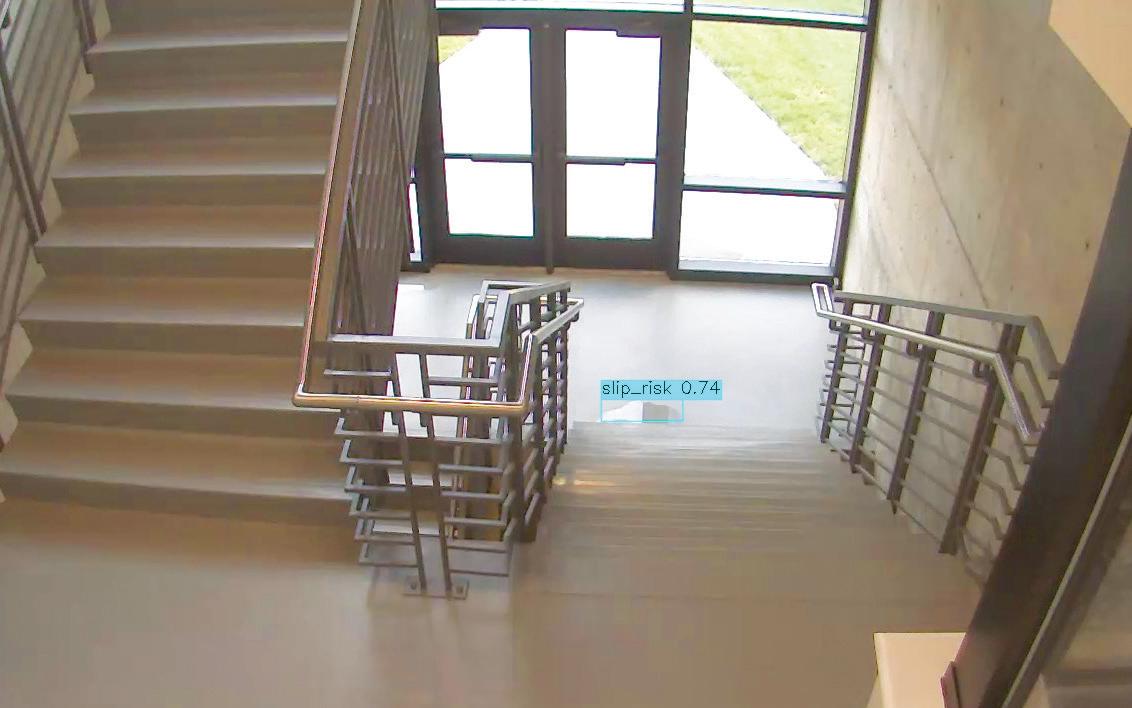
The IntelliSee AI Risk Mitigation Platform enhances existing video surveillance systems by continuously monitoring live camera feeds for real-time threat detection. The IntelliSee platform protects organizations and facilities against day-to-day risks, including slipping hazards, fallen persons, trespassing, loitering, unauthorized vehicles, and more. IntelliSee is also used for threat detection and notification regarding critical incidents like weapon detection and violent actions. For these urgent threats, IntelliSee can trigger lockdowns and emergency communications, as well as notify first responders. When integrated within an AtlasIED mass communications ecosystem, IntelliSee capabilities can be amplified to automatically broadcast pre-recorded PA announcements, send desktop notifications, contact local authorities, send SMS text messages, and more.
Developed by Guntermann & Drunck (G&D) in collaboration with sister company VuWall, VisionVS is a dual-encoding appliance that combines video wall visualization and KVM control into a single, compact solution. Designed to reduce system complexity in control room environments, VisionVS captures KVM sources and transmits them as a G&D bluedecTM stream to G&D KVM matrix systems, while simultaneously outputting a proprietary VuWall stream to VuWall’s PAK processors for video wall visualization, KVM operator stations, or remote access. This single-appliance solution bridges the gap between the two ecosystems, enabling near-zero-latency video quality with the ability to stream content to remote locations, while reducing the amount of hardware required, and minimizing cabling and component count.

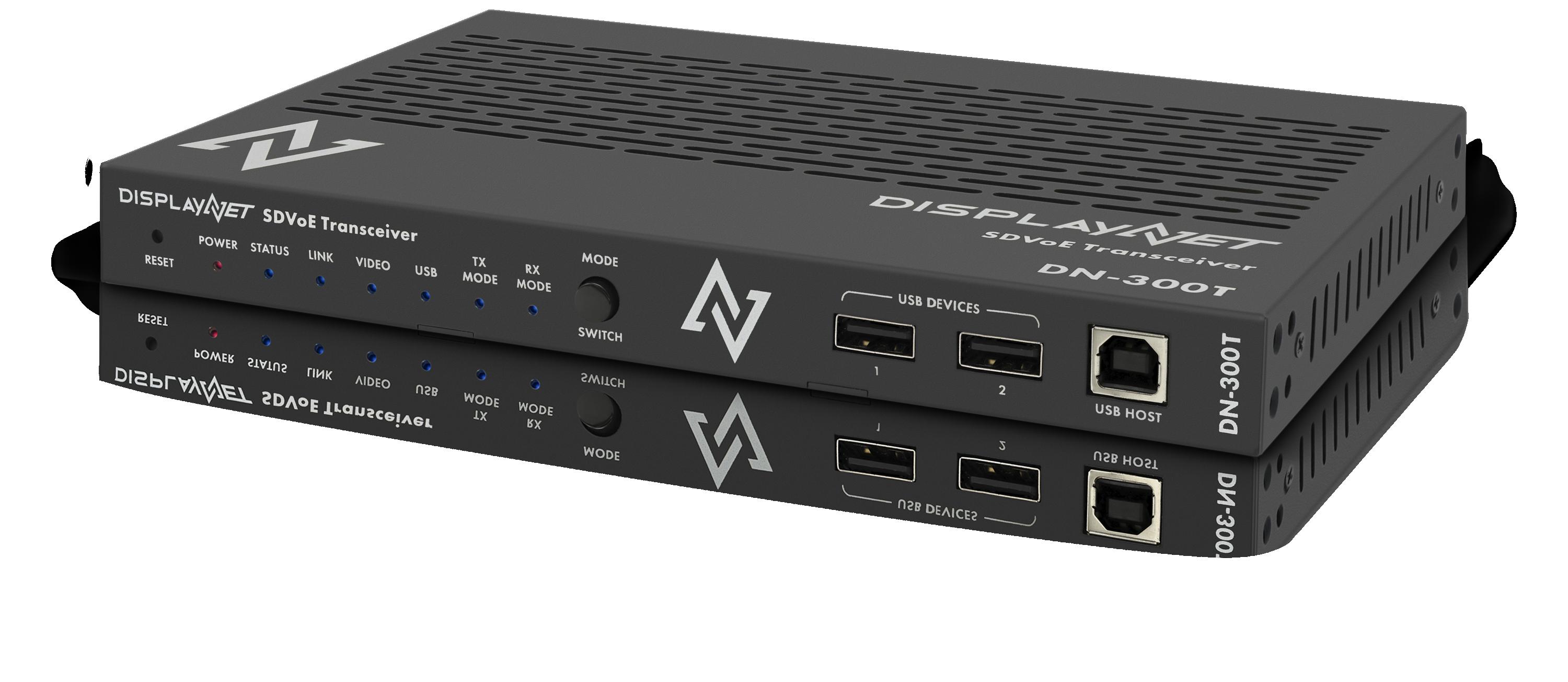
The DisplayNet DN-300 Series delivers an unprecedented level of AVoIP performance, versatility and reliability— at a price point that defines the industry benchmark for value. Based on the latest SDVoE technology, the DN-300 Series provides 4K/60 (4:4:4) video distribution with limitless scalability, zero-frame latency and zero image artifacts.
These units offer unique features that provide system designers with exceptional versatility:
Switchable Transmitter / Receiver operation
Bi-directional Transceiver mode (DN-300T)
Dual (copper / fiber) 10G network interfaces
Long Range: 100 meters (copper), 30 km (optical)
Auxiliary H.264/5 video output streams
Powerful network security features

PoE+ support
Silent, fanless operation
Ultra-compact, rackmountable case
Versatile KVM Routing
DN-300H: USB HID device instant switching
DN-300T: full-bandwidth USB 2.0 routing
DisplayNet also provides software-defined MultiViewer and Advanced Video Wall engines that power a wide range of applications without the expense and complexity of ancillary products. A highly intuitive web-based UI and API greatly simplifies setup and installation, as well as integration into third-party control systems.
Contact us today to see how DisplayNet can move your next AV system into the future.
sales@dvigear.com
(888) 463-9927
www.displaynet.com















The new Cleerline SSF-TKITE-200 Basic Fiber Testing Kit is designed to support technology integrators in the field as they install a single-mode or multimode fiber optic network infrastructure. The new Cleerline test kit enables installers to ascertain cable and termination integrity onsite, quickly determining signal dB loss over distance using an OLS (optical light source) OPM (optical power meter) testing platform. four testing wavelengths (850, 1300, 1310, and 1550 nm) and a range of 70 dB, this kit simplifies optical power loss calculations, making it ideal for quick, general qualification and troubleshooting. For more comprehensive needs, the Cleerline SSF-TKITP-500 Certification Kit offers detailed fiber certification in accordance with TIA-568-C standards. Via OLS and OPM, this kit measures link loss and stores up to 1000 test records. Its PC software enables easy data export, and it comes equipped with both SC and LC adapters for versatile testing options. Both kits are designed for ease of use and durability.
The SSF-TKITE-200 comes in a compact, rugged case for field portability, while the SSF-TKITP-500 includes advanced features like built-in VFLs, LED flashlights, and rechargeable batteries. For fiber end face verification, the Cleerline SSF-MICRO-400X includes adapters to verify 1.25mm or 2.5mm ferrules. For a more advanced and versatile inspection needs, the Cleerline SSF-MICROV-250X features a digital screen as well as adapters to verify the connector itself or behind the adapter plate.
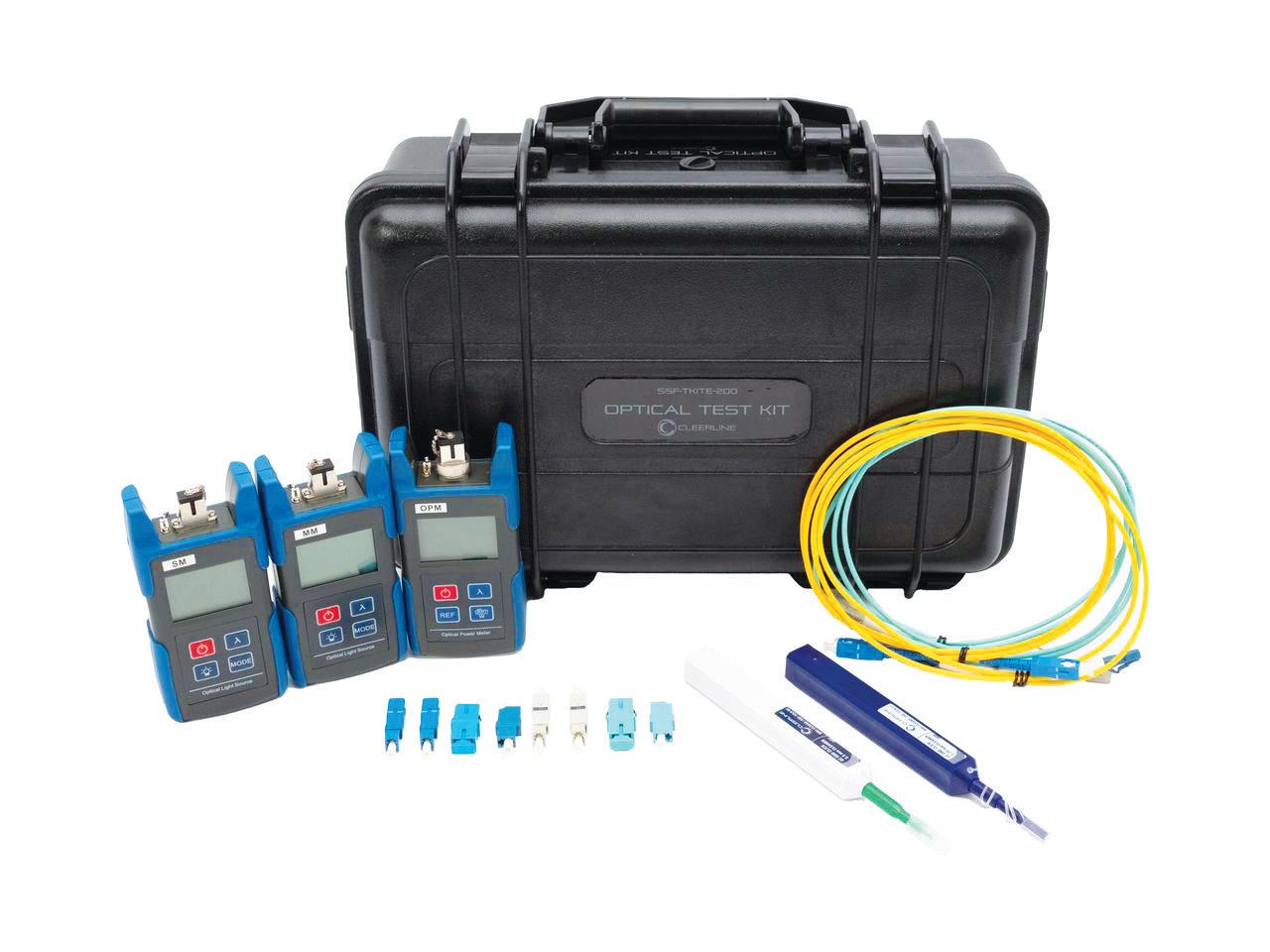
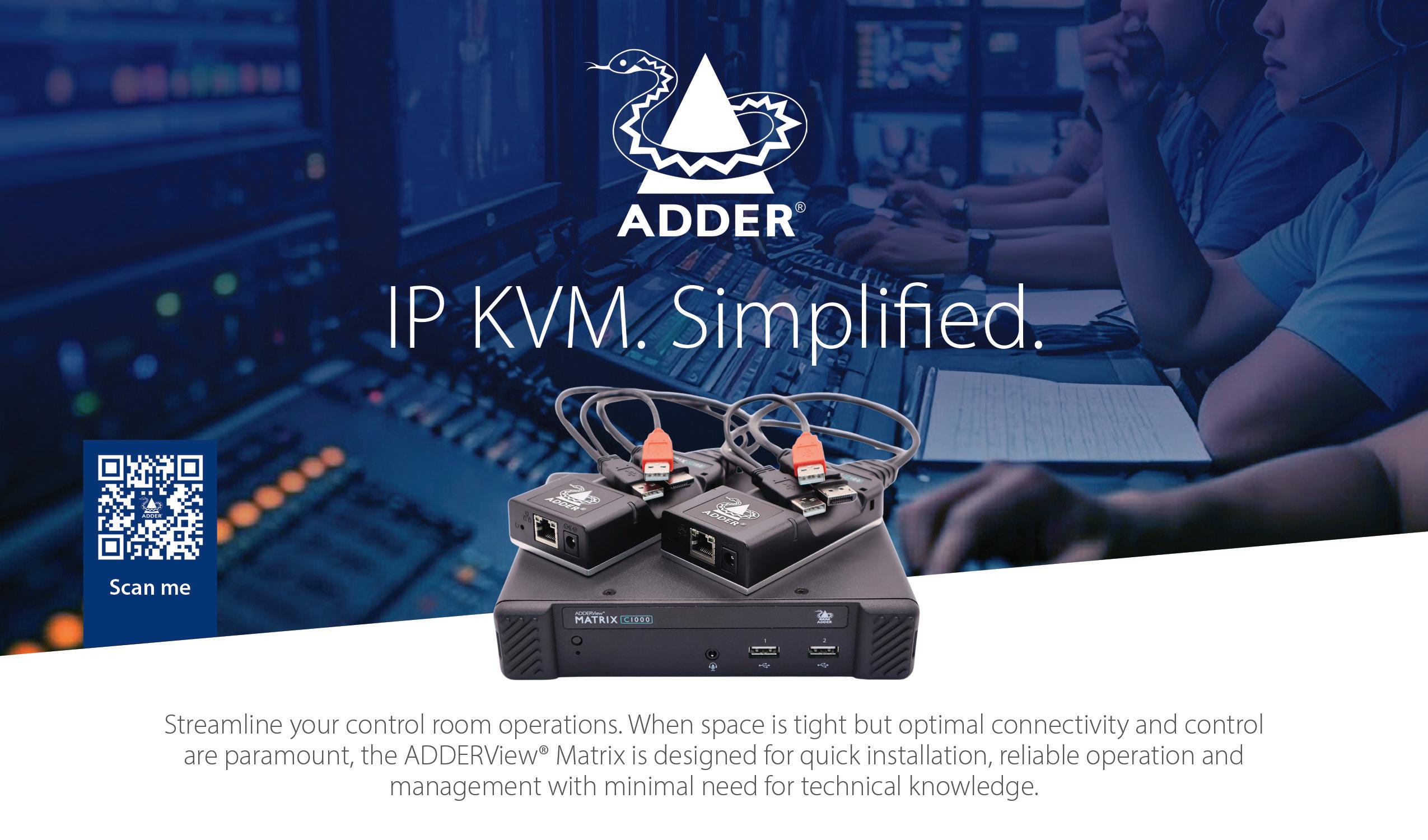
Designed in response to customer needs, the new ADDERLink XD C650 is a KVM extender that enhances the remote capabilities of the XD 600 series. The new extender combines features previously only available separately in other products in the ADDERLink series; it supports quad-head video as well as enhanced transparent USB capability to support a wider range of USB devices, including USB audio headsets. The product is positioned for organizations where multiple screens are required for detailed data visualization and two-way audio connectivity is needed for mission-critical environments. Connectivity includes CATx and fiber. The product supports 4K KVM, and both digital and analog audio.
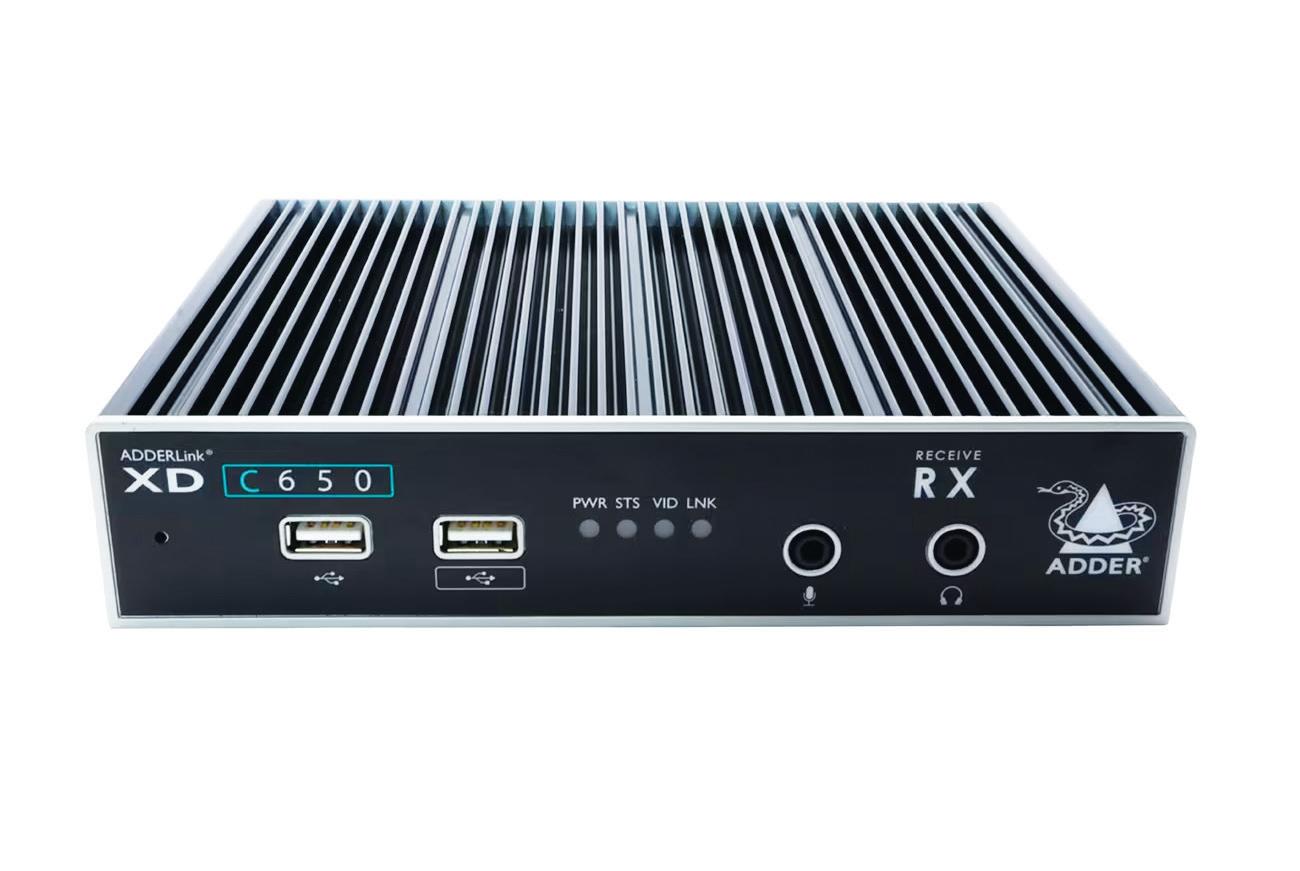
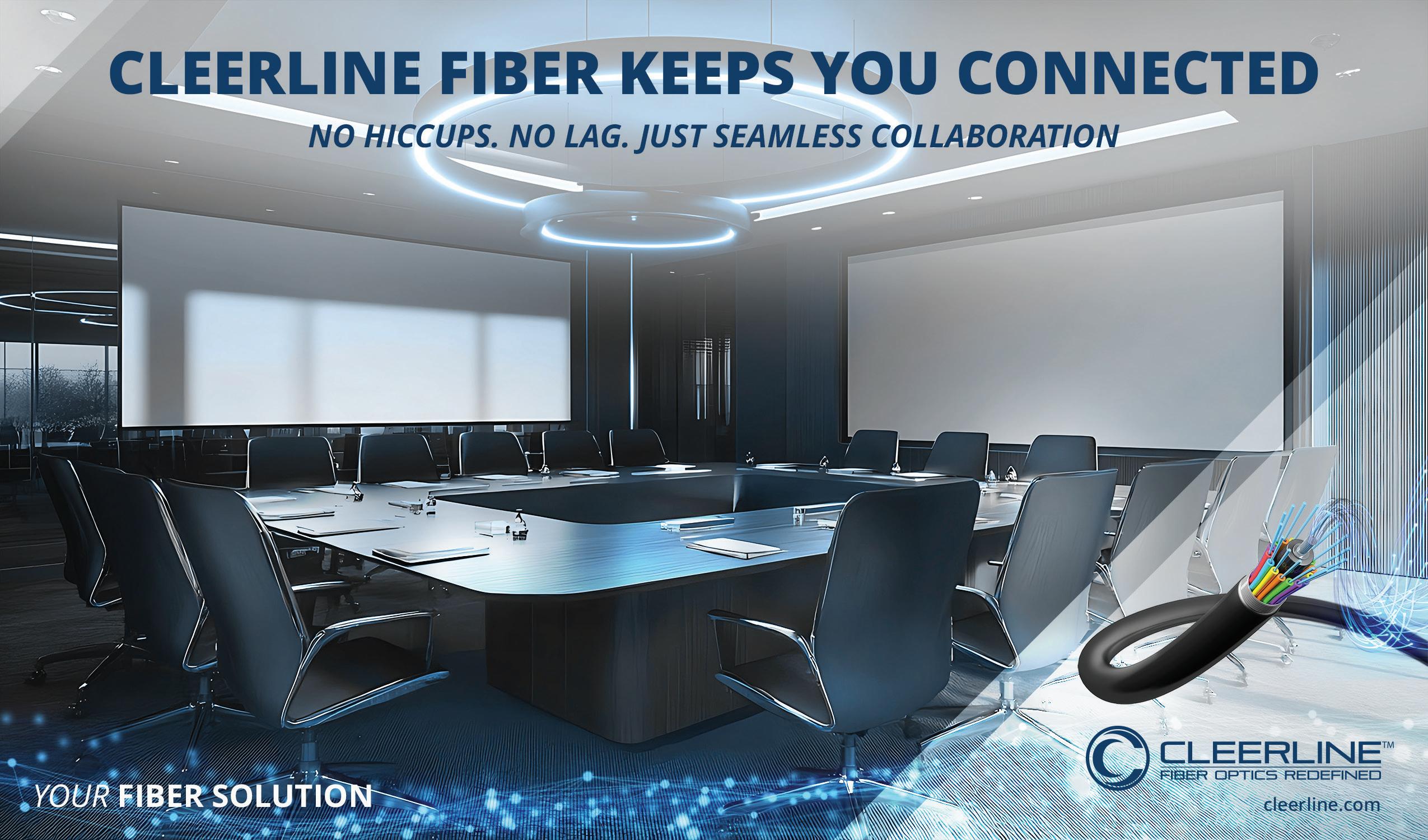
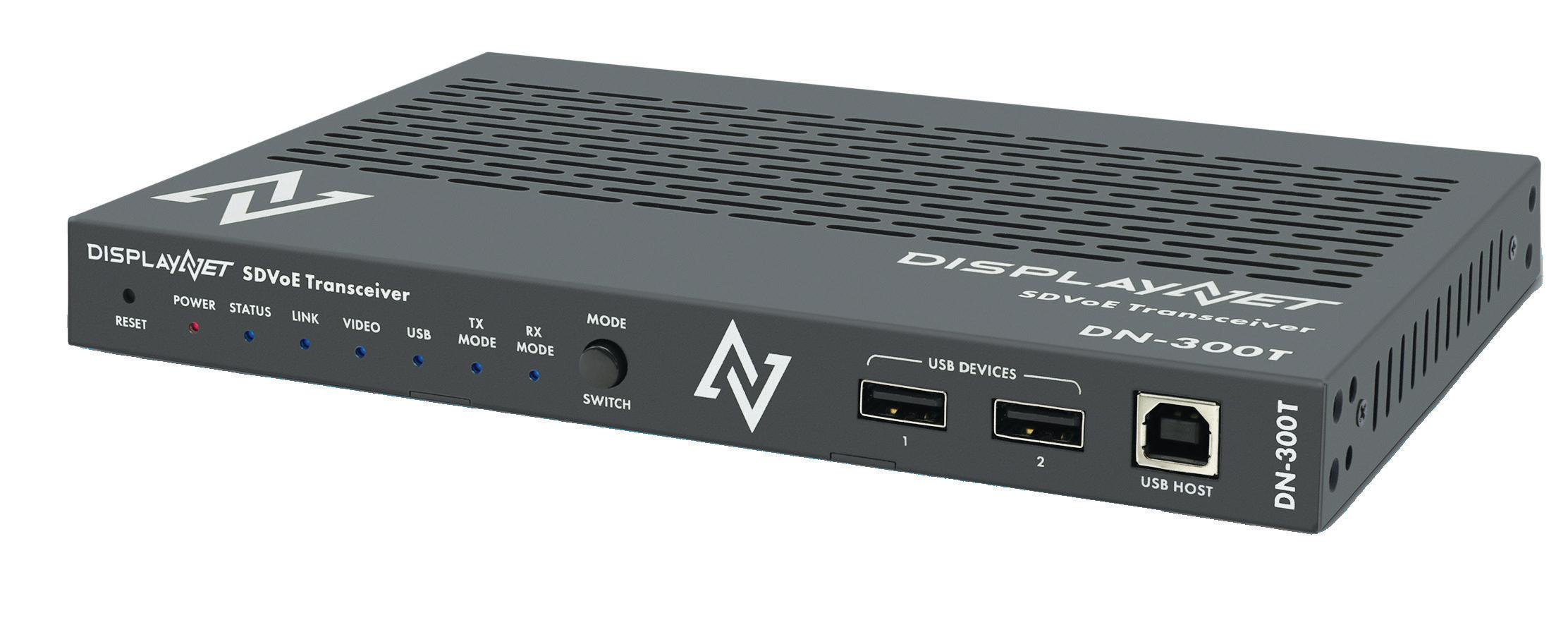
This transceiver utilizes SDVoE ASIC technology to offer simultaneous TX/RX operation. Like all DisplayNet products, it provides 4K/60 (4:4:4) video distribution with limitless scalability, zero-frame latency, and zero image artifacts. The DN-300T is a fully bi-directional Transceiver and can simultaneously send and receive AVoIP data. (It can also be used in dedicated Transmitter and Receiver modes). Compatible with all DN-300 Series models, it has an ultra-compact, low-profile form. Features include PoE+ support, and dual (copper/fiber) network interfaces that enable signal extension distances of up to 100 meters (328 ft.) with CAT-6A twisted pair and up to 30 KM (18.6 miles) with single-mode fiber. The unit includes auxiliary H.264/5 video output streams that provide support for viewing source thumbnails and for remote viewing/recording with resolutions up to 1080/30p. Its compact fanless size means that 4x units can occupy a single 1U of rack space. DisplayNet includes software-defined MultiViewer and Advanced Video Wall engines that power a wide range of applications without ancillary products. DisplayNet Server manages the entire DisplayNet system. It includes the DisplayNet API Engine, which supports the use of DisplayNet Manager, a web-based software application for system setup and configuration. The DisplayNet platform is highly customizable, with adaptive software and firmware development.
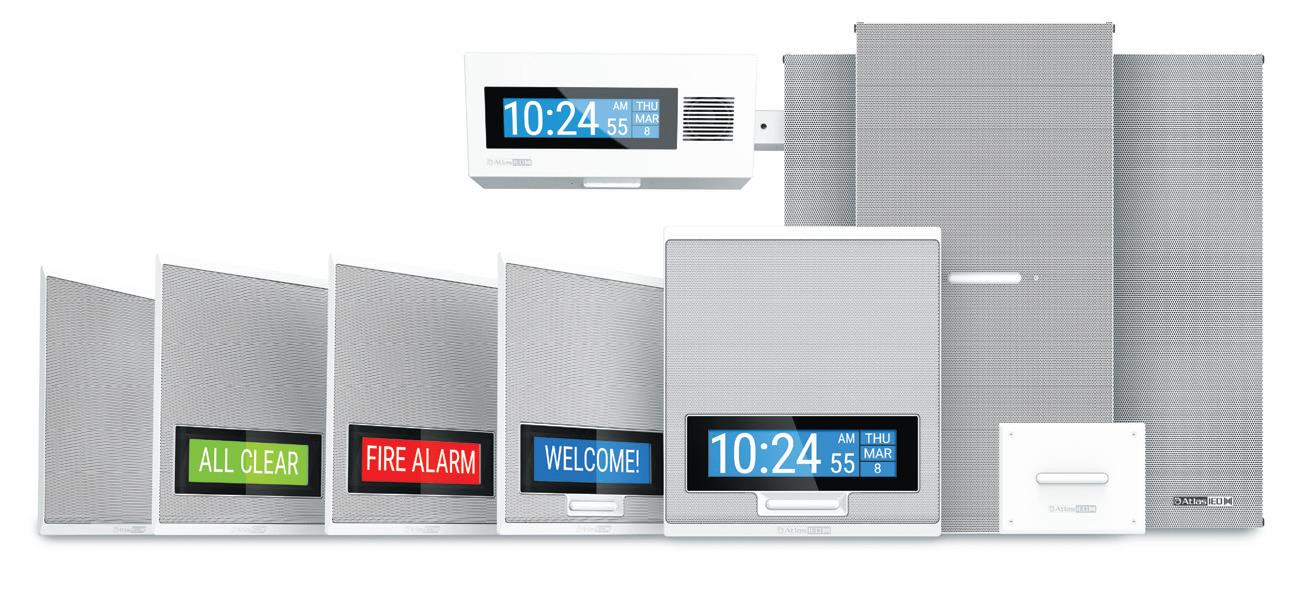
This IP KVM extender forms part of the ALIF matrix solution. It enables the relocation of critical computing hardware into a secure and temperature-controlled environment away from the user workstation. The ALIF4001 can deliver two 5K video resolutions and ultrawide video resolutions (5120×1440@60Hz or 5120×2880@30Hz) or higher refresh rates of up to 240Hz (HD@240Hz) over a single IP connection. Using a spatially lossless encoding system, with 1:1 pixel mapping, the ALIF4001 provides color-accurate video with no artifacts. The ALIF4001 supports 10-bit color (or 30 bits per pixel) and supports both SDR10 and HDR10. The ALIF4001 supports 1GbE and 10GbE over fiber via the SFP slots, along with Multirate (1/2.5/5/10) GbE for AV over CAT6 cable up to 100m. Each ALIF4000 series unit can be configured as an extender or self-managed distributed KVM switch. Each receiver can see up to 16 sources and rapidly switch among them.
Designed to complement AtlasIED’s IPX platform of IP endpoints, InformaCast delivers audible and visual alerts to both on-premise and mobile devices for quick distribution of information concerning lockdowns, evacuations, intruders, live shooters, severe weather, and other critical situations. Panic button and wearable devices are compliant with Alyssa’s Law. InformaCast is engineered to integrate with existing VoIP and other traditional networks, enabling integrators to implement a complete emergency notification system within legacy systems. As a distributor of the Singlewire InformaCast software, AtlasIED’s Engineered Solutions & Services department is available to assist integrators with the design and implementation of InformaCast and IPX.


Matrox released the Luma Pro A380 Octal to drive four 8K displays or up to eight 5K displays from a single slot. The compact card enables high-density display setups, freeing up PCIe slots, and making it easier to build systems using standard workstations. Combining Intel Arc GPU media engines and Matrox Mura software libraries, LUMA Pro A380 Octal delivers high-density IP stream decoding—supporting up to four 8K60, sixteen 4K60, forty 1080p60, or sixty-four 1080p30 H.265/H.264 streams from a single card. The card also supports HEVC 4:4:4 decoding.
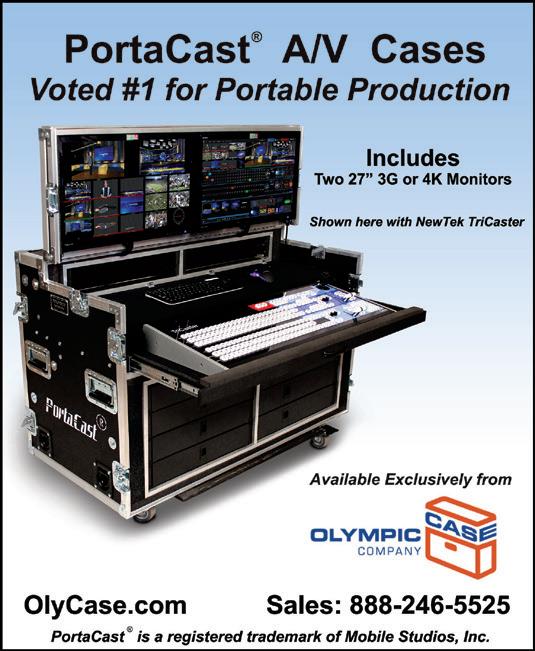




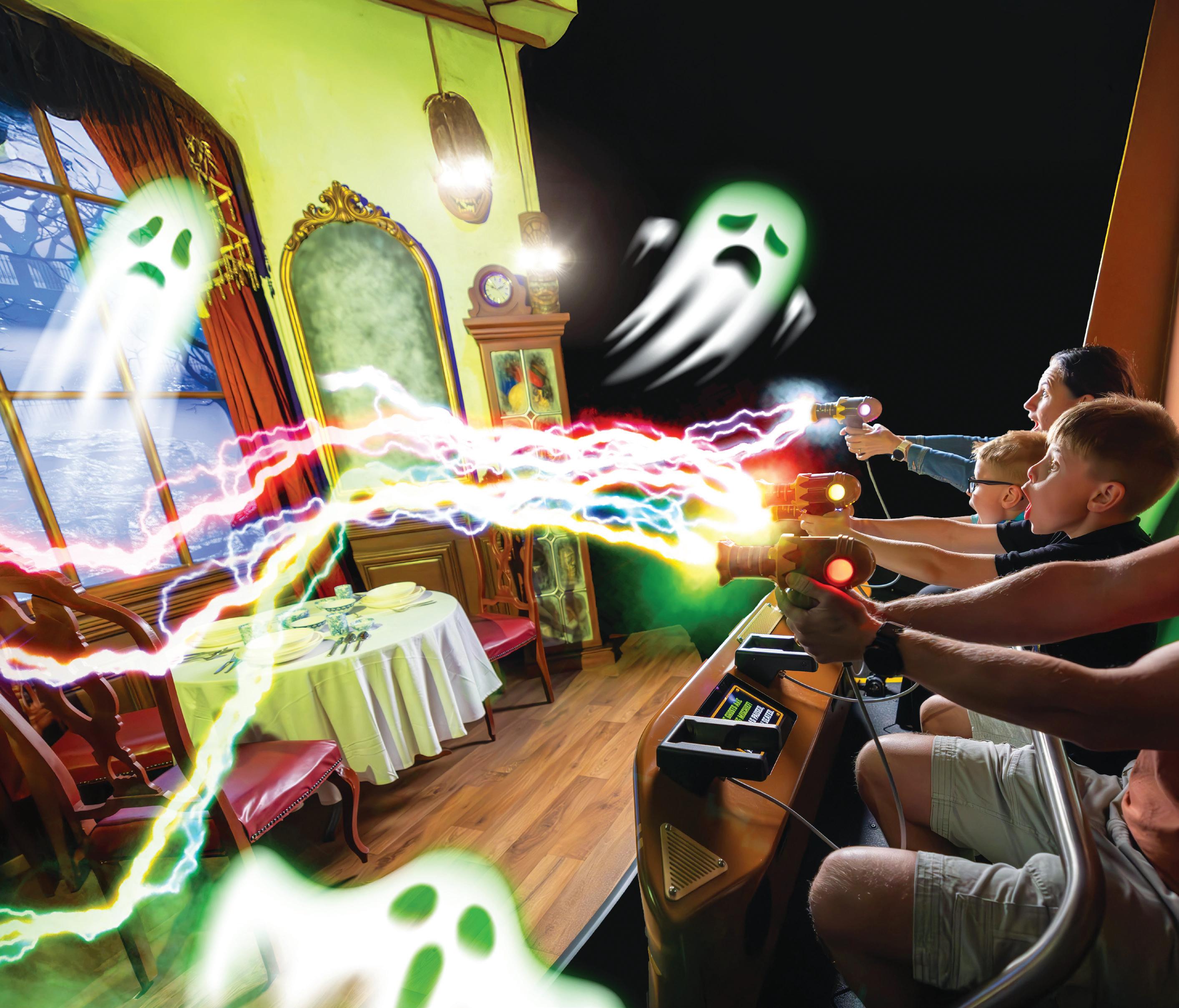
TChe Hippotizer MX Series Media Serverswere at work at WWE WrestleMania spectacular, pushing 4K live action and pre-made content across an ecosystem of LED screens and strips. The Netflix live-streamed, two-night event took place at the 65,000-capacity Allegiant Stadium in Paradise, Nevada. Upstaging once again supplied all the Hippotizer Media Servers, system design, and integration support between the design, content
hristie GS Series 1DLP laser projectors are delivering immersive visuals at Ghostly Manor, a new dark ride at Paultons Park in Hampshire, U.K. Designed and installed by Lagotronics Projects, the attraction combines physical sets, projection mapping, and interactive gameplay. The attraction uses a new ride format, Gameplay Theater, created by Mack Rides and Lagotronics Projects. Continuously rotating vehicles, each seating eight passengers back-to-back, reveal new environments with each
creation, programming, and interface with LED vendor NEP Screenworks teams. Eight Hippotizer Kasai MX Media Servers (distributed by ACT Entertainment) were the centerpiece workhorses, integrated with 12 Hippotizer Boreal+ MK2 and two Hippotizer Karst+ MK2 Media Servers. The 2U, 10-bit video playback, robust Kasai MX Media Servers allow users to run two 4Koutputs and offers Genlock for large surface displays that need more than one output.
turn in the tight, efficient space. Guests are equipped with Phantom Phasers, onboard interactive “blasters” that allow them to capture ghosts across eight unique scenes. With the vehicles located close to the screen, the team had to install projectors from a high angle to prevent casting shadows from the players, while avoiding warping and blending artifacts. Six Christie DWU1100-GS and two DWU1400-GS laser projectors equipped with 0.37-0.4:1 ultra short throw lenses project onto surfaces approximately 32x11.5 feet (10x3.5m).
